Northumberland & Scottish borders - 2025
We had often said we should visit Northumberland with it's numerous castles (notably Bamburgh) and rugged coastline and interesting wildlife, but it's such a long drive from our home in Hampshire that somewhere else had always got the vote.
In 2025, my dive club arranged a trip to St Abbs, just across the border in Scotland, but I decided not to go as I'd spent a lot on diving in 2024 and had already committed to a fairly expensive trip later in the year.
However, Mandy and I talked about and decided we could combine our long held desire to visit Northumberland with the diving and so we decided that 2025 would be the year we'd finally get there.
Journey and arrival in Berwick-Upon-Tweed
We travelled up a couple of days before and spent those days with Mandy's sister, Rachel and her husband, Tony, who live in Selby.
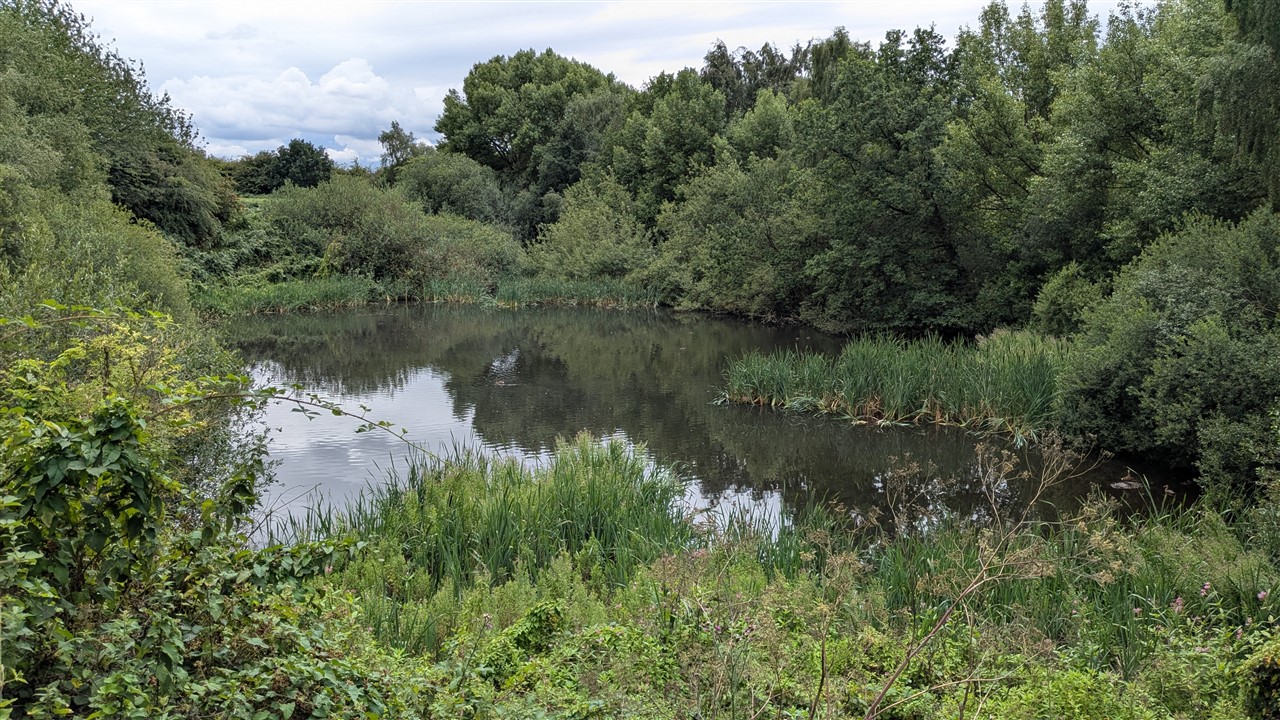
Our first stop, a nature reserve on the edge of Selby
Rachel has a couple of dogs, so we walked with her a few times and also explored some local sites that Mandy had heard were good for butterflies.
At one of these sites, just outside Selby, we got talking to a man from the Yorkshire Wildlife Trust and noticed that Whitby wasn't that far away.
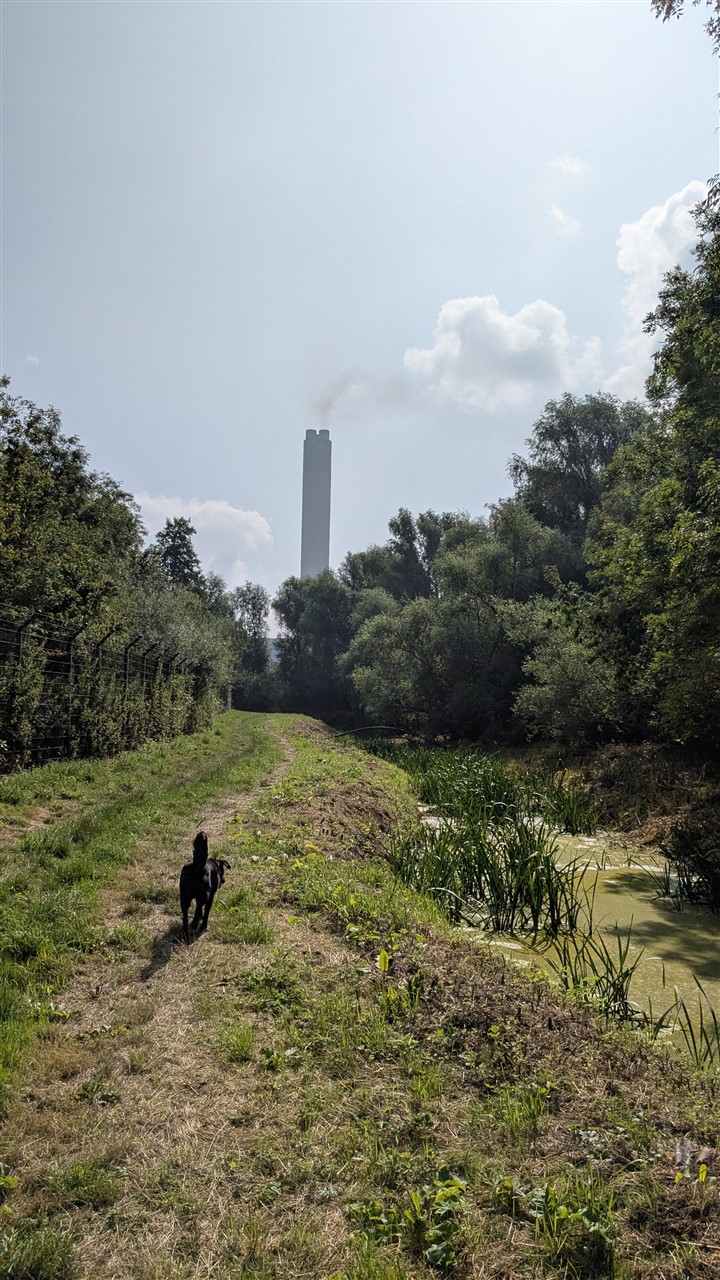
Walking in the shadow of the Drax power station was surprisingly pleasant - A moment after this photo, a deer was spotted!
Rachel and Tony said it was a good place to visit and I'd always wanted to visit the Abbey (famous from the Dracula story), so we decided to detour via Whitby on our way up to Berwick-Upon-Tweed, where we were staying.
We got to Whitby fairly early and parked in the park-and-ride, which then took us on a bus ride down to the railway station, on the edge of the harbour.
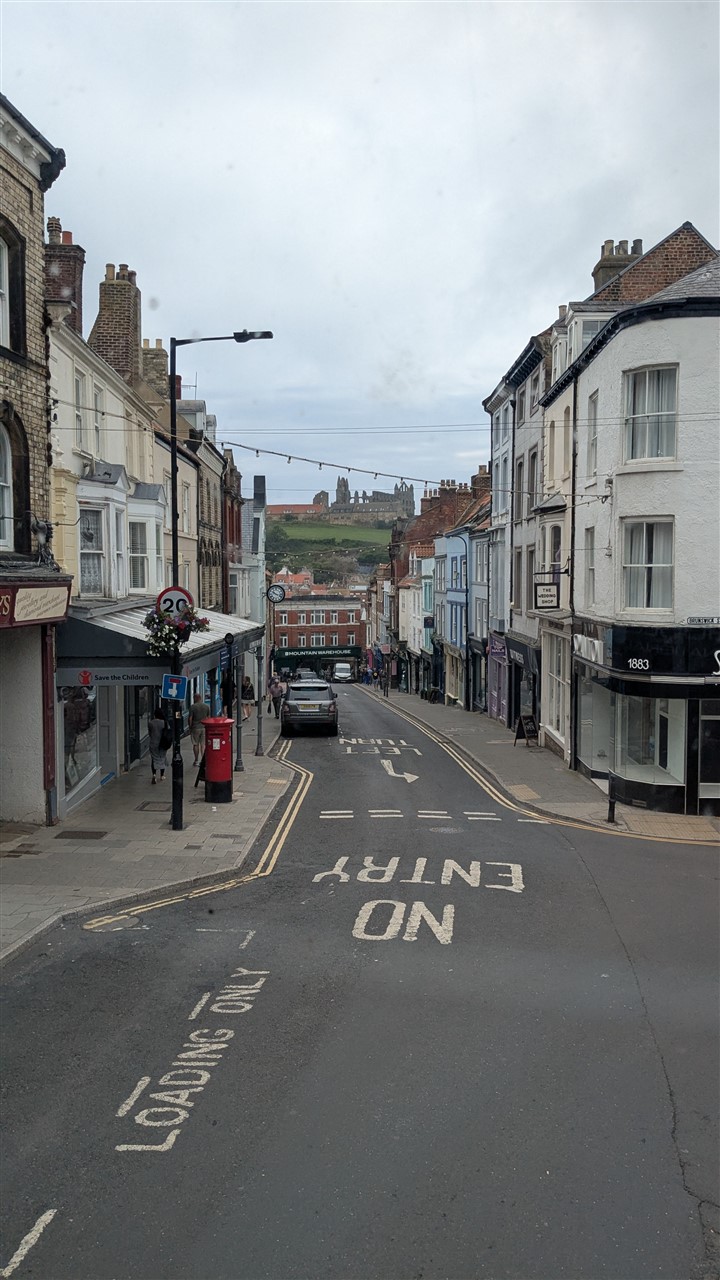
Our first sight of Whitby Abbey from the bus
We walked across the harbour bridge and, following signs for the Abbey, walked up through the old town.
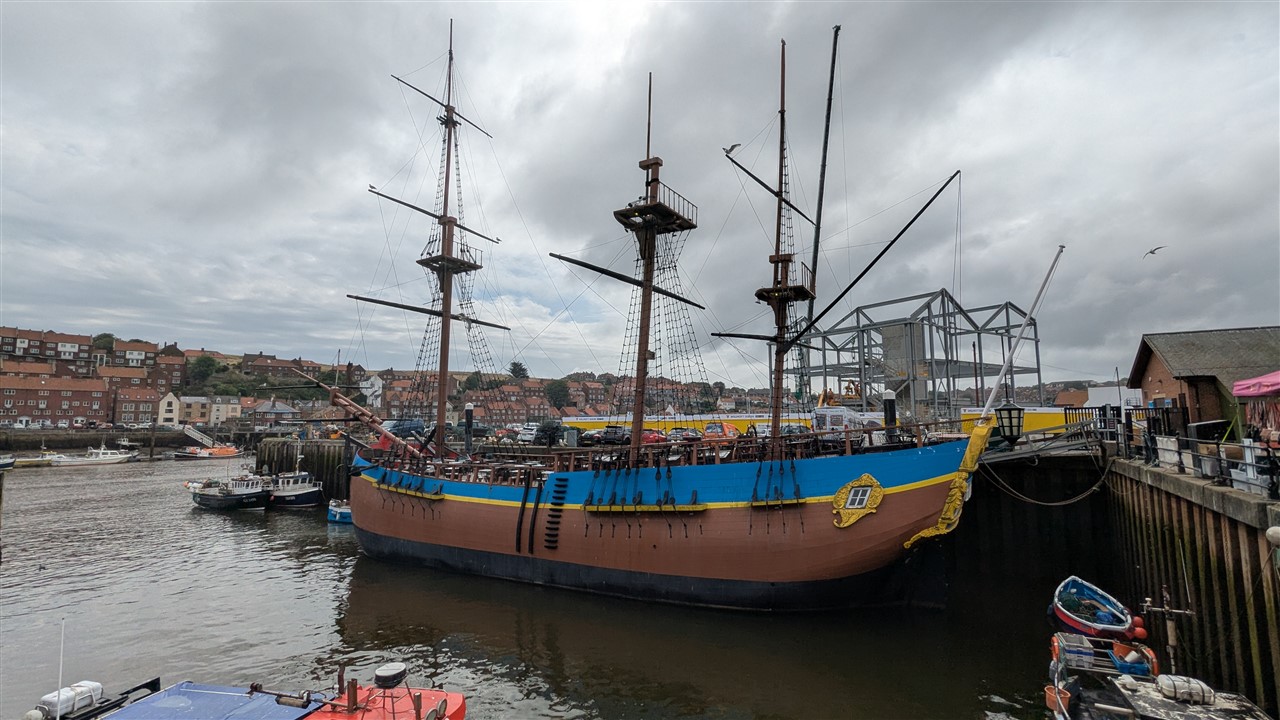
Ship in the harbour appears to be a restaurant
After buying an ice cream, we found ourselves at the steep staircase that leads up to the Abbey.
It's not an especially long flight of stairs, but, like all of Whitby at the start of the school holidays, it was quite busy.
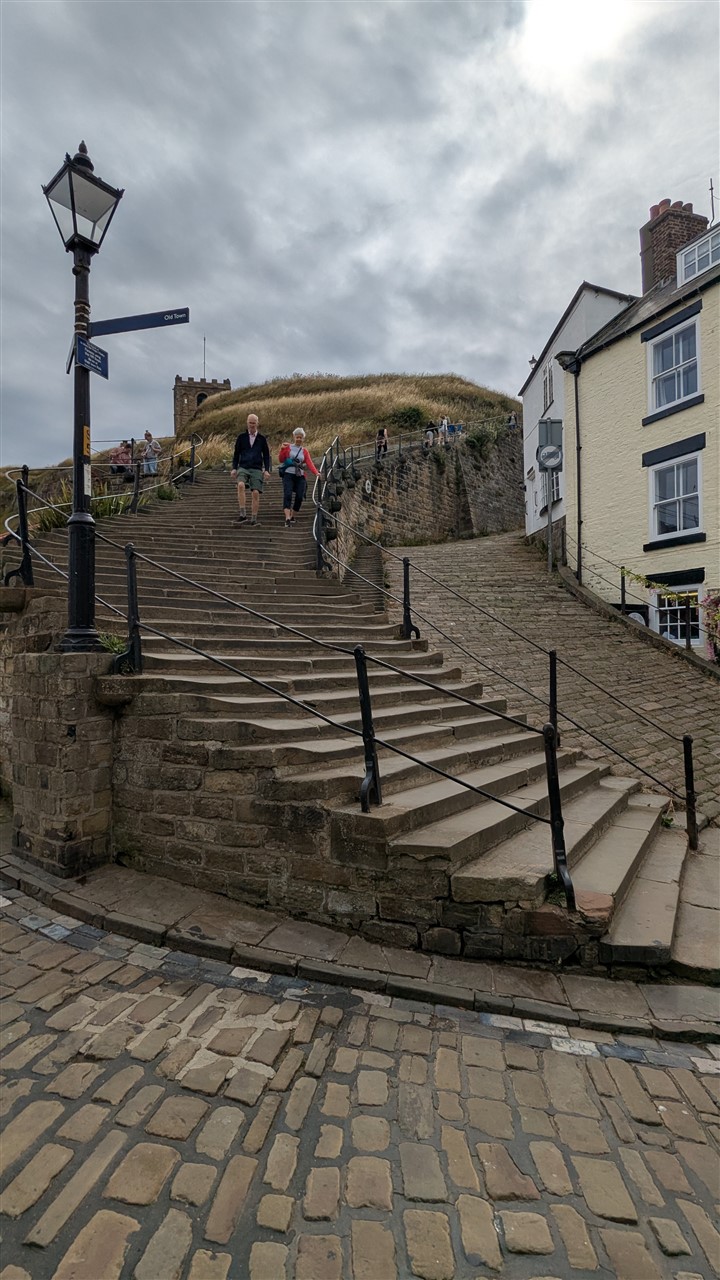
The steep steps up to the abbey begin
At the top we could see the Abbey ruins behind quite a tall wall. We had a look and saw that it was going to cost £17.50 each to go in, so we decided to walk around the wall and see if we could find a place that afforded a better view.
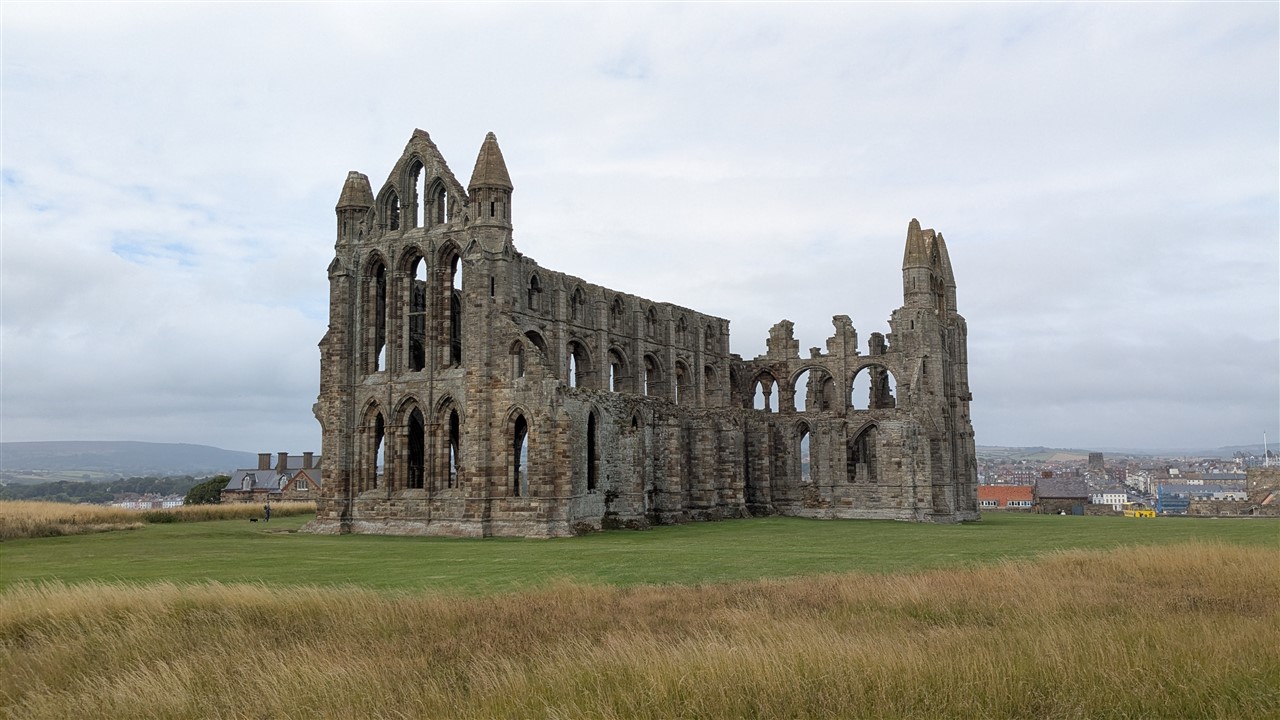
Whitby Abbey and the moors beyond
We found a spot and took a couple of photographs and then popped into the Whitby Brewery, where we tried a beer and bought a couple, including a Stout and a Weissbier.
We walked back to the entrance to the Abbey and decided we would go in, but after a bit of discussion and looking at the places available in Northumberland, we took out an annual membership to English Heritage, which was being offered at a 25% discount on the day. Whether we'd cover the cost would remain to be seen, but it was valid for a whole year and we know of places locally to visit, so we took a chance.
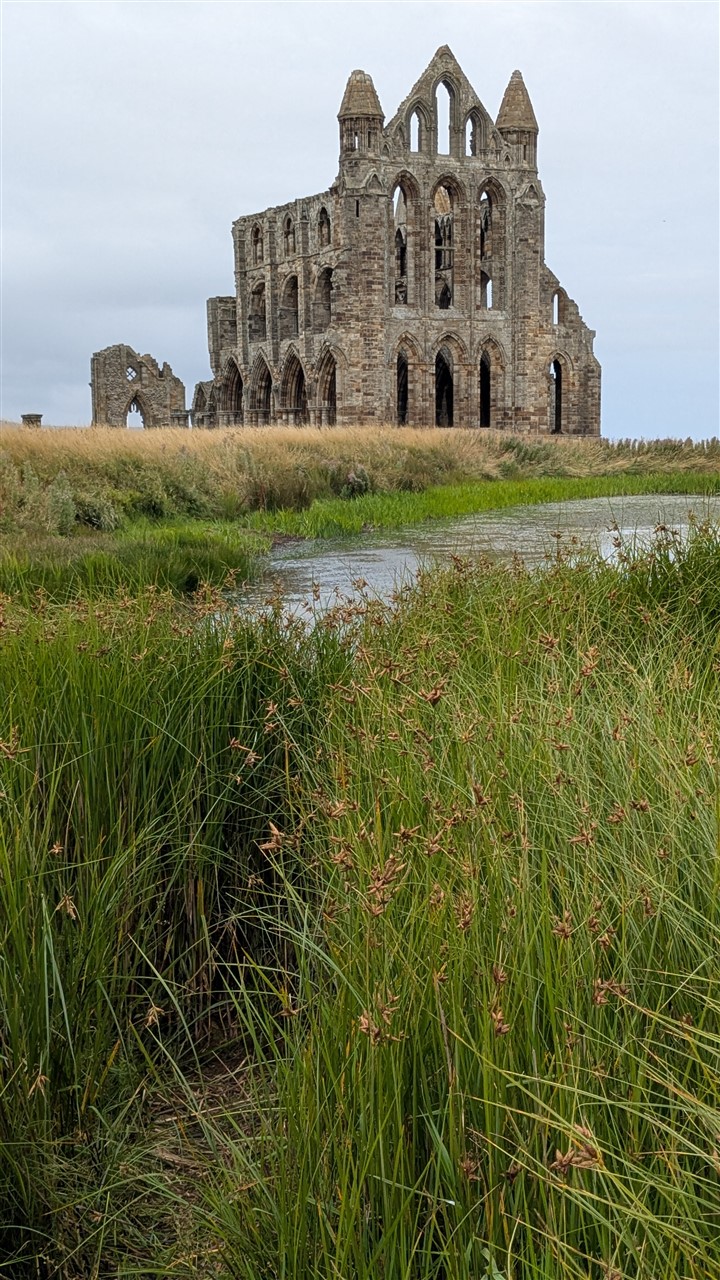
The Abbey and it's pond
We took the self-guided audio guides and wandered around the quite impressive ruins. As with most abbeys, it's just the remains of a, once glorious, building, but it was still impressive and easy to imagine just how amazing it may have been in its heyday.
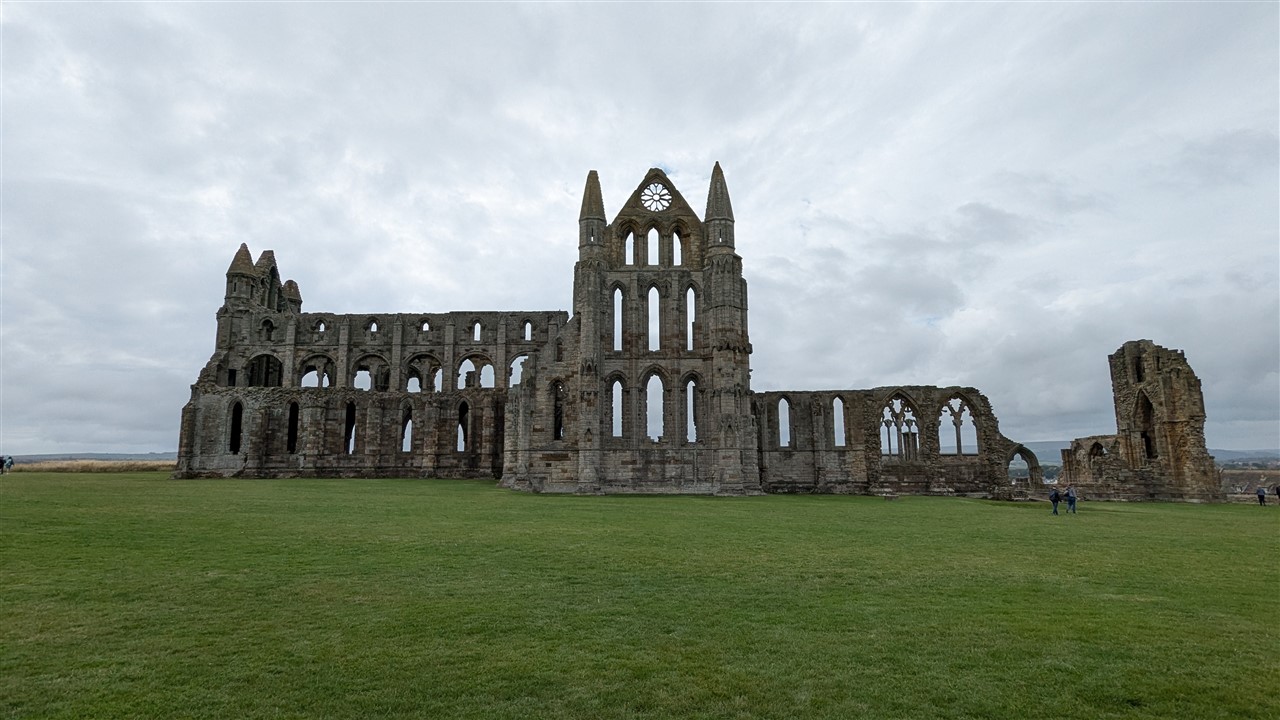
You get a sense of how impressive the building must have been
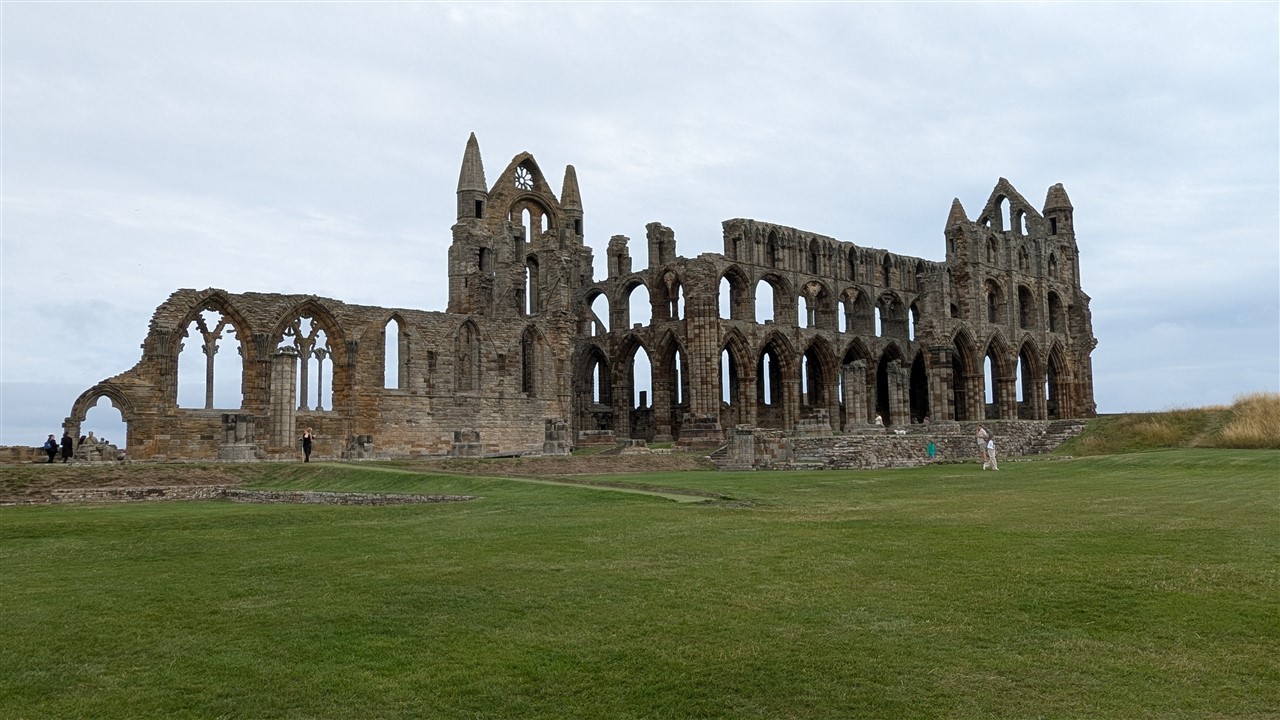
Another angle of Whitby Abbey
We ate a sandwich we'd brought with us in the grounds and then headed back down to the town, this time taking the little lane alongside the steps, which is even steeper!
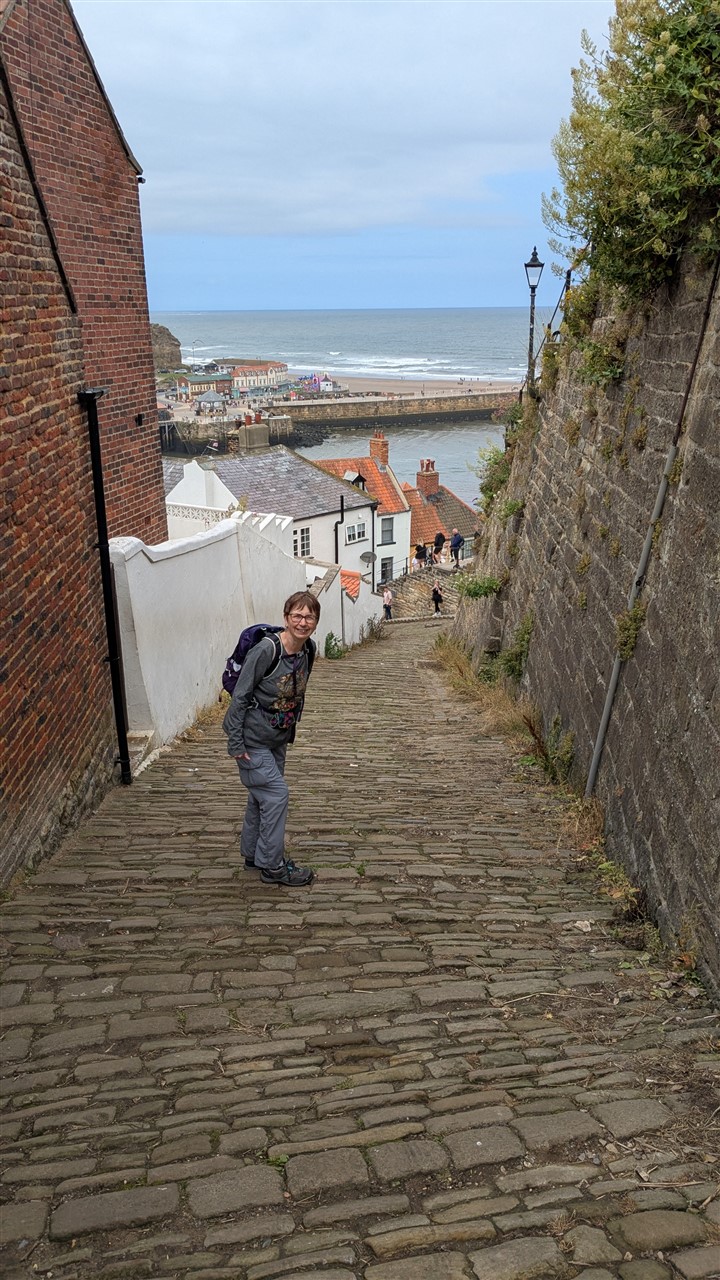
The lane down is steeper than the steps!
We made our way back to the Park-and-Ride and set off across the Yorkshire moors to rejoin the A1 after the Tyne Tunnel, north of Newcastle.
The final stretch of our journey took us along the, mostly single carriageway, A1 to Berwick-Upon-Tweed.
We drove across the bridge over the Tweed, through the town and up to the railway station, where we turned right and then left into Bell Tower Place, where we found the cozy little bungalow we were staying in for the week.
After stocking up with provisions for a few days, we took a walk along the Bell Tower park, which forms part of the defensive walls of Berwick.
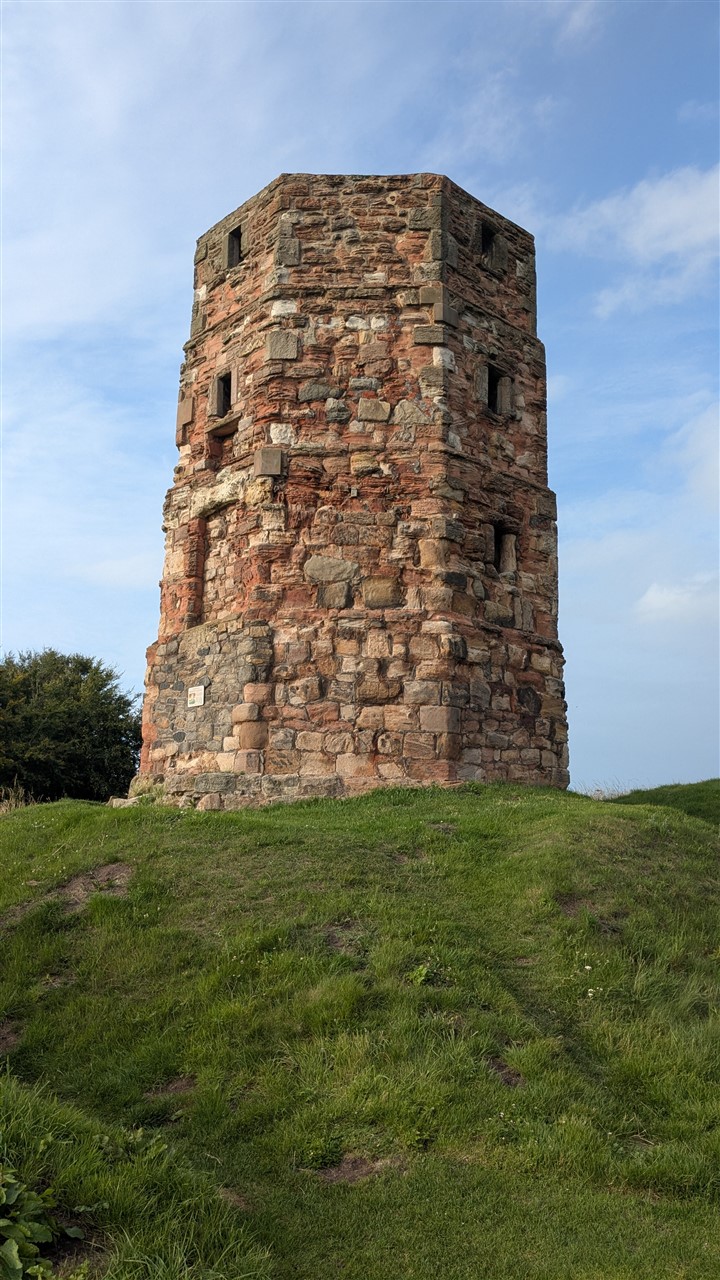
The 16th century Bell Tower, a few hundred yards from our home for the week.
The bell tower itself dates back to the 1500s and at the end of the park we saw the remains of the Tudor castle which is, apparently, very similar to the castle at Portland Dorset.
Bamburgh and Dunstanburgh Castles
Probably the main reason for us wanting to visit Northumberland was to visit the impressive Bamburgh castle, which featured in the TV series "The Last Kingdom" (amongst other TV and film projects), so we booked our ticket and setout early to arrive in Bamburgh village in time to be there when the castle opened.
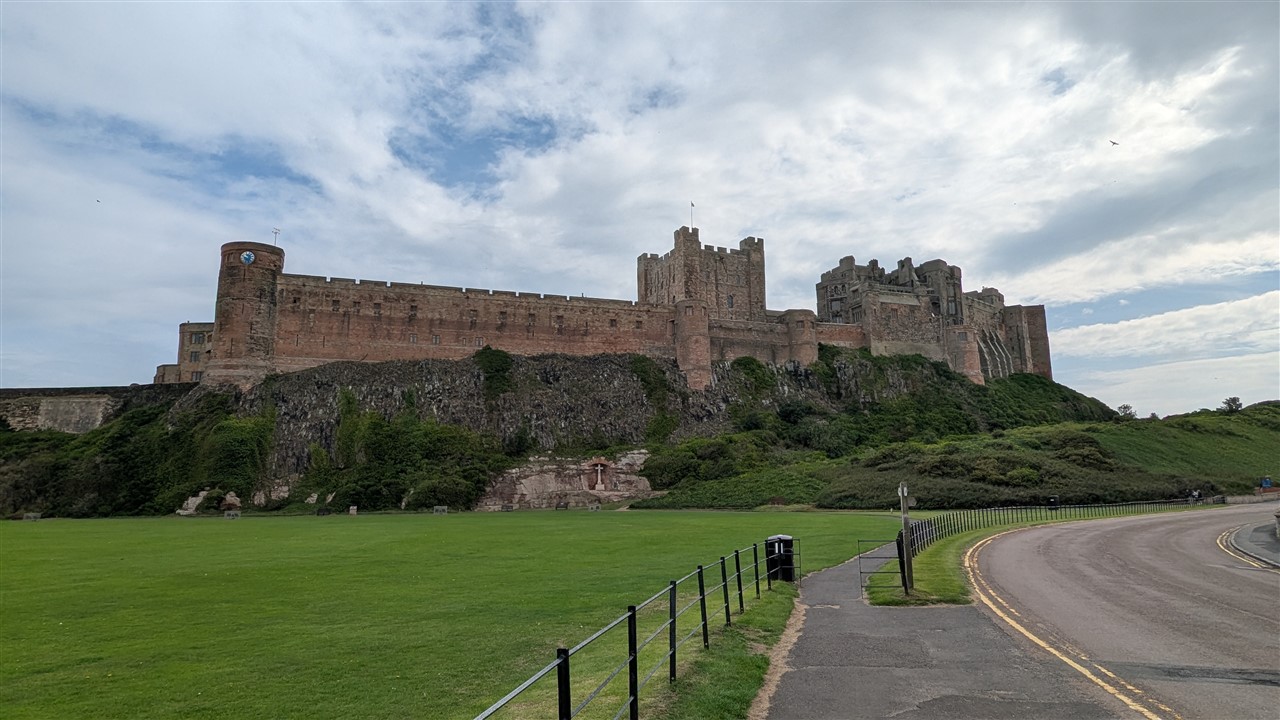
Bamburgh is an impressive castle, still in excellent condition
We had booked a ticket the day before and arrived about 9:30, half an hour before the castle opened to the public, so we parked at the far end of the village and walked down to the castle, climbing up a winding footpath on a slope that led to the entrance to the castle.
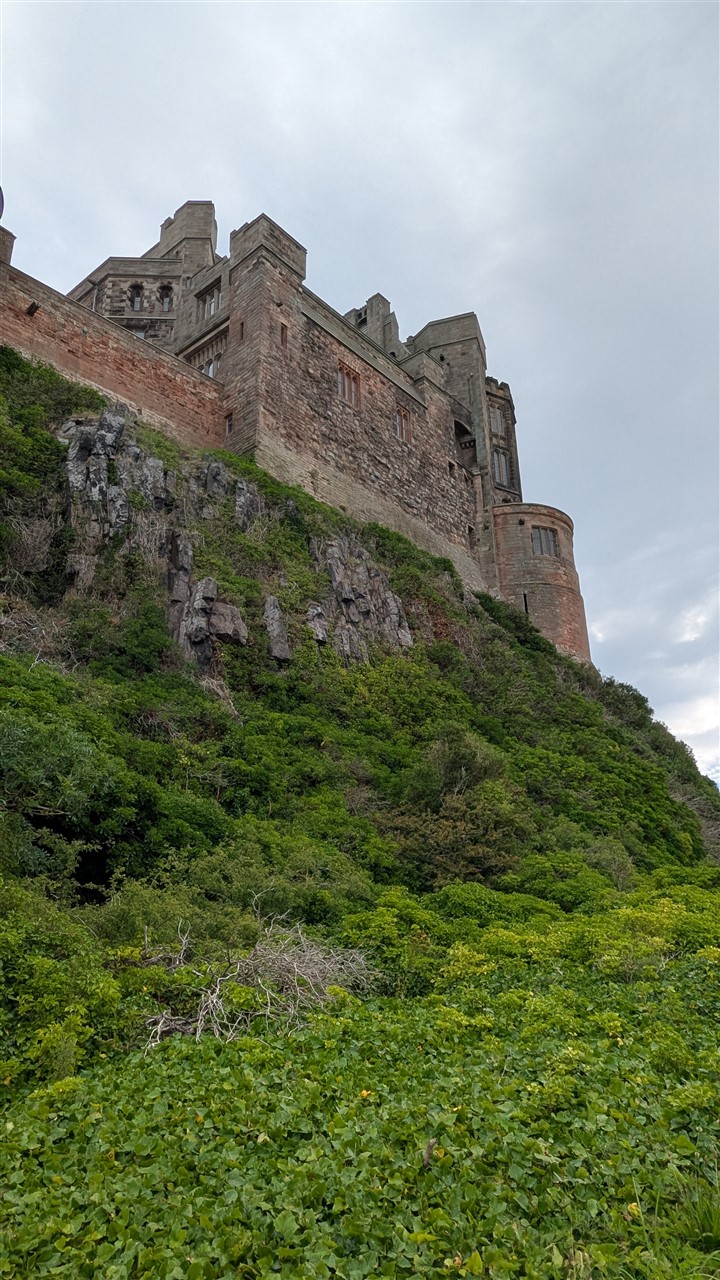
We climbed a footpath up to the entrance
We arrived a minute or two before it opened, along with a handful of others and were quickly in.
We wandered into the large open space within the walls, walking to the far end of the very large castle.
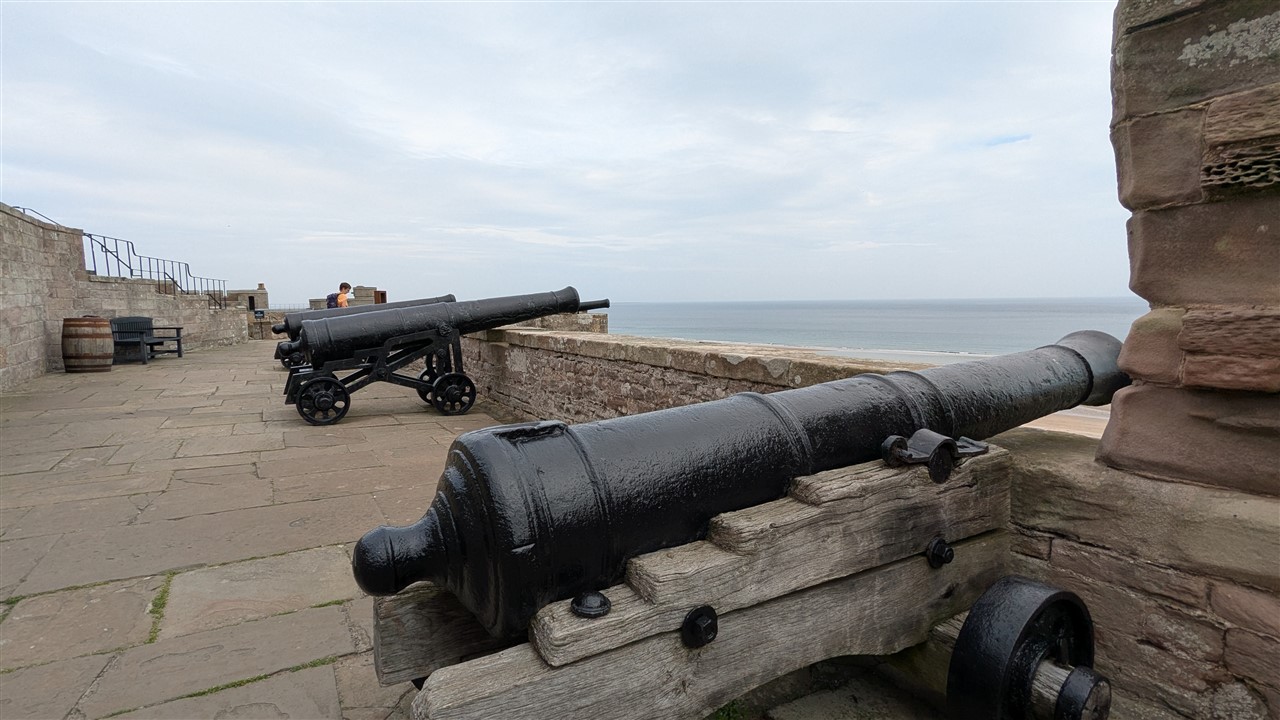
The castle defended from sea and land
I popped into the Armstrong business museum (quite interesting, covering aircraft, engineering and various other industries) while Mandy chased, in vain, a Wall Brown butterfly.
We wandered up to the entrance to the staterooms, passing through one after the other.
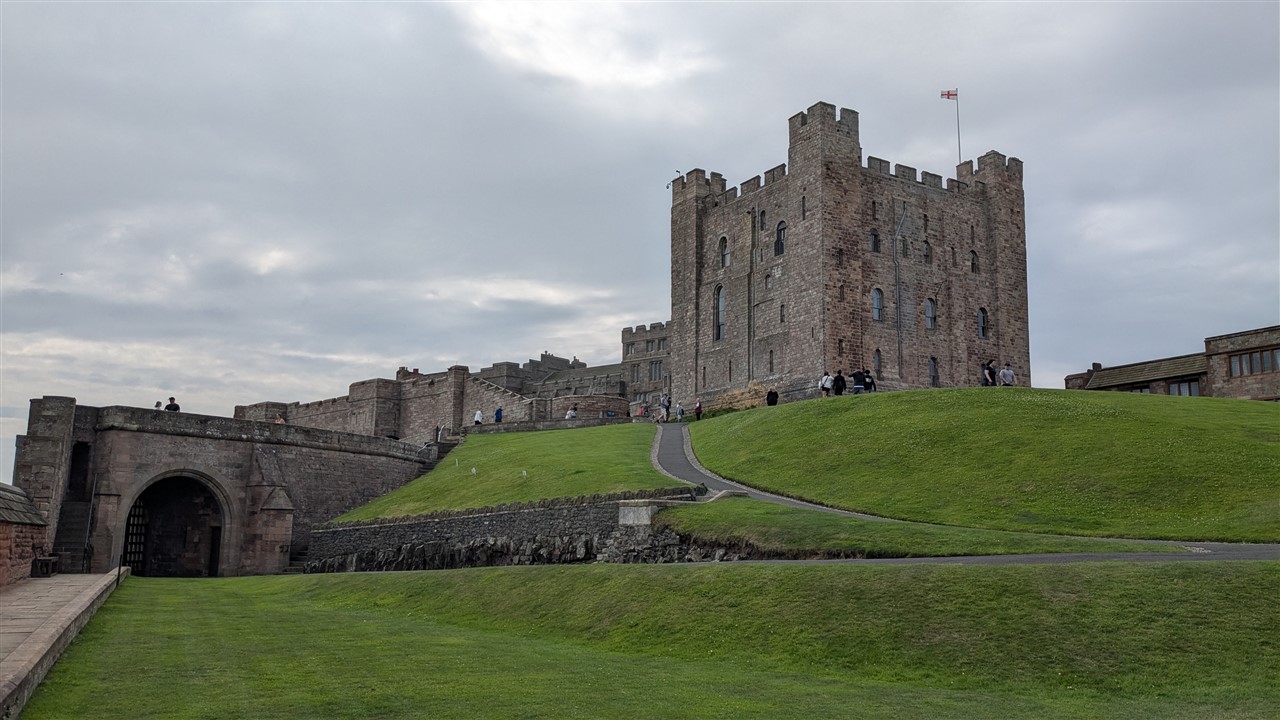
One of the entrances, to the left, and the keep to the right
Being a castle that has remained in use for many years, it feels more like a stately home (I guess it is one!) than a medieval castle, having been updated over the centuries both in terms of decor and structure to provide comfort for those living there. Nice though it would be to visit a castle that still felt like a living medieval one, would you want to live in such a place?
Mandy had a sit in King Alfred's Wessex Throne (from The Last Kingdom) and there were a few costumes and props on display in one especially impressive hall.
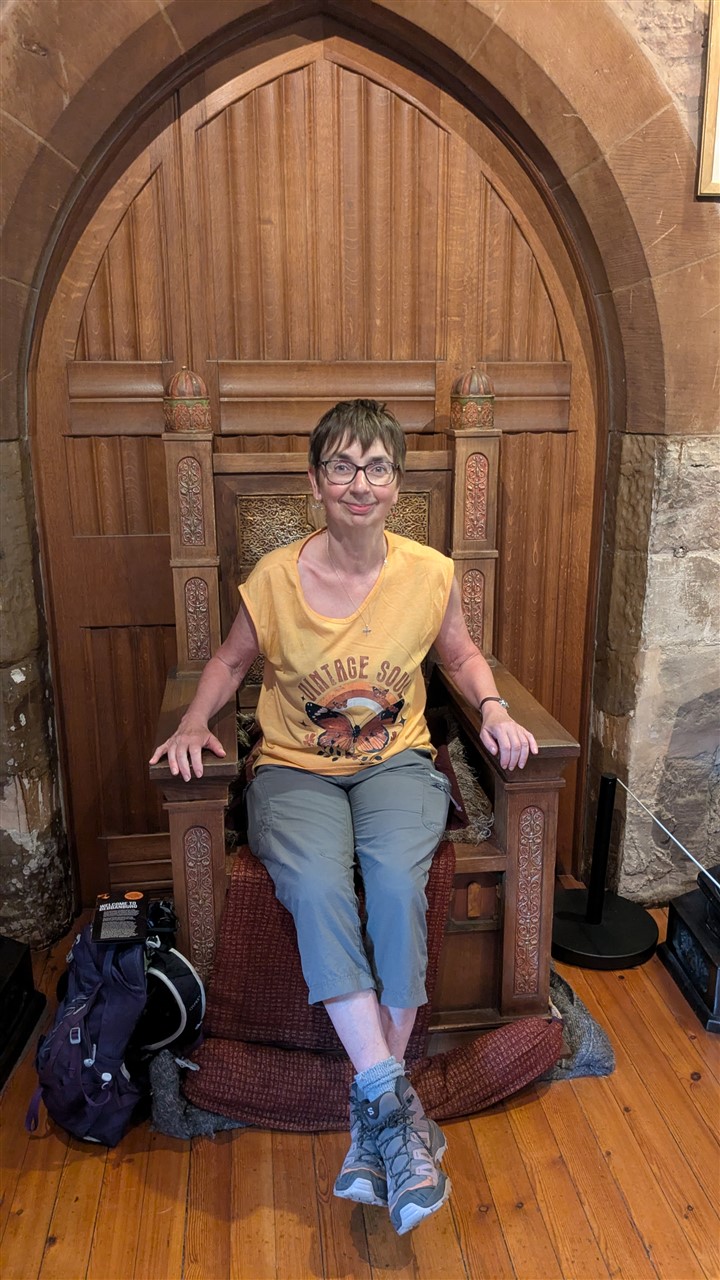
Mandy tries out King Alfred's Throne
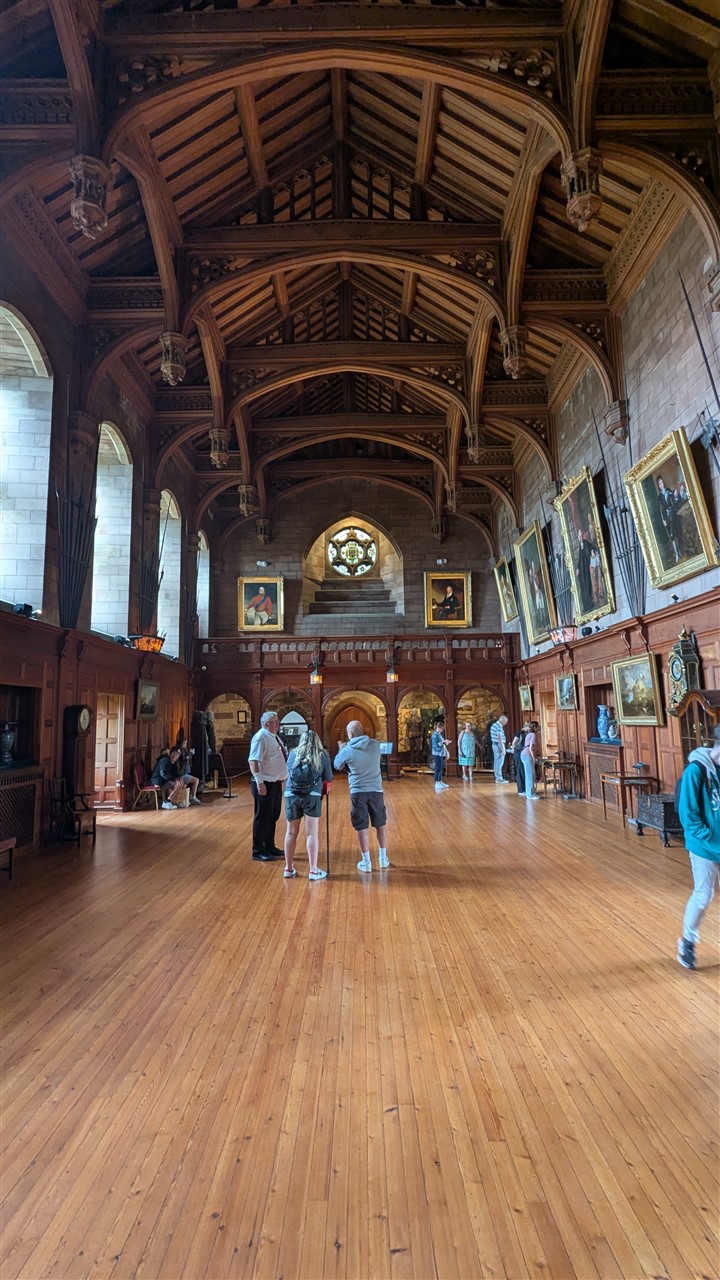
The main hall
There were the usual collections of paintings, statues and porcelain that such places seem to have in abundance and overall it was an interesting place to visit, although I did feel a little sad it didn't have a more medieval feel to it (unreasonable, I know).
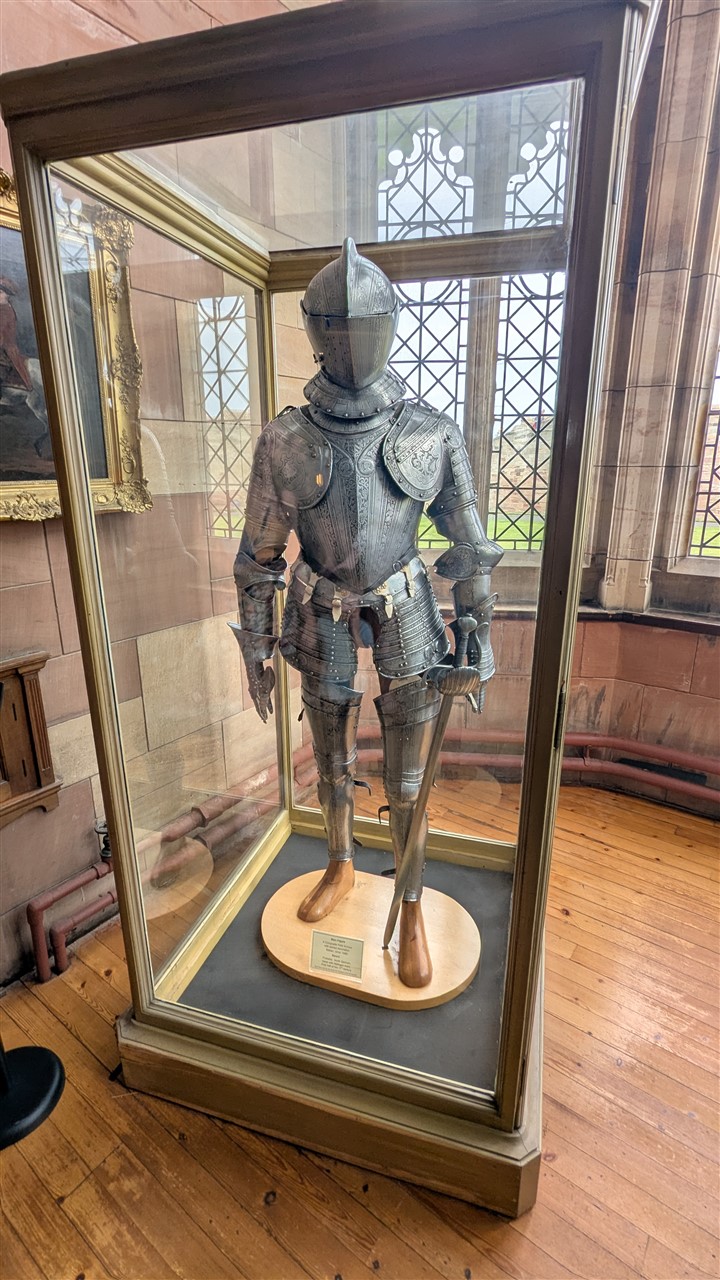
Suits of armour and weapons are on show here
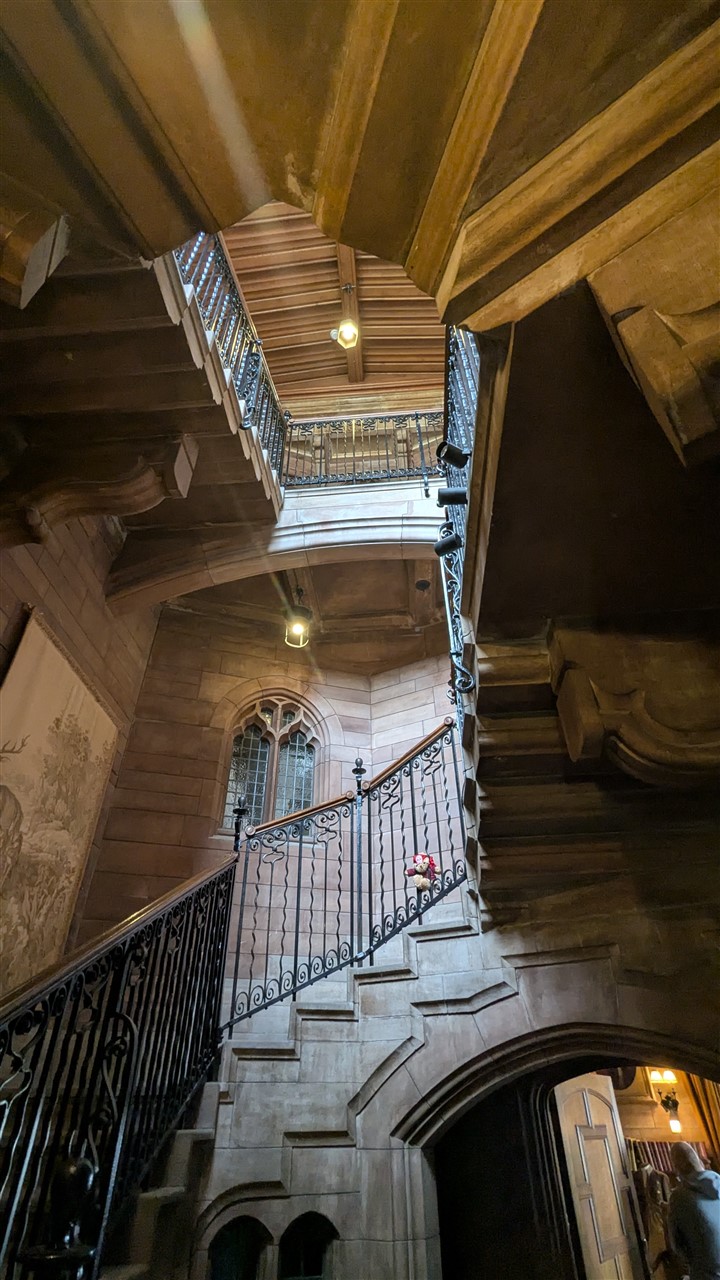
One of the many staircases
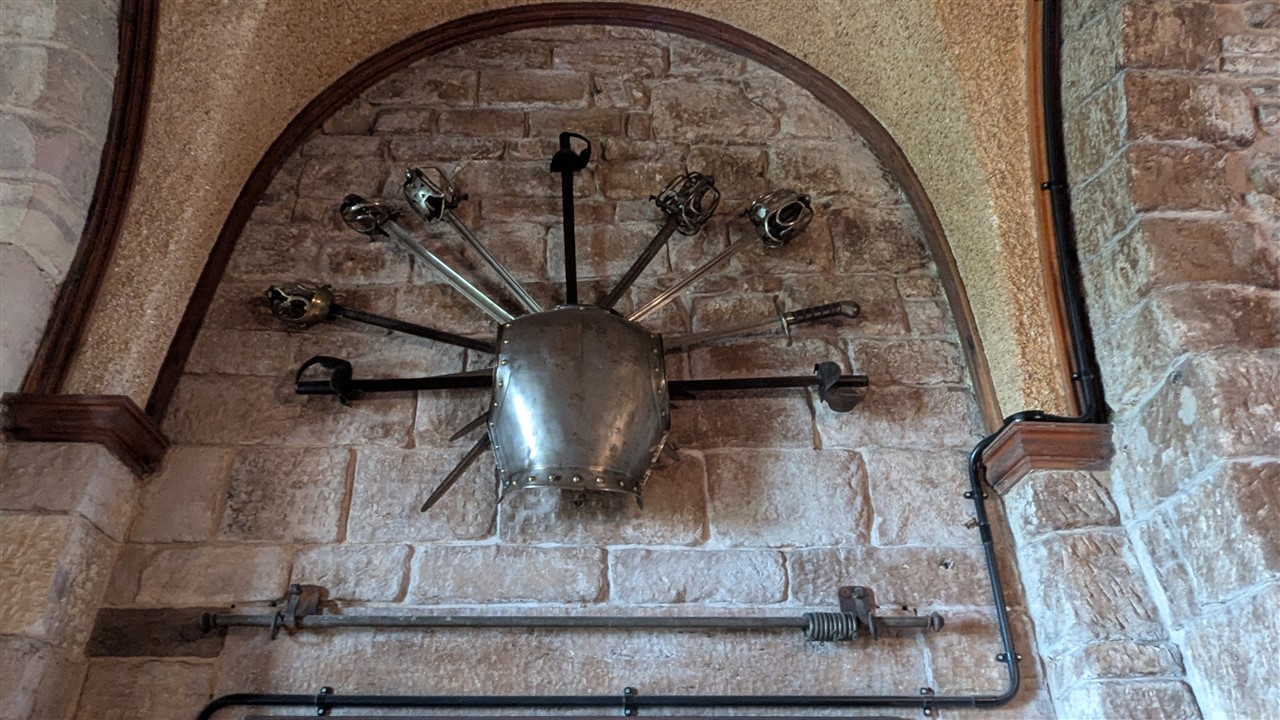
This tower held a display of arms of the local yeomanry
Worth the visit? Yes.
After exploring the castle (took us a couple of hours), we wandered through the sand dunes and onto the beach, which afforded some great views back at the castle and gave me my first dive of the trip, max depth 0.04M!
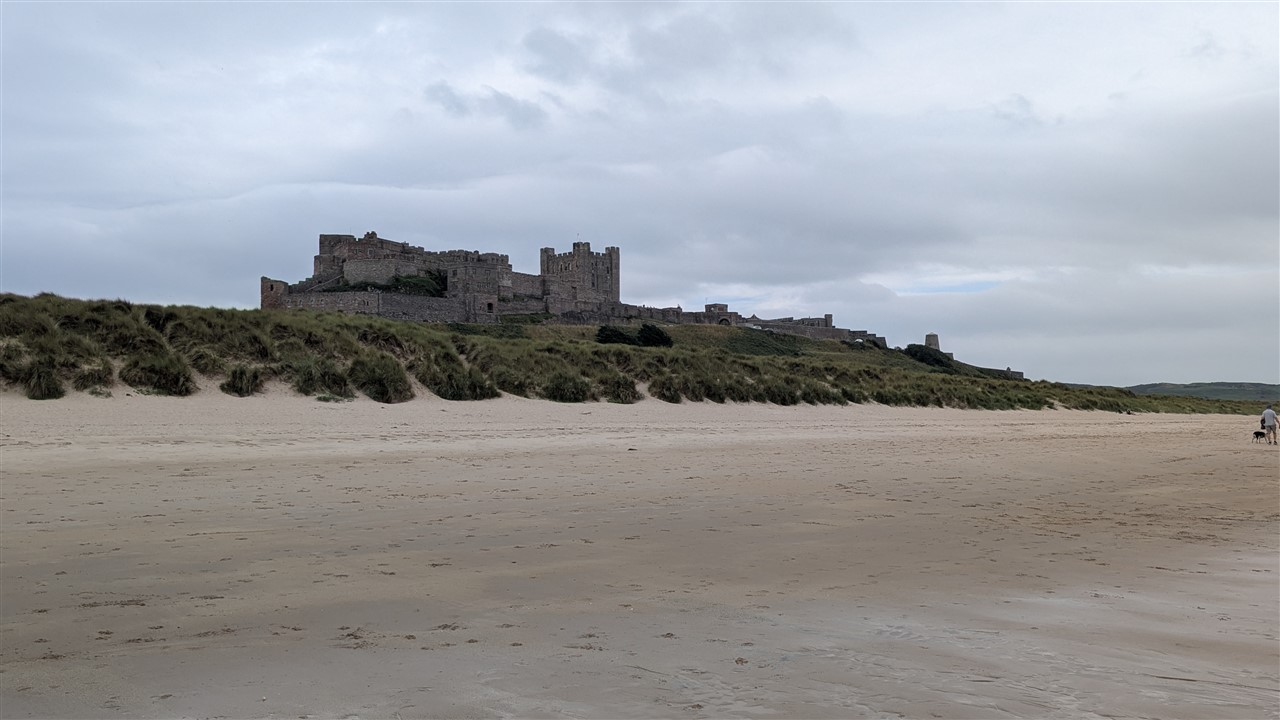
The castle from the sea
We ate a packed lunch in the dunes and then walked back through the village to collect the car and set off for our next location, Dunstanburgh Castle.
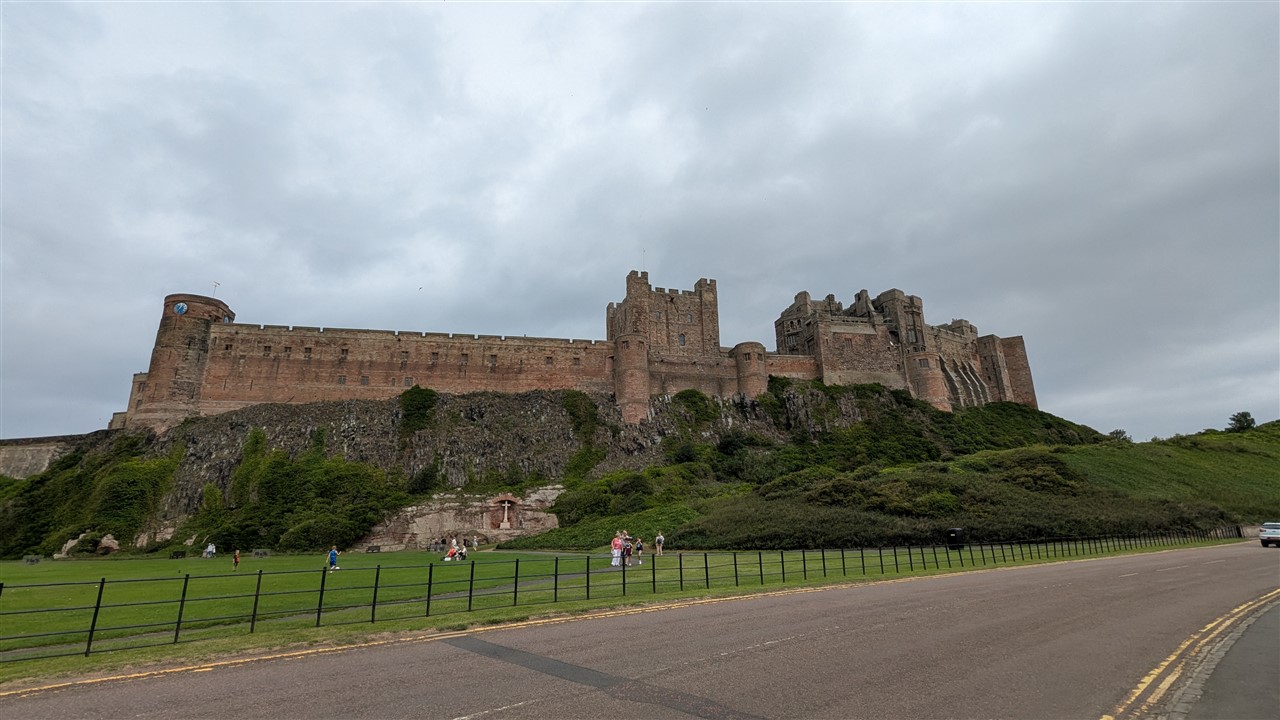
Finally, a little sunlight to show the castle's stone off properly
If Bamburgh is too well kept to feel like an 'authentic' castle experience, Dunstanburgh is too ruined to truly reflect what life in a castle was when it was new.
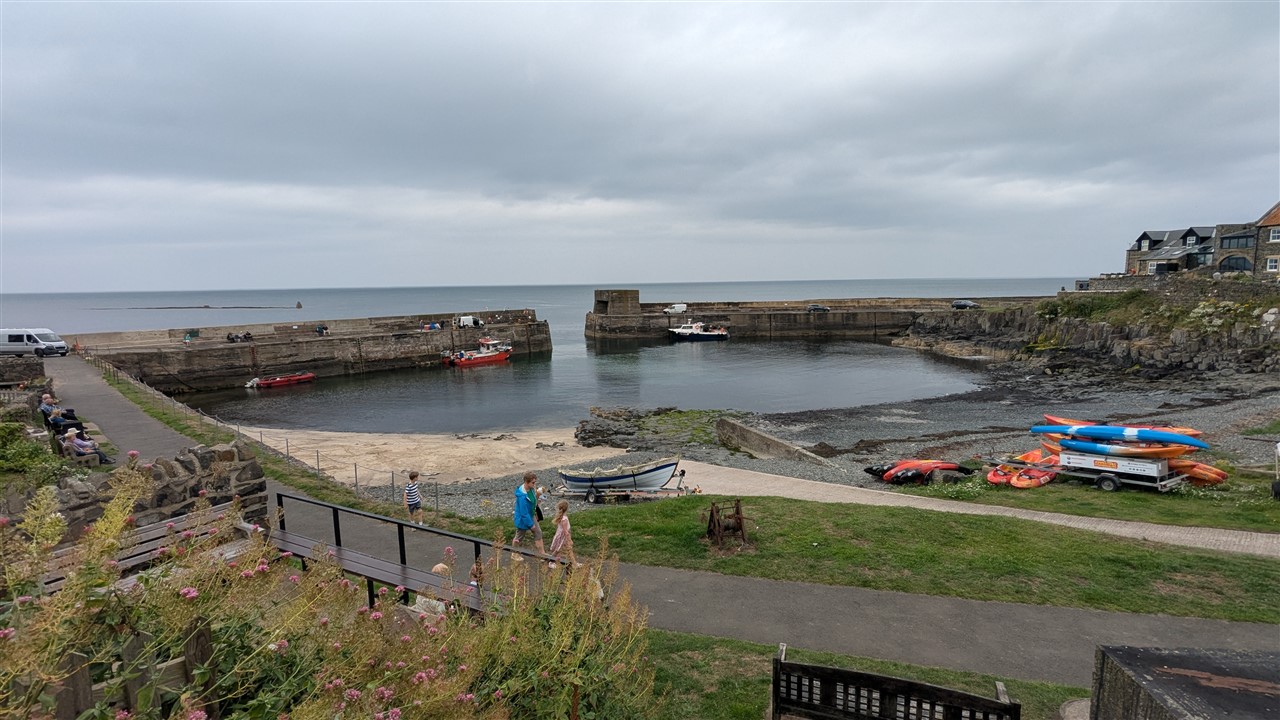
Craster Harbour
We parked near a small harbour, in Craster, and then set off along the coast towards the castle. At first we felt we had plenty of time to reach the castle, explore it and get back in 2 hours, but as we walked the castle got bigger, but seemingly no closer!
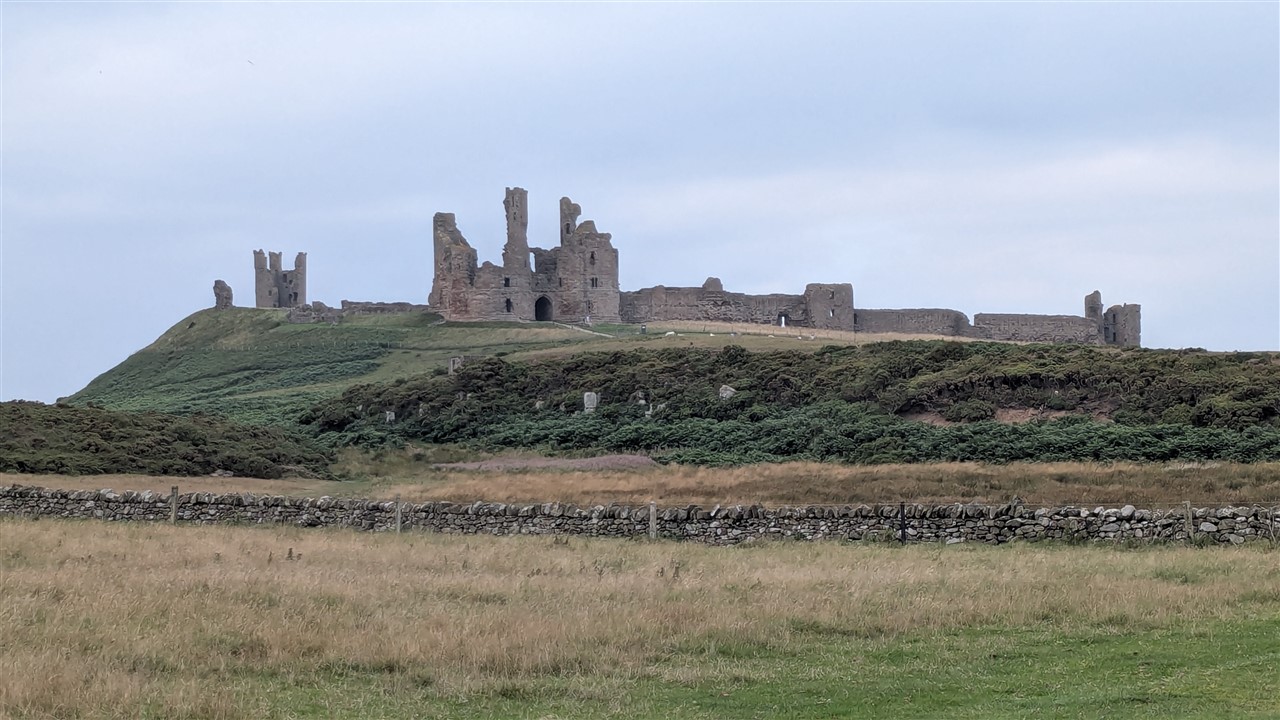
Dunstanburgh castle never seems to get any closer!
Eventually we reached the entrance, waved our new English Heritage membership card and went in.
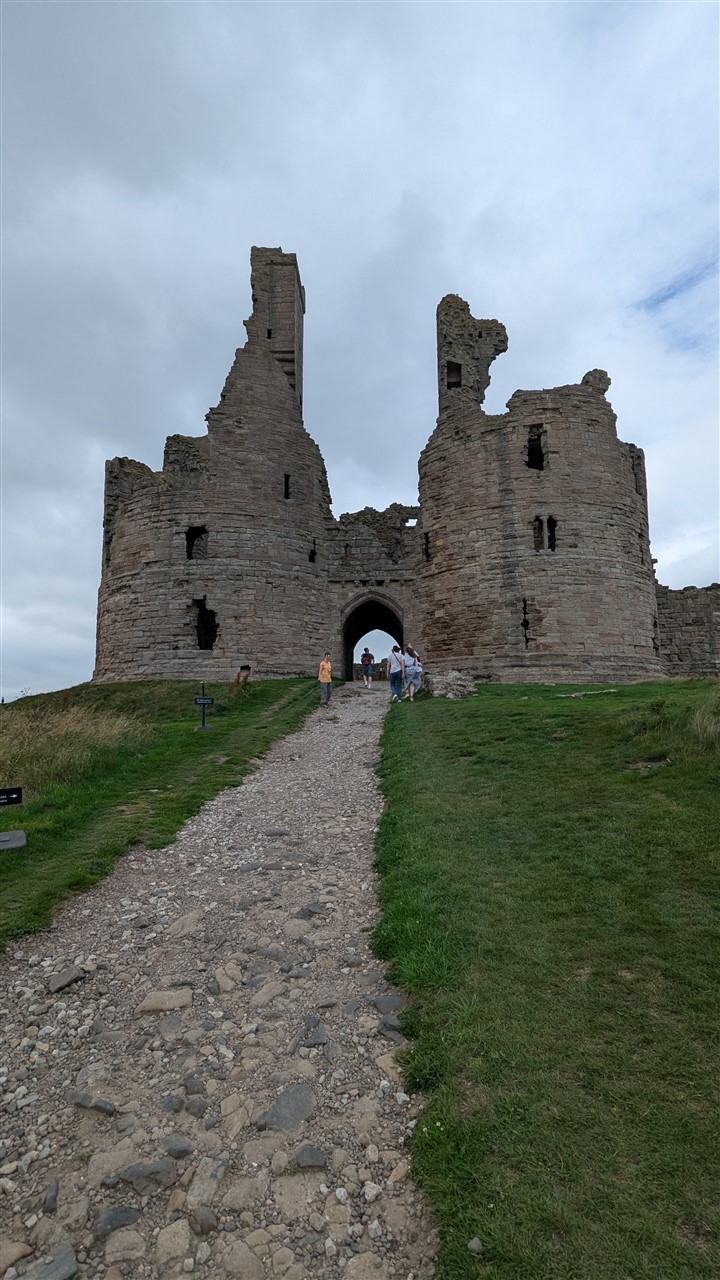
Finally! The gateway.
Lucikly, given our restrictions on time, there's not as much to explore as the impressive outer walls would suggest at Dunstanburgh.
The main gate tower is still, relatively, intact, but the rest is mostly just an outer wall.
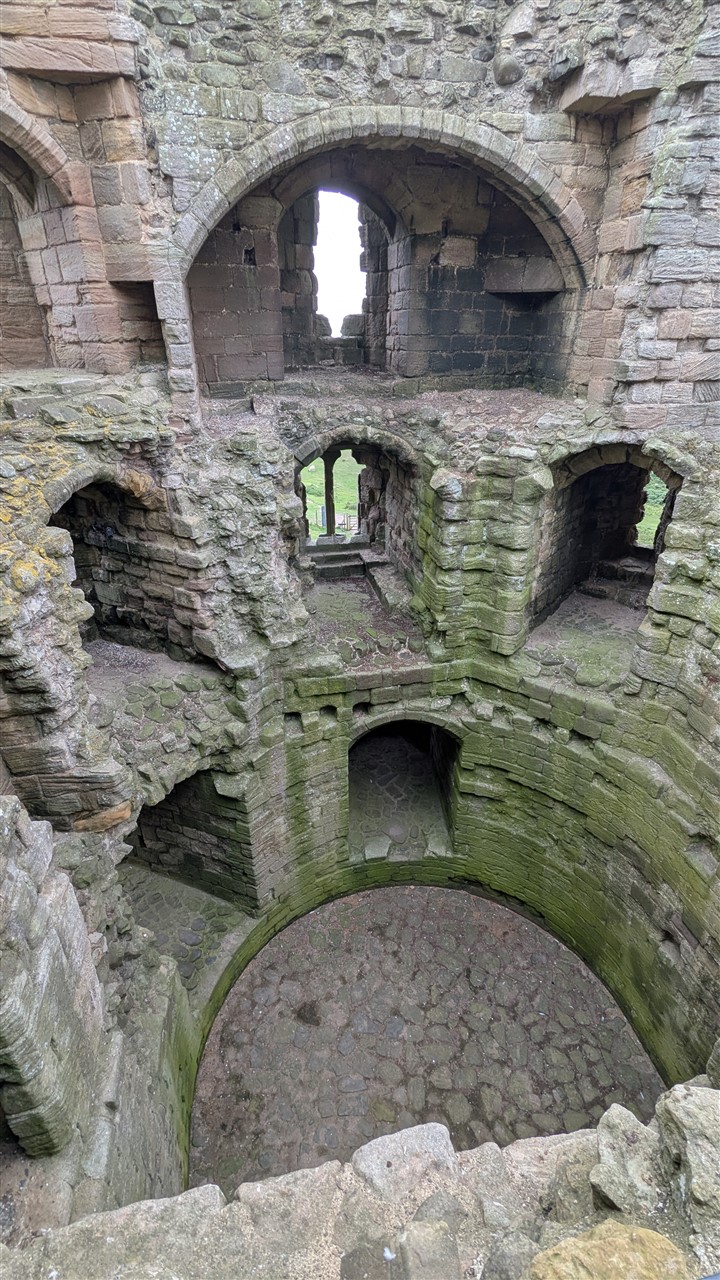
Inside the gatehouse tower
Along the cliff edge we were able to look down and see various sea birds and the wall encloses an impressive area, which presumably was once full of wooden buildings, now long lost.
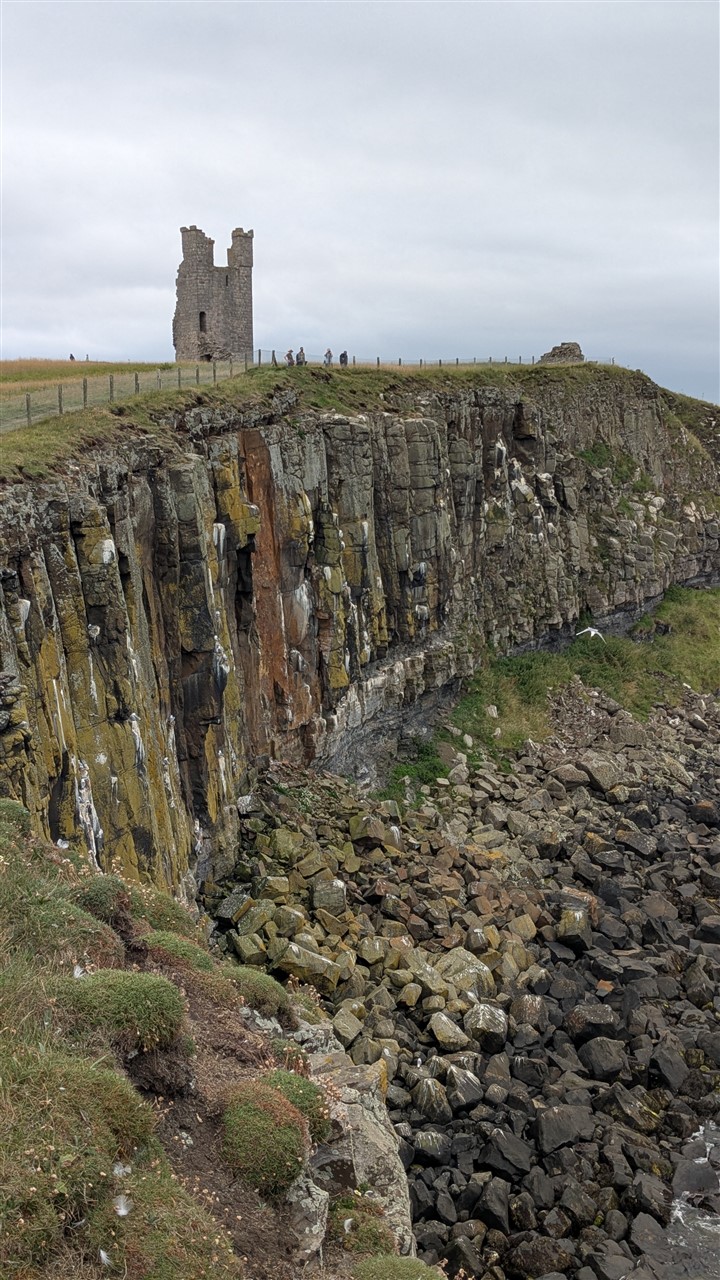
Seabirds find a safe home on the cliffs
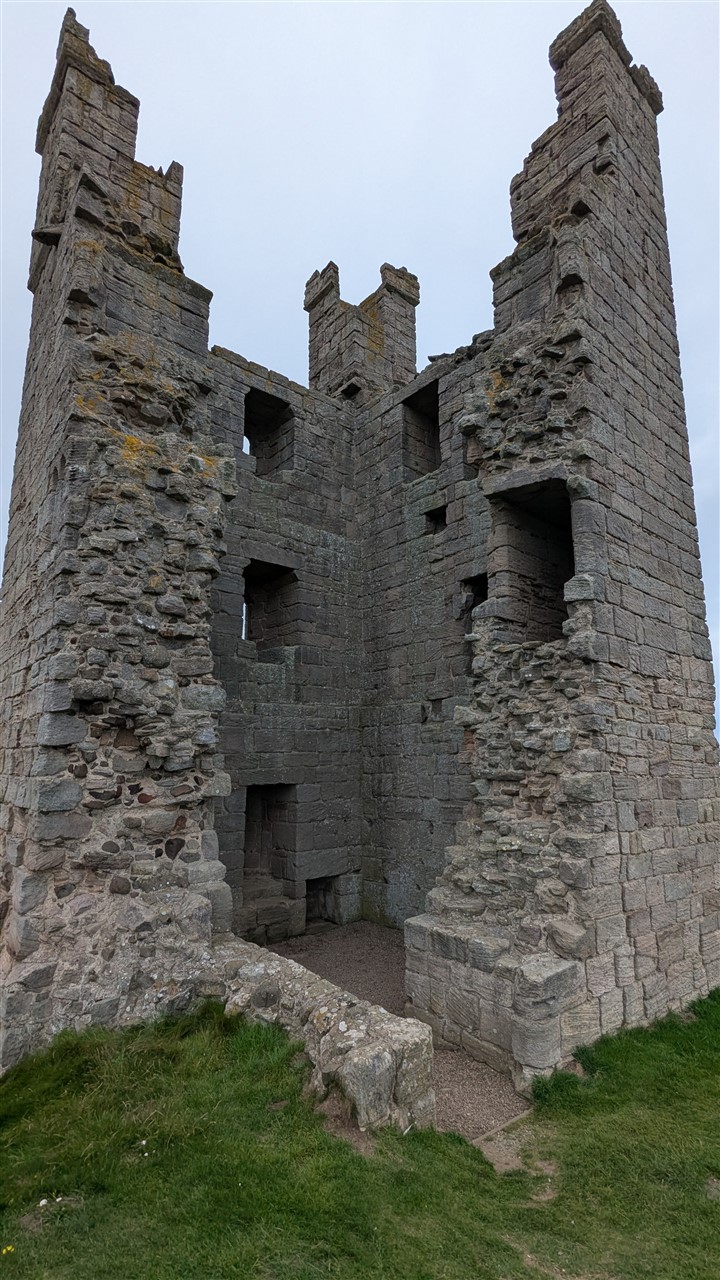
Another of the castle's towers
So, too extremes of the castle experience in one day, it'd been a good start.
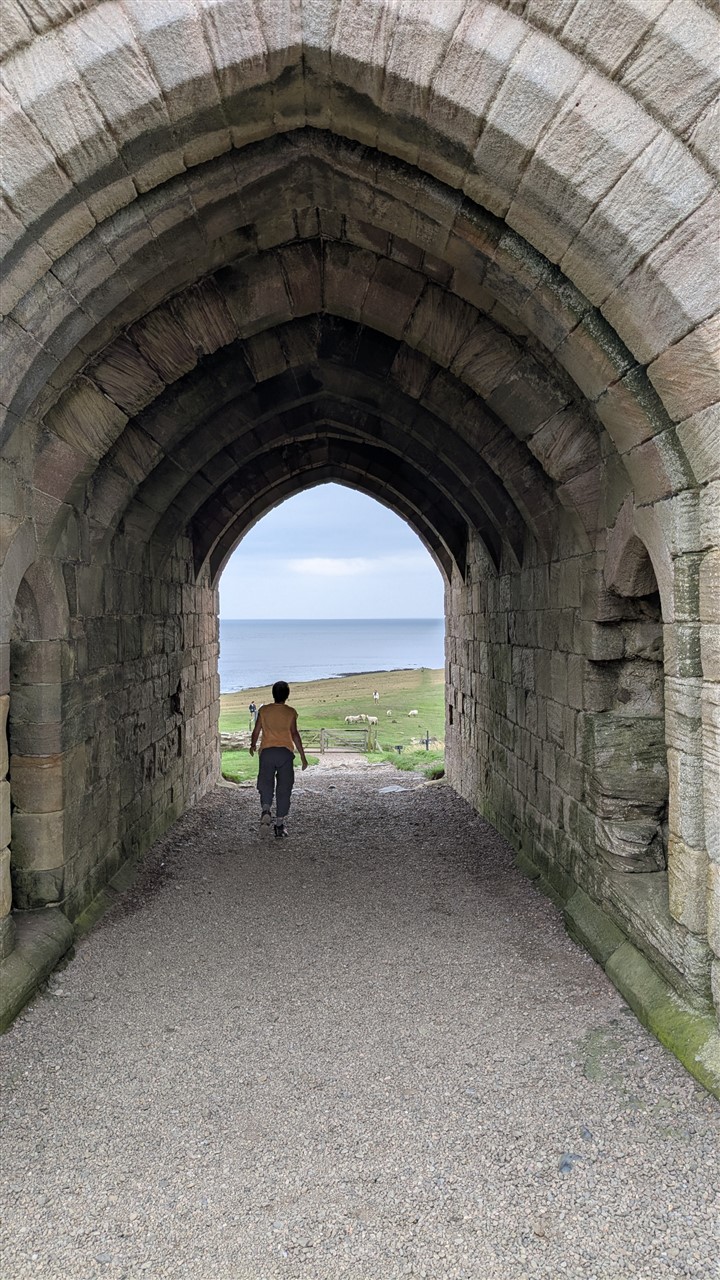
The long walk back to Craster beckons
I was diving with the club at St Abbs the next two days (If you're interested, you can read about that here), while Mandy did some walks along the coast nearby, so it wasn't until the Monday that we returned to sight seeing together. ...
Lindisfarne - The Holy Island
One of the places we planned to visit was Lindisfarne, also known as 'Holy Island' due to the long association with religious communities there.
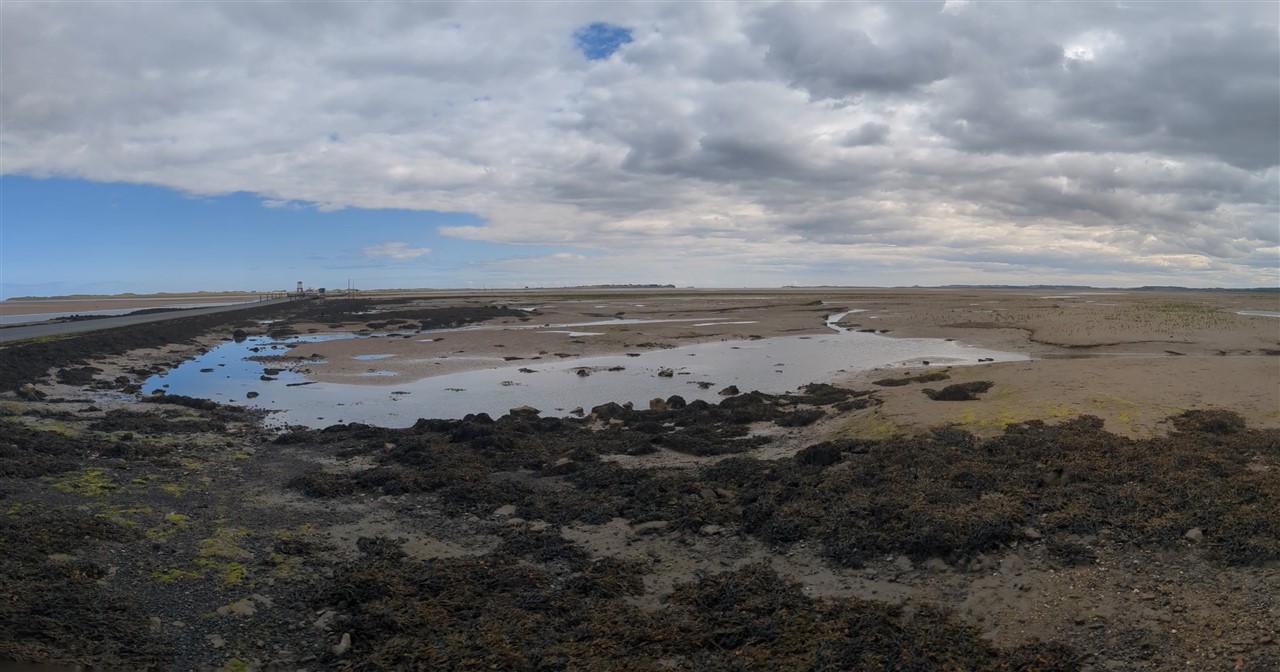
The start of the causeway from the land side (Photo was taken on the return journey)
We originally planned to walk out to the island when the tide was out, but it seems that the crossing is very long (the actual part that is submerged is not that long, but it's a long walk beyond that to the village) and we couldn''t find a car park on the mainland side, so we arrived about 9:30, just in time for a 'safe crossing' of the causeway.
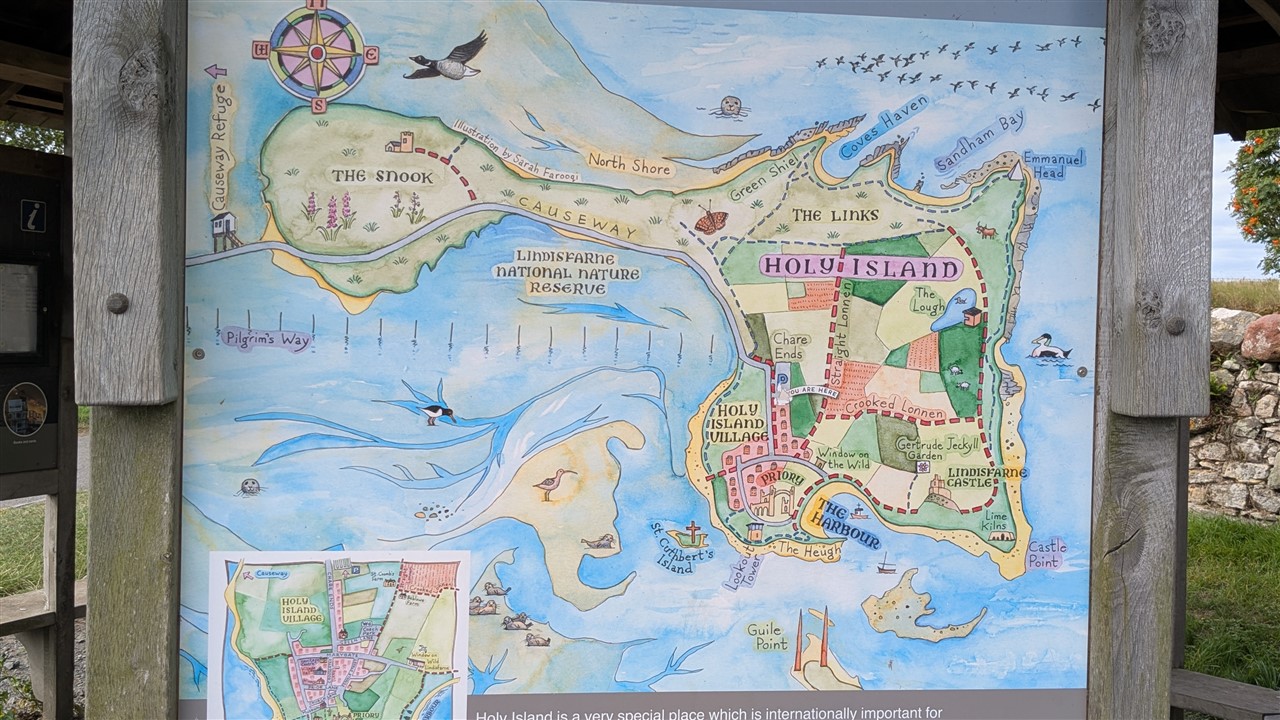
Holy Island Map
As we crossed, the sea water was only just clear of the road surface each side and, in places, there were large puddles still on the road, so we knew we'd arrived ahead of most of the people visiting, but that we also had plenty of time to see the island before the tide returned to cover the causeway again.
We parked in a field on the edge of the village and walked into it, following signs for the Abbey ruins.
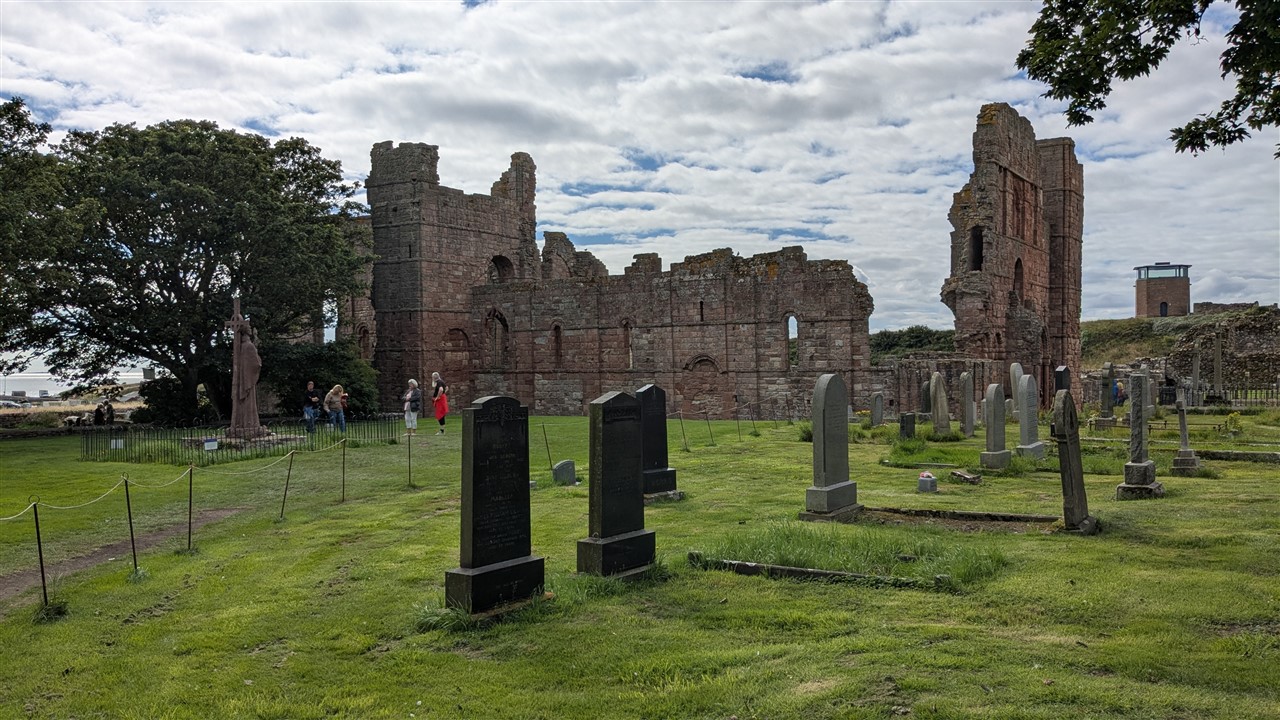
The churchyard and Priory ruins
Once there, we found that they didn't open until 10AM (it was about 10 minutes to), so we wandered around the churchyard next door and then were there as the English Heritage staff member arrived to open up, making us the first people in.
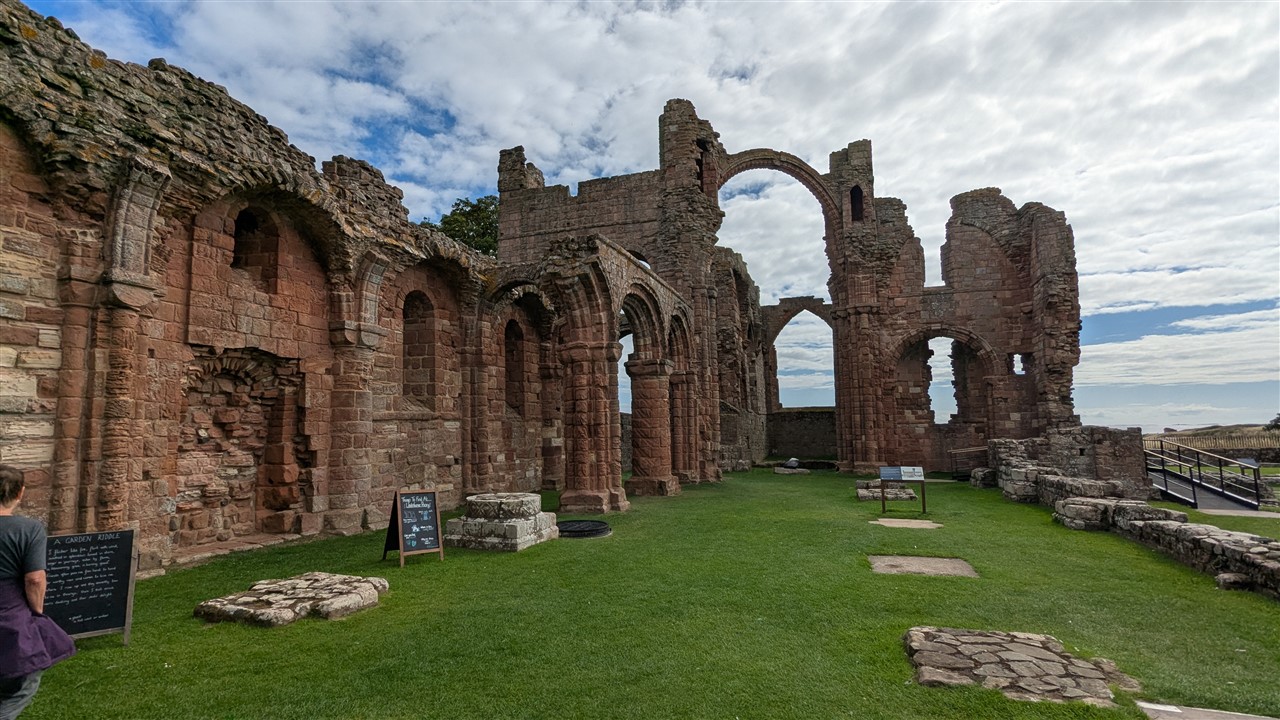
Inside the Priory ruins
Once again, as at Whitby, the Abbey is just a ruin, albeit quite an impressive one (that bastard Henry VIII has a lot to answer for).
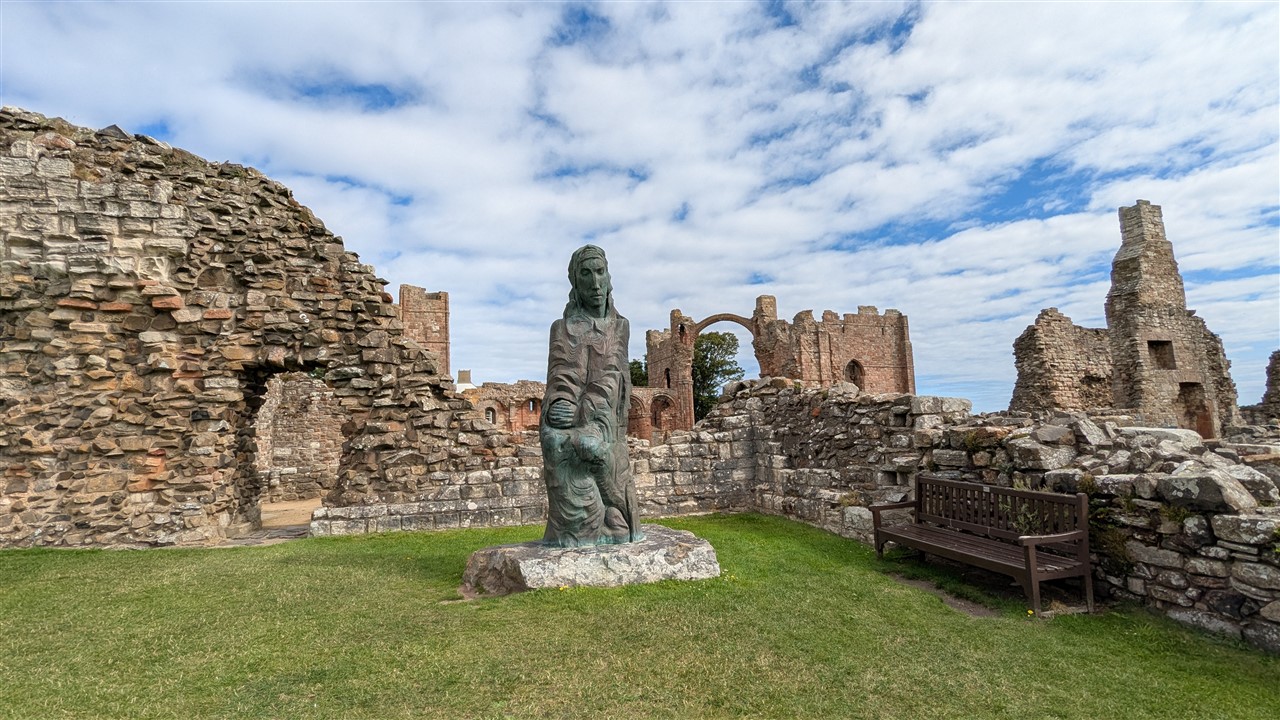
Abstract statue of St Cuthbert in the Priory
We wandered around the ruin for a while and then made our way out to visit the visitor centre and museum associated with it.
After that we walked back and got ourselves a truly excellent (Mandy said it was the best she'd ever had) ice cream from the Pilgrim Gelato and then walked back to the museum, past a couple of pubs and around the side of the Abbey and up onto Hough Hill which overlooks it on one side and the sea on the other and has a couple of ancient lighthouses atop it as well as a more modern structure.

The view from the Heugh over the sea
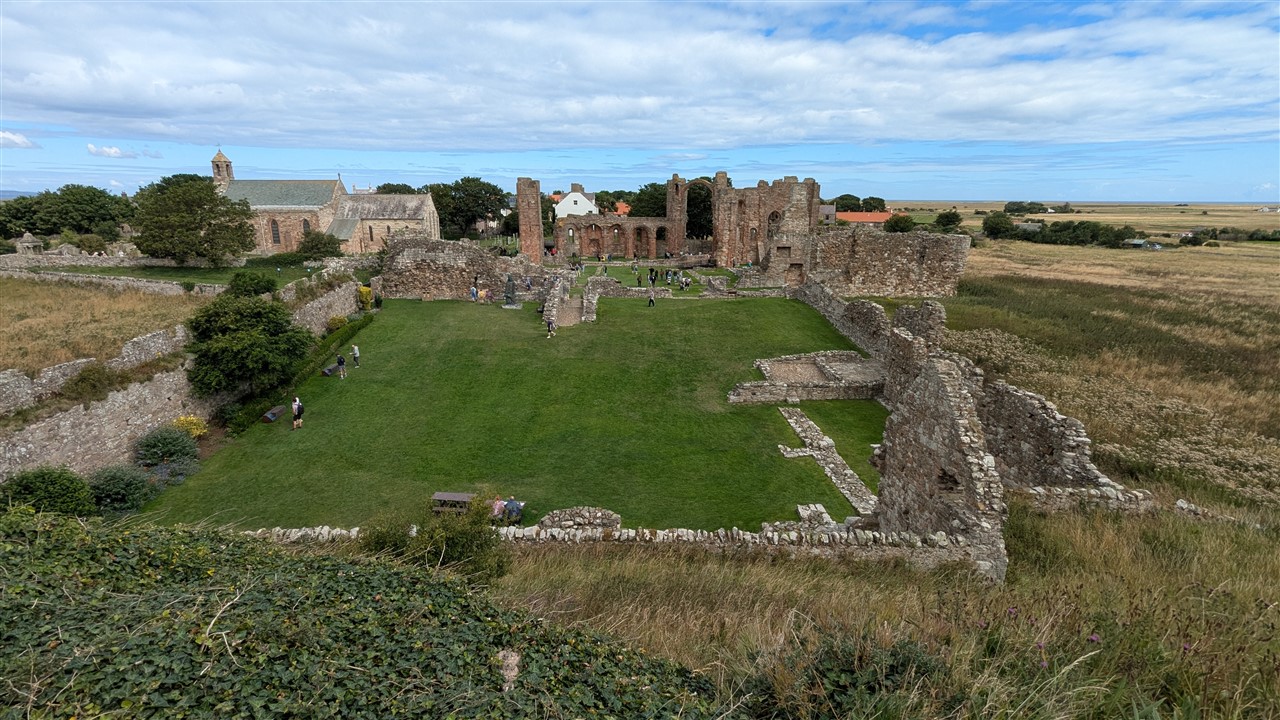
The Priory from Heugh Hill
The views were really quite lovely over the coast and it provided a good viewpoint over the Abbey ruins as well.
From there we headed back down, but turned right to the small harbour (not a very picturesque one), which did provide some nice views of the Castle, but as that was National Trust we elected to keep our viewing of it to from a distance.
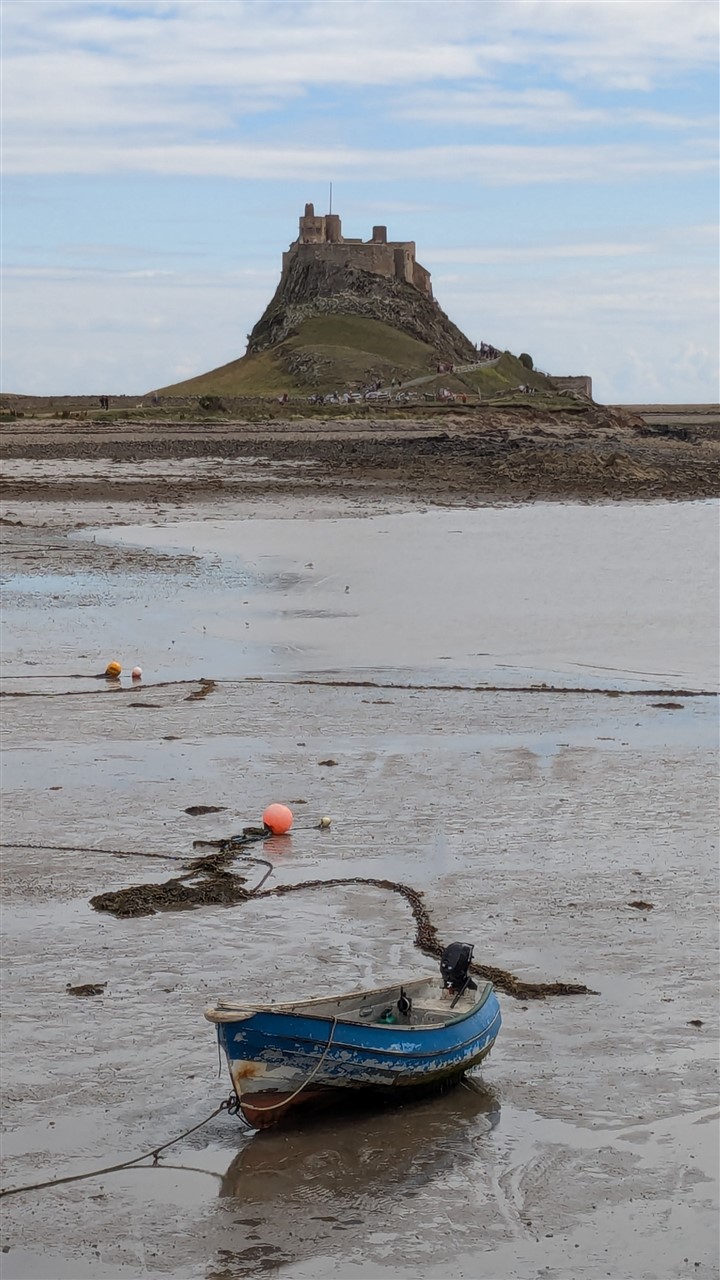
The Castle from the harbour
We walked back to the pubs and decided to have a light lunch in the Manor House (I had soup of the day, Mandy whitebait along with a half of beer each and very good it was, too).
As we left, to head back to our car, we met fellow dive club member's Andy and Justyna coming the other way, so we directed them to the ice cream shop and Hough Hill as places to go.
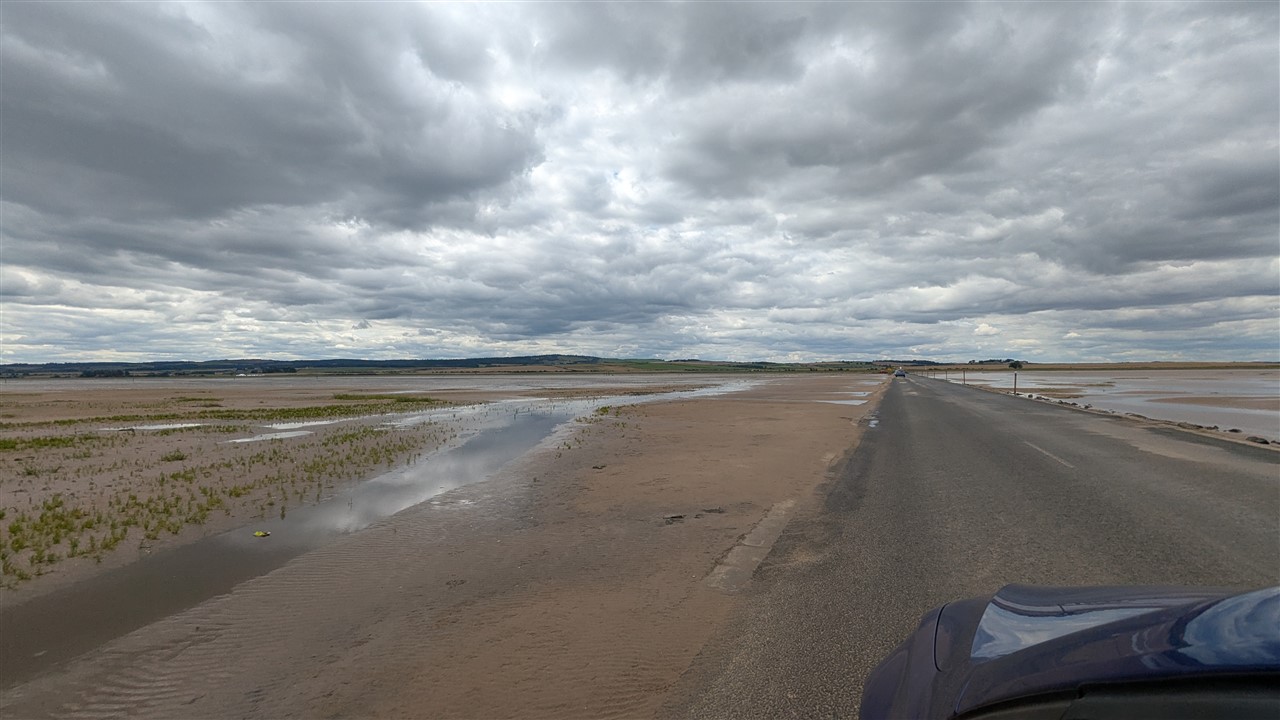
Crossing the causeway
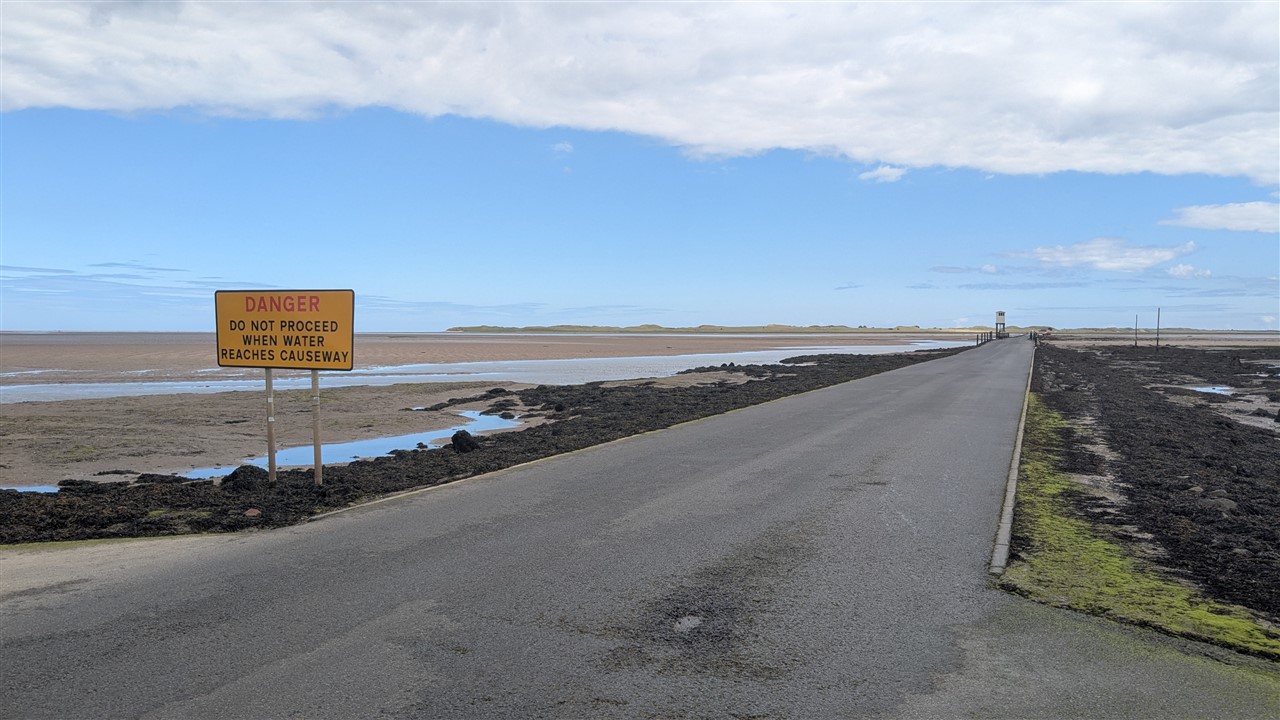
The view back to Lindisfarne from the causeway - Cars regularly get stuck and there is path across the sand as well
Warkworth Castle
While in the pub, I had found another English Heritage castle nearby, Warkworth.
It looked quite good on the EH website, so we collected the car, paused for some photographs on the causeway back to the mainland and then made our way south to Warkworth.
Once again, the castle is of the ruined type, but in contrast to Dunstanburgh, it is still structurally significantly intact.
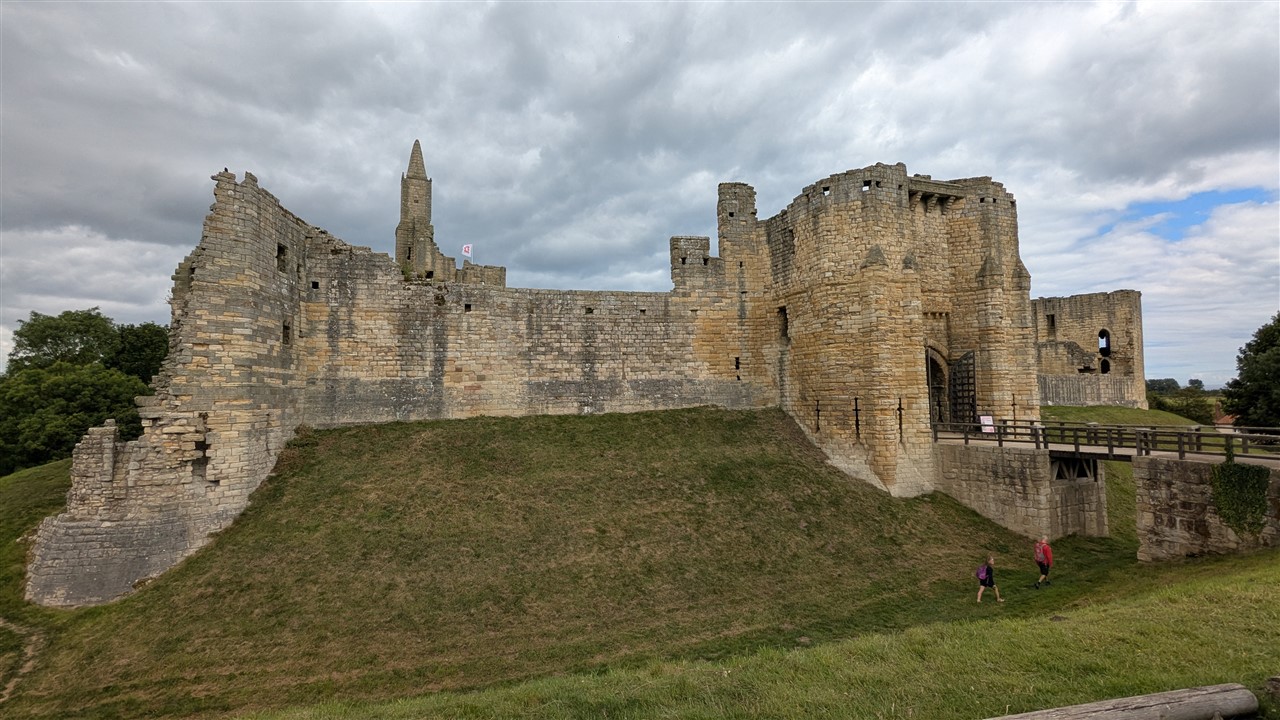
Warkworth's impressively complete walls
The car park is right in front of the impressive frontage and gatehouse of the castle, one of the main homes of the Percy family over the centuries.
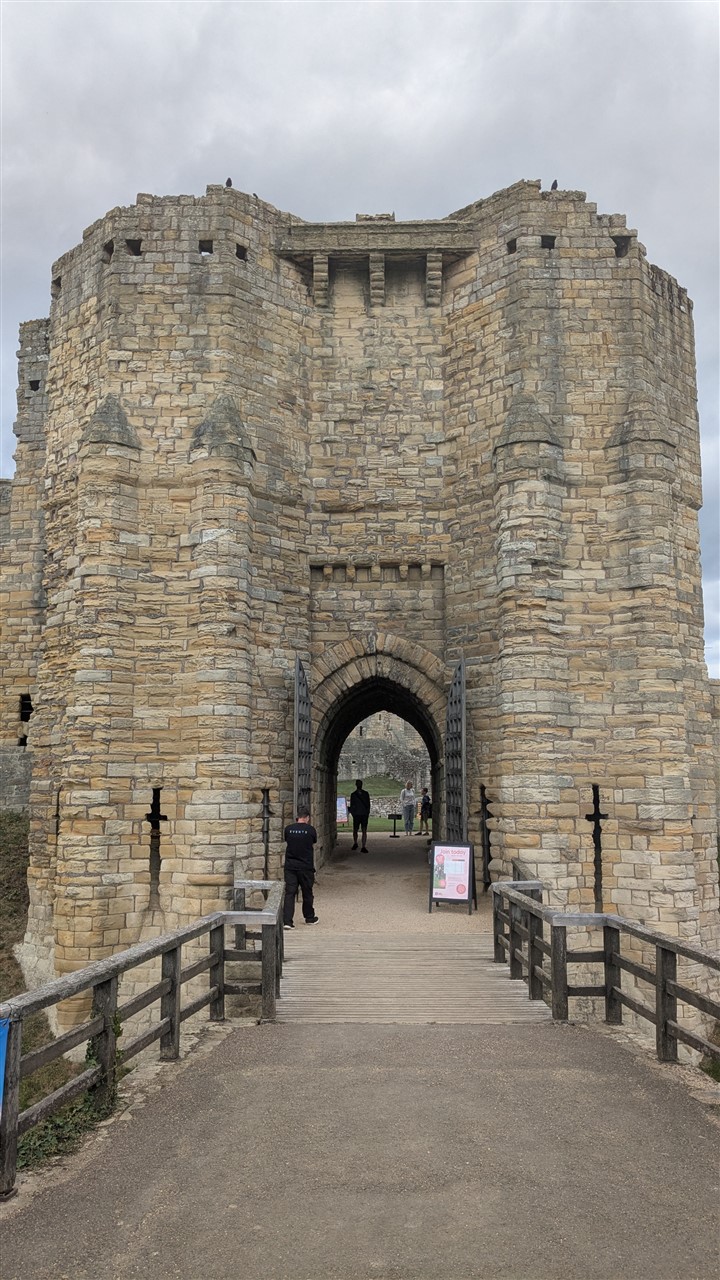
The gatehouse
There is plenty to see here, with a complete curtain wall and numerous externally intact towers, complete with rooms inside and the outline of numerous buildings within the castle walls.
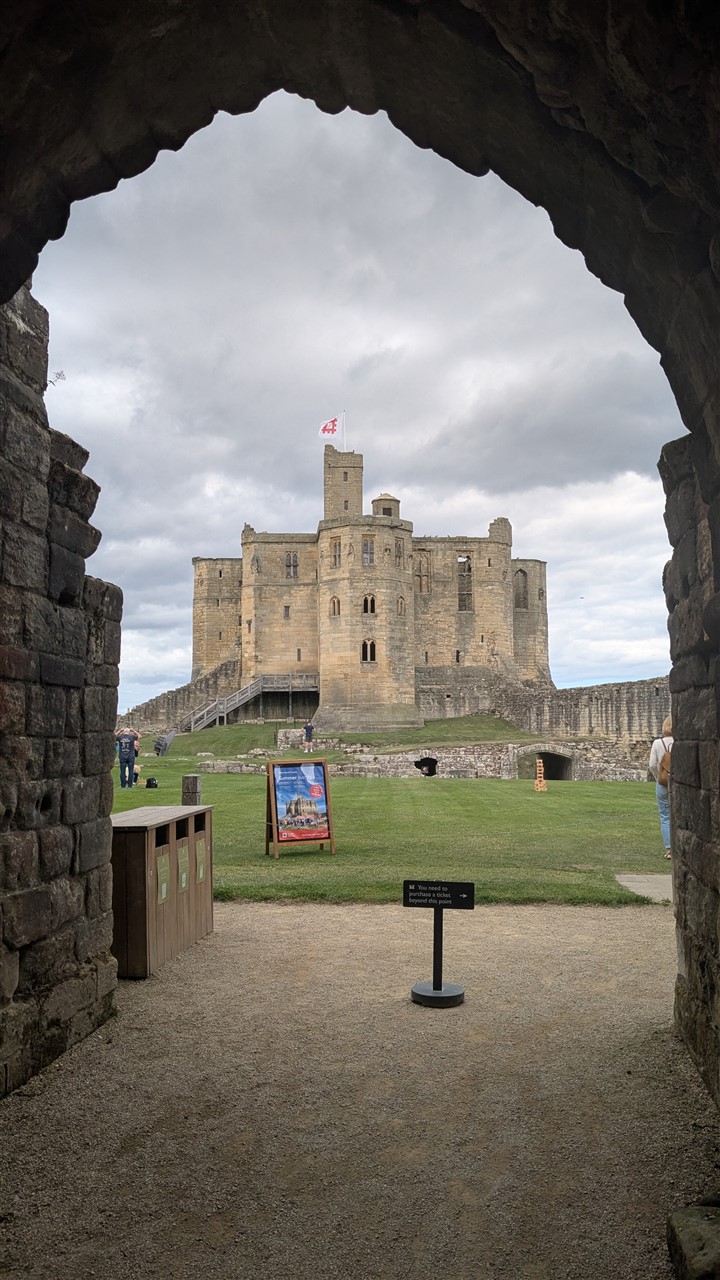
The keep from the gatehouse
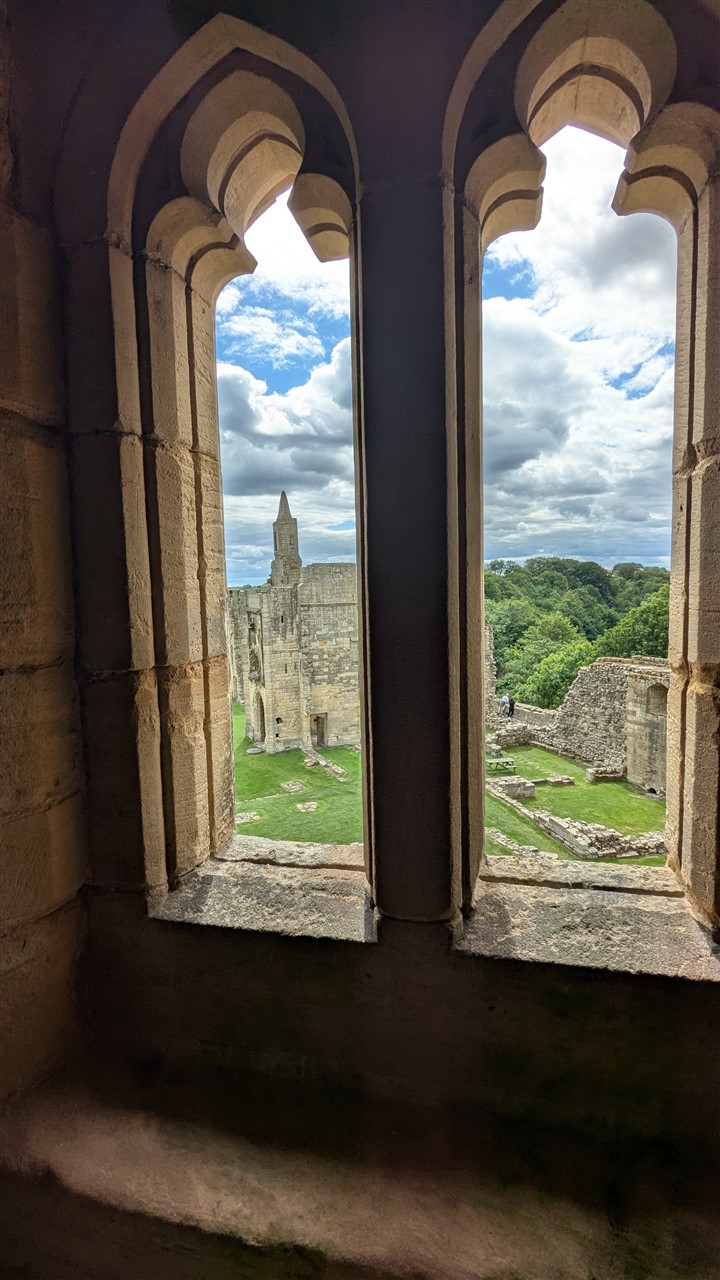
A view from one of the windows in the keep
Not having known anything about Warkworth castle, it was definitely the unexpected 'find' of the holiday.
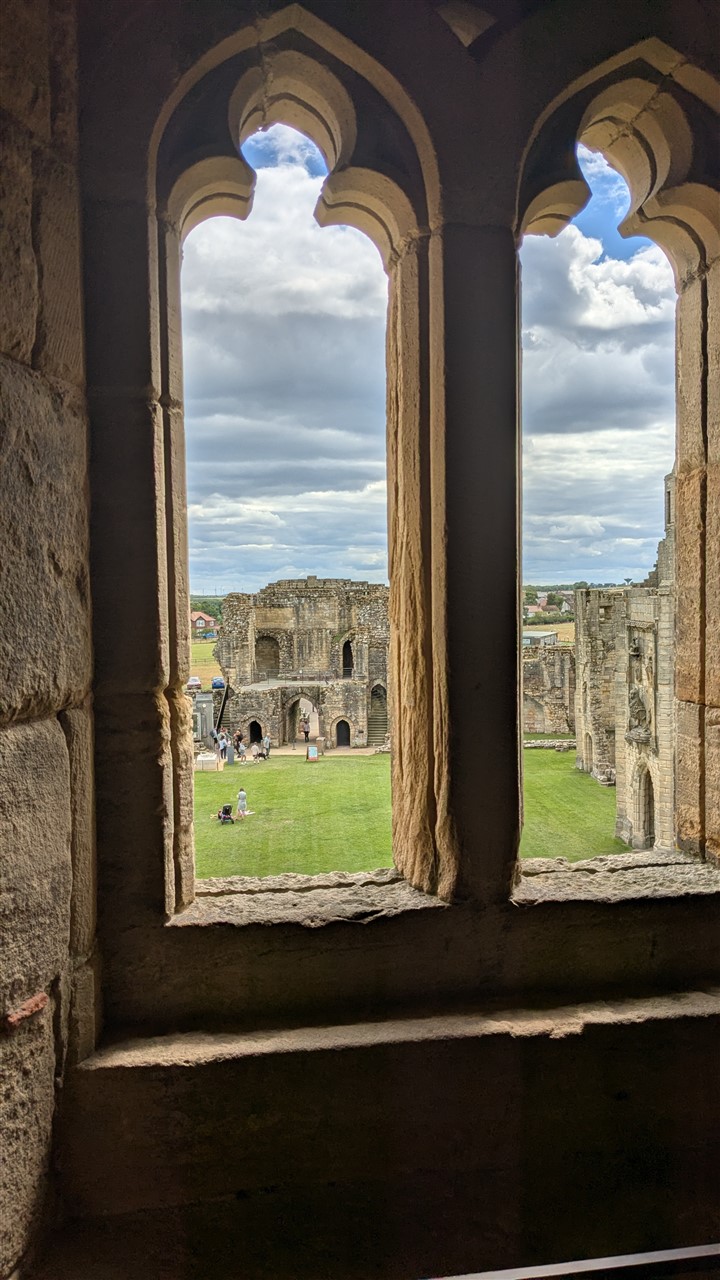
And another!
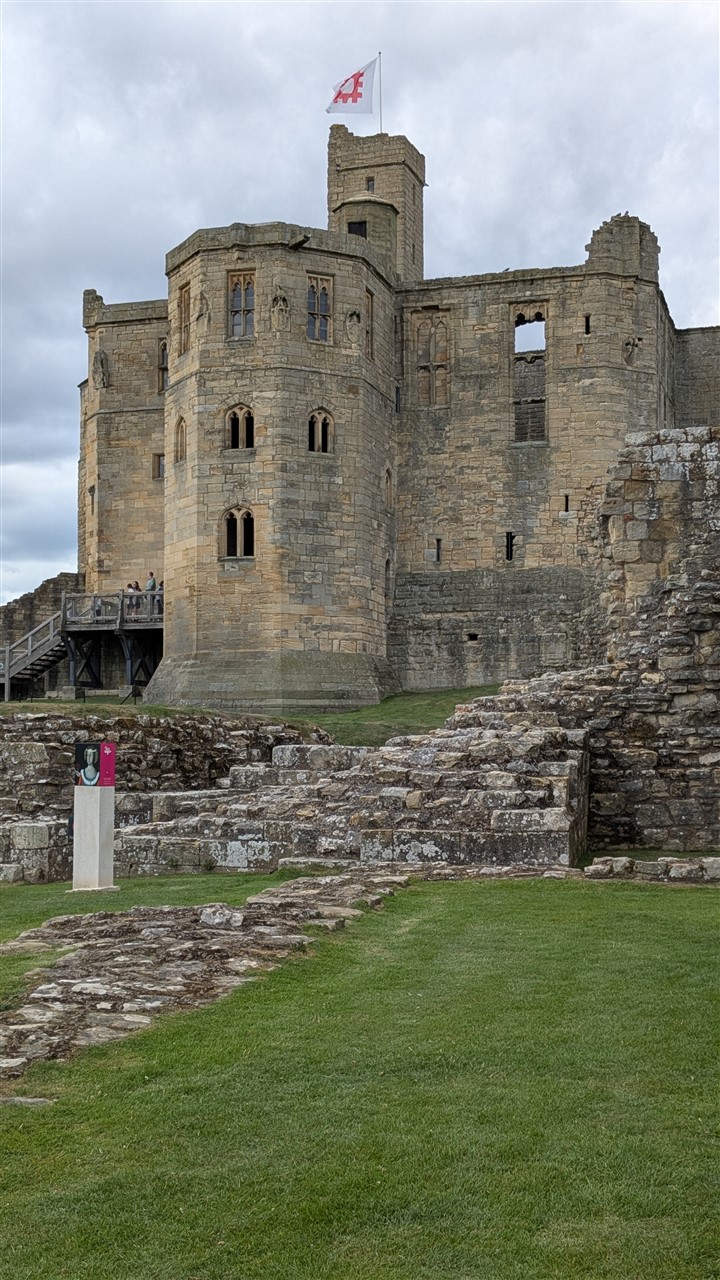
A closer view of the Keep.
We had a light meal in the bungalow and then I popped to the local pub to meet Andy (his family are from Berwick and it was their local!) and Justyna, who confirmed that the chocolate ice cream was, indeed, incredible!
I had one beer with them and then went back, as we had an earlyish start the following morning.
Farne Islands and Cuthbert's Cave
We had booked a boat trip out to the Farne Islands for the Tuesday on the Friday evening, because that looked to be the day with the best weather, but the forecast changed, so it was with some relief and a lot of pleasure that we reached Seahouses in sunshine.
We checked in and then had a quick look around Seahouses (we were warned it's nothing special and that seemed a fair assessment), before returning at 9:45 for our 10AM boat trip.
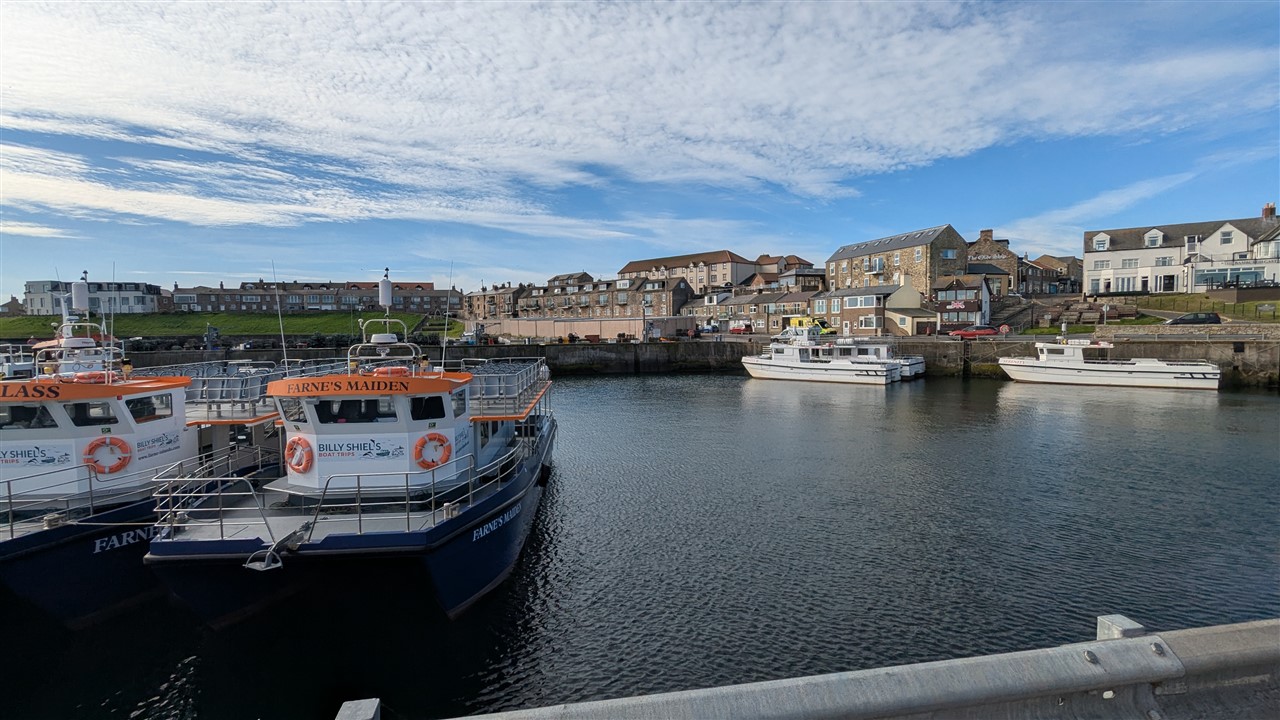
Seahouses harbour
We hoped to see Puffins, but we'd already decided that, along with most things, the warm spring weather had bought the breeding season forward and they were already likely to be gone.
We sat on the top deck of the boat and took the very short trip out to the first of the islands, it's probably less than 15 minutes out.
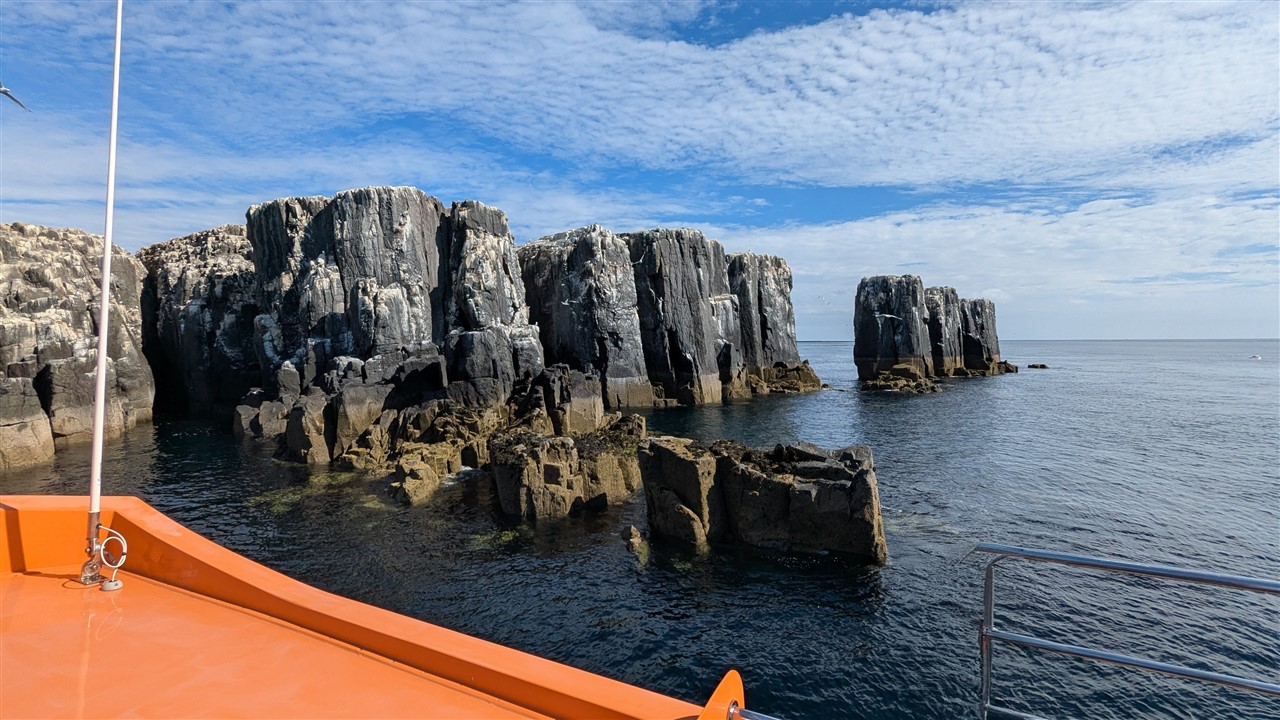
Lovely weather for a boat trip, luckily!
As we headed out, the boat captain came over the tannoy to point out two Puffins bobbing on the sea! Perhaps we'd be in luck after all...
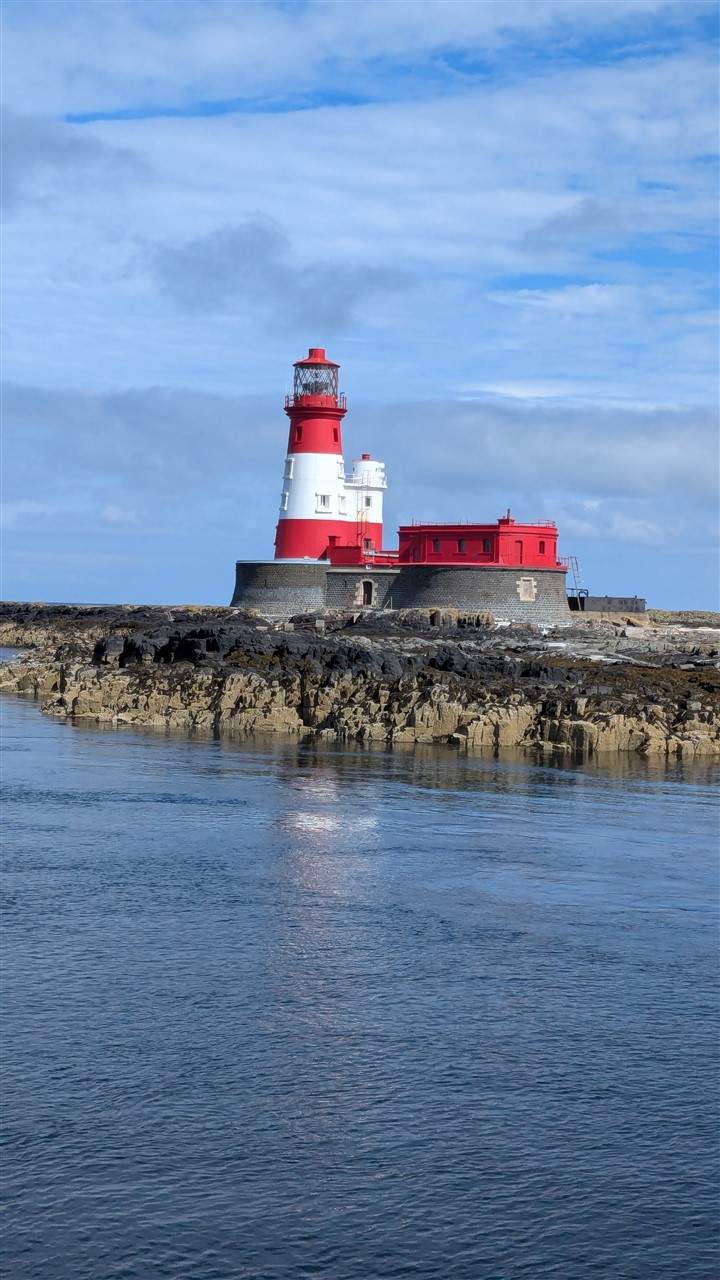
The modern lighthouse - Grace Darling's family lived here
Sadly, those were the only two we were to see, but as we motored between the various islands, we did see plenty of other sea birds, including Shags (Yeah, Babeeee!) and Kitiwakes (If they hadn't been pointed out as such, I'd have called them seagulls!).
We also came across a lot of Grey Seals, either basking on rocks or playing in the water, which were more interesting to most of those on board than lots of birds.
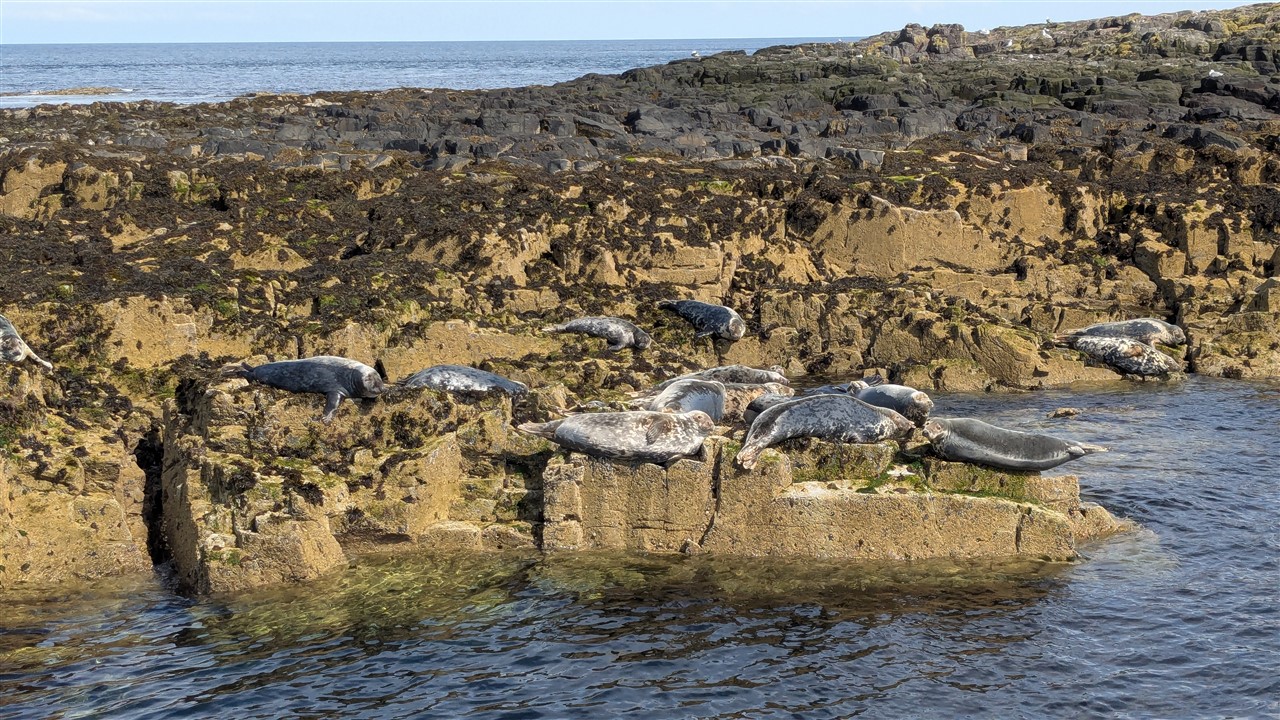
We saw lots of Grey Seals on the Farne Islands
One thing that struck me was how clear the water was here. At one point I mentioned it to Mandy and said I could see the seabed. I could see into the wheelhouse, so I looked at their sonar and could see it was reading 23M!
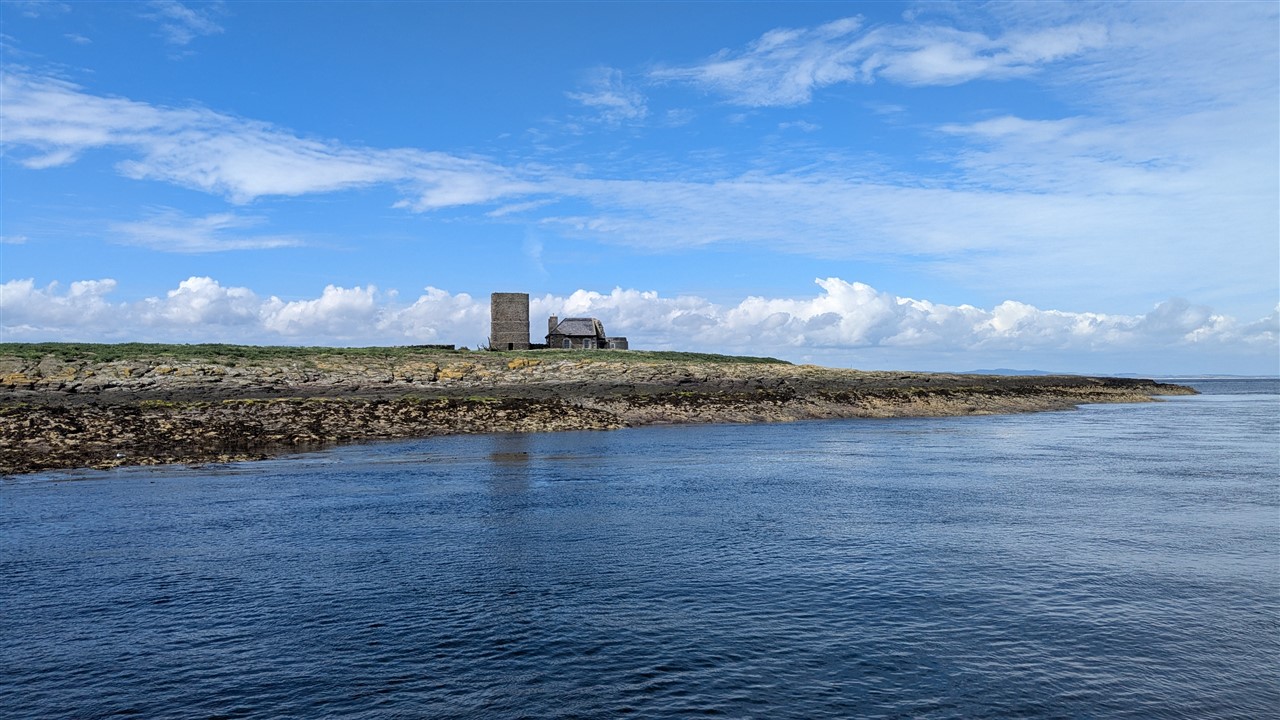
The remains of two ancient light houses, now unused
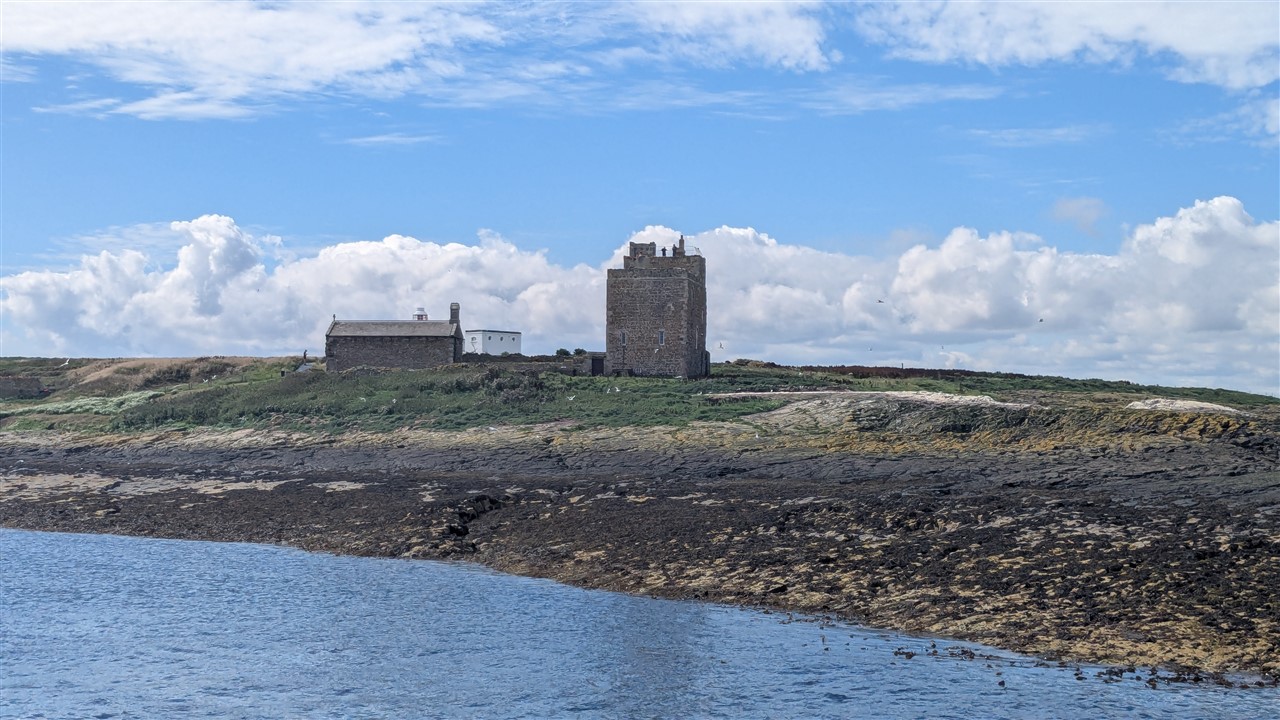
Inner Farne Island, the only one you can land on.
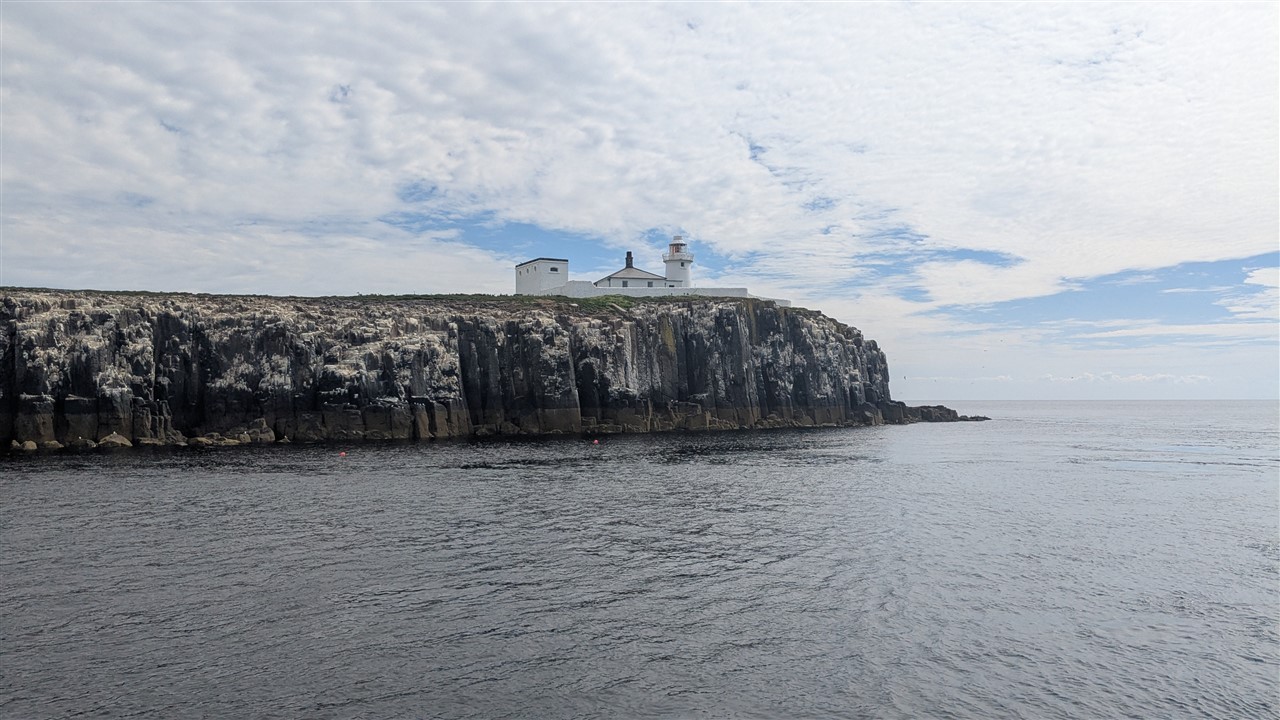
The Inner Farne Lighthouse
We bought another ice cream (not a patch on the one in Lindisfarne, sadly) and then set off for Cuthbert's Cave.
Cuthbert's Cave is a rock overhang (Cave is a little strong, I believe) where it's rumoured that St Cuthbert (founder, I think, of Lindisfarne) was buried. Or Lived. Or never visited...Like most of these myths and legends, the truth is probably something else altogether, such as the imagination of some over-romantic Victorian, but it was a stroll in the countryside and, I suspect, Mandy hoped to spot some more butterflies.
We found the car park and sat there to eat our lunch and then set off up the hill to find the 'cave'.
At first, the signposting was good, but on the map, the cave appeared to be above some woods and when we saw a sign (not a sign post with a direction) on the edge of the woods saying Cuthbert's Cave, I took it to mean Cuthbert's Cave Wood (as marked on the map).
We carried on up the hill, but there were no further signs for the cave.
After a bit of 'discussion' and talking to two, equally lost, woman, we decided to head back down the hill and there appeared to be a path down through the wood.
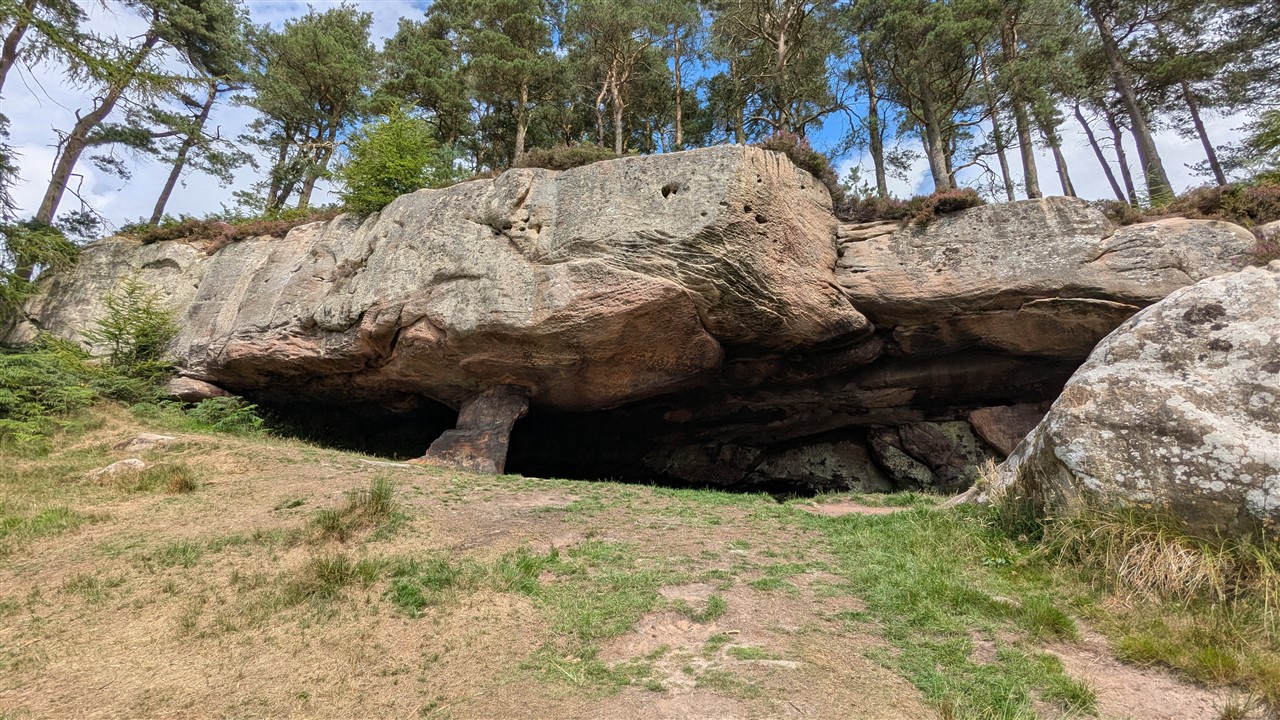
St Cuthbert's Cave
Within 50 yards we came across a group of people sitting on rocks and what clearly had to be the 'cave'!
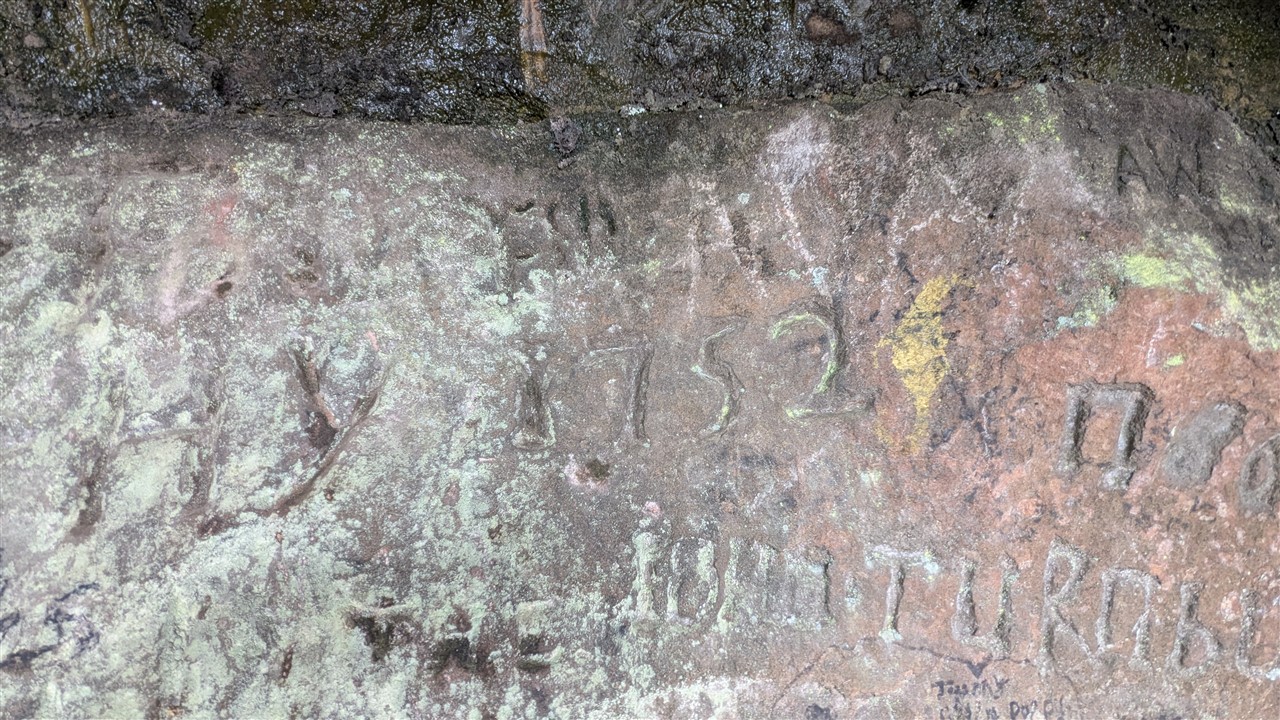
Grafitti is nothing new - 1752!
As you can see it's a rock overhang and it's hard to imagine anyone living there, even in times used to less comfort, but it's obviously been visited for many centuries as the carved graffiti attests; one I saw was dated 1752!
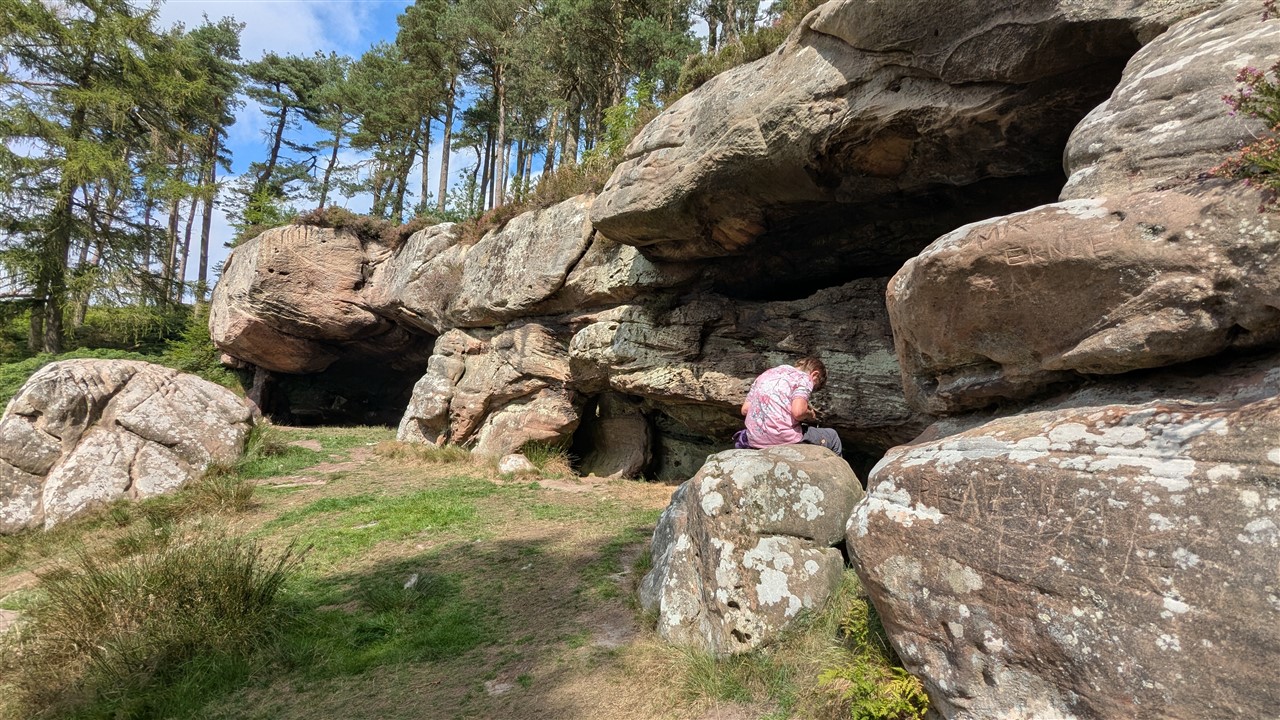
For a while we had the whole place to ourselves and it was wonderfully peaceful
We stayed there for about half an hour and then headed back to the car and back to Berwick-Upon-Tweed.
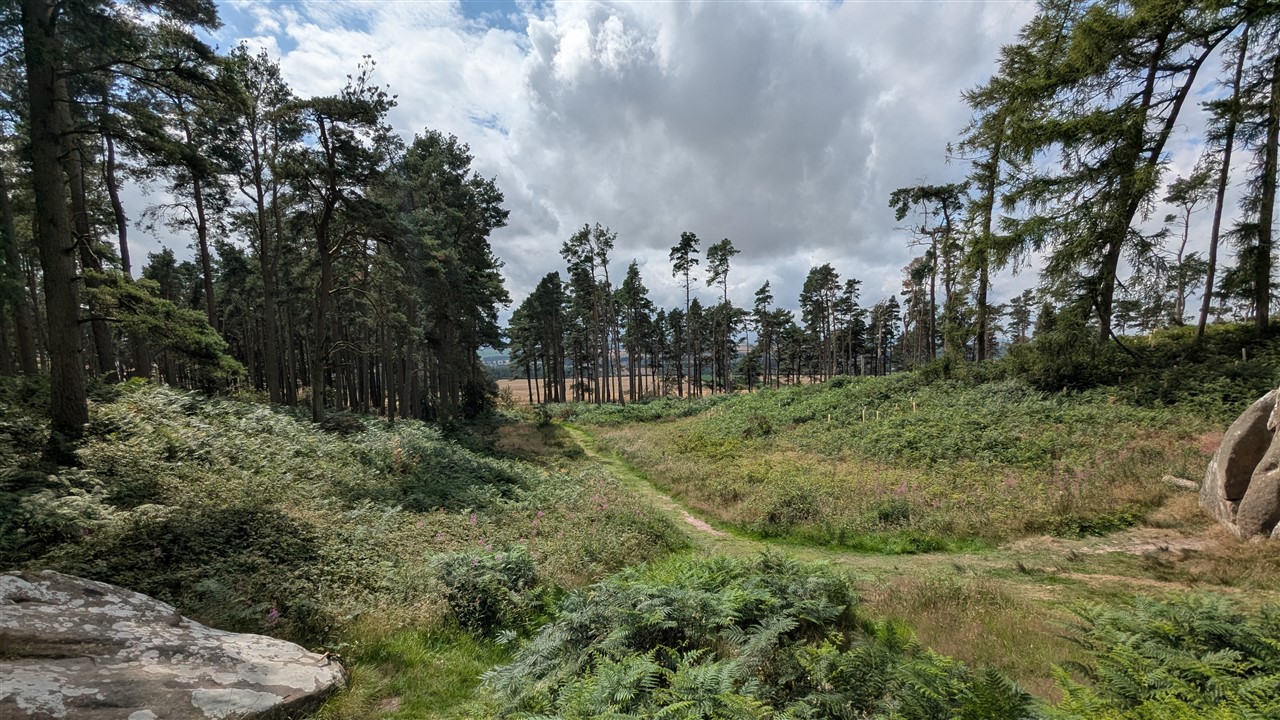
The path down from the Cave
Berwick-Upon-Tweed
Despite being in Berwick for 5 days by this point, we'd only ventured out on foot a few hundred yards from our bungalow.
Mandy's sister had said it wasn't worth seeing, but the town walls themselves promised to be of some interest at least, so, under blue skies we set out.
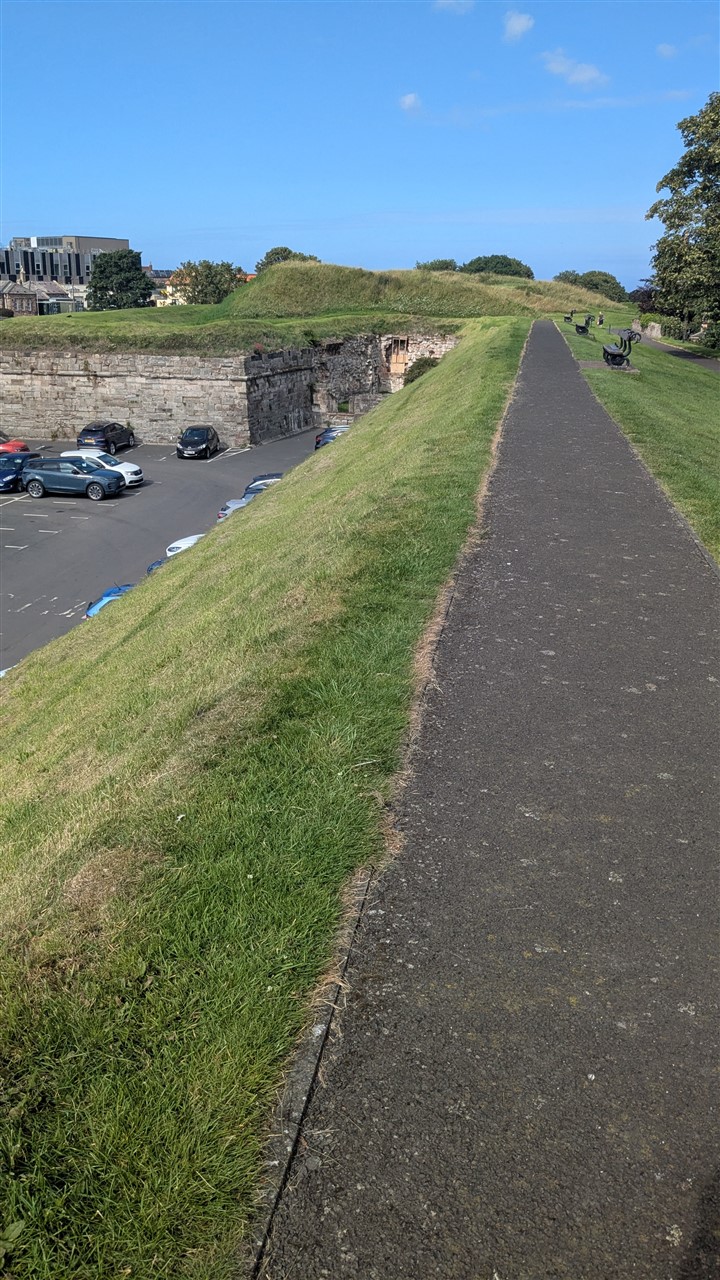
Part of the walls of Berwick-Upon-Tweed
Someone had mentioned 'Bridge Street' as a road of independent shops worth seeing, so we strolled down the walls (with some remarkably precipitous drops! towards the town and then found ourselves there.
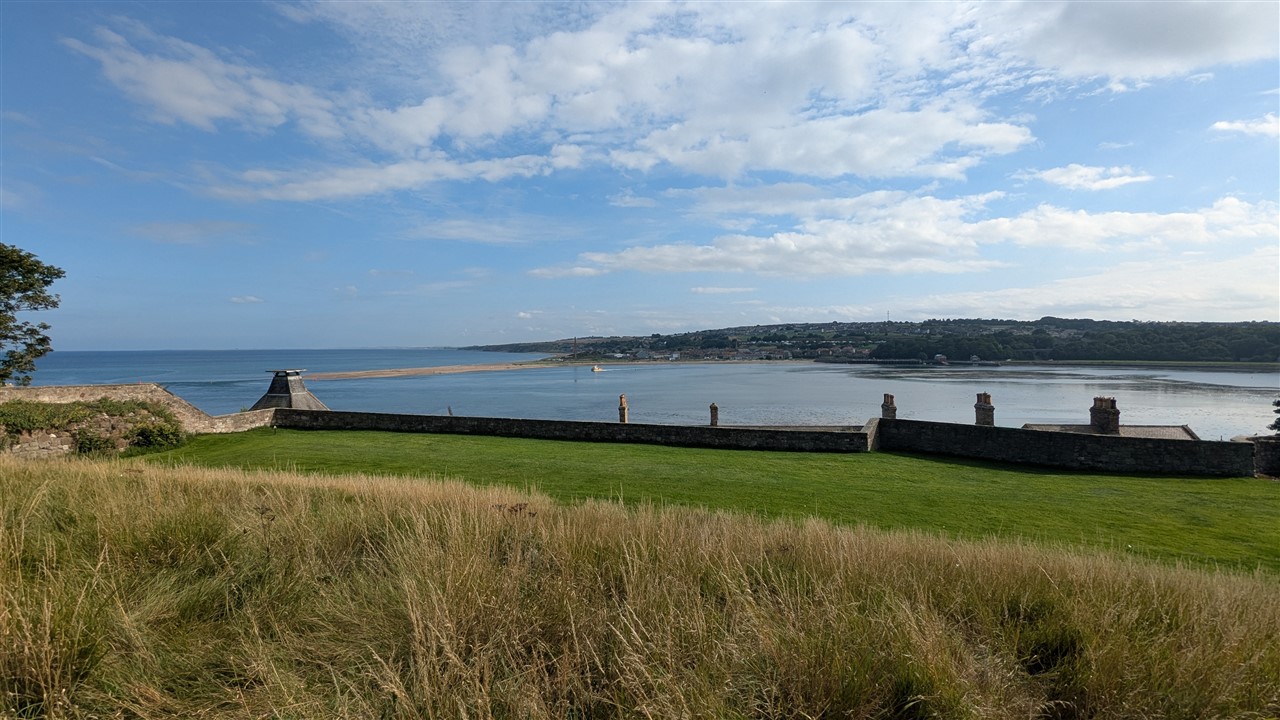
A view of the Tweed esturary from the walls
Unfortunately, some shops were unoccupied and nearly all the others had closed at 4, about an hour before we arrived! I was particulary disappointed that a secondhand bookshop was closed, I could have spent a good few hours in there!
We did find an Indian restaurant (claiming to be in the top 18 in the UK - One would imagine at number 18 as it's such a specific number!) and ate dinner there. It was reasonably good, but I wouldn't say it was in the top 18 Indian restaurants in the UK that I've eaten in and, while the food was reasonably good, the service was unfriendly, bordering on the surly, so I won't name check them!
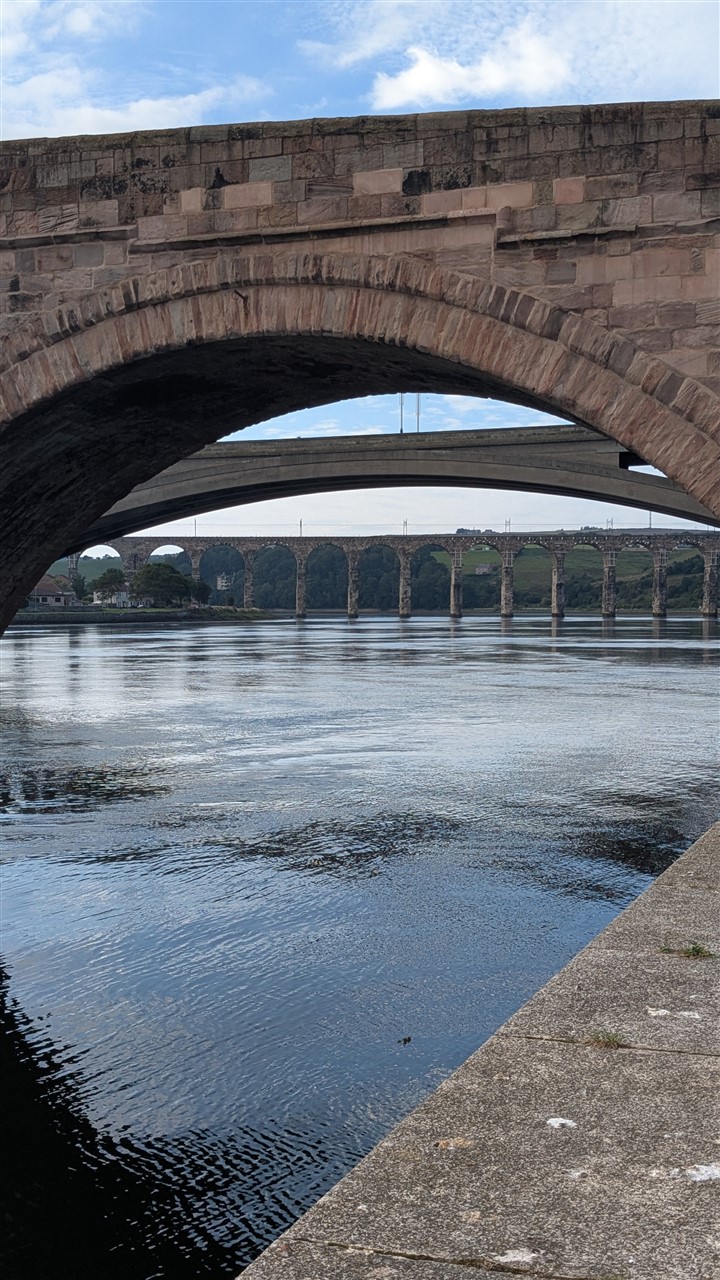
The three bridges of Berwick
We walked along the quayside, taking in the 3 bridges (2 road and one a railway viaduct, built by Stephenson and still in use) after dinner and then headed back up through the main part of town (a less attractive area, but not unpleasant) to our accommodation.
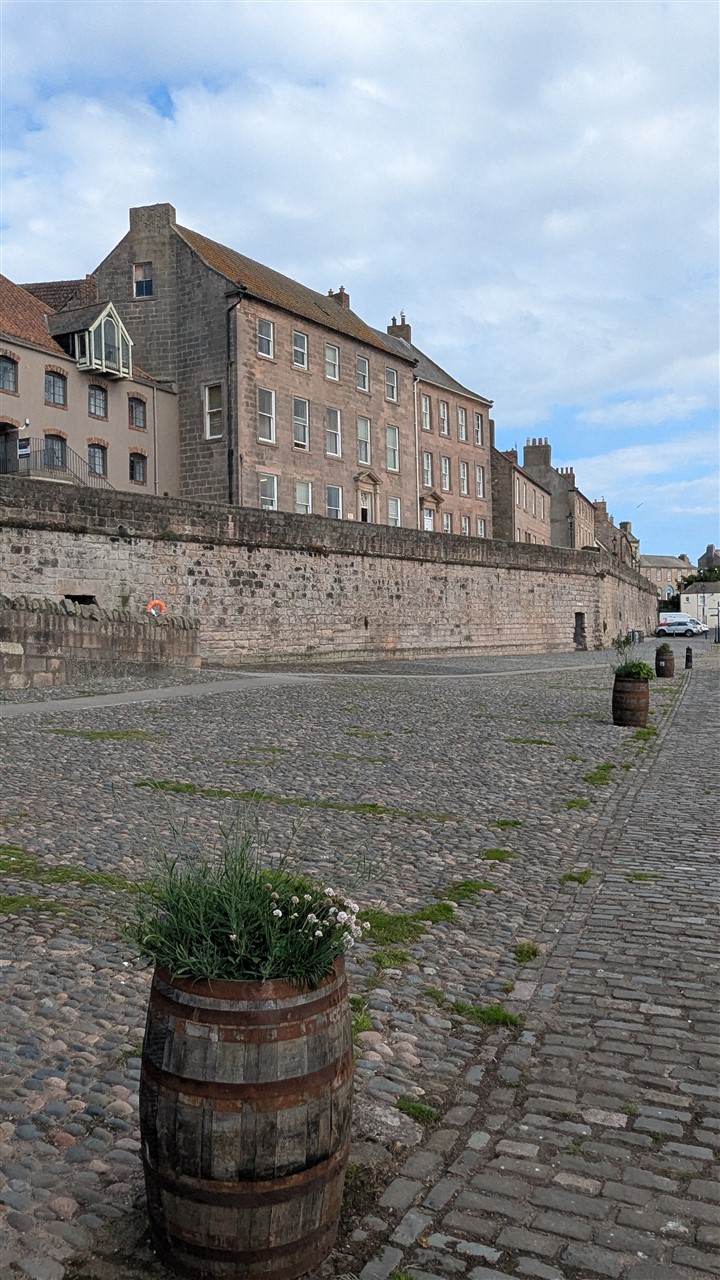
Berwick Quayside
A 5 castle day to end!
For our final day, we decided to try and visit 3 castles locally, but the EH guide suggested they were all ruins and, with no entrance fee, were likely to be fairly small, so I suggested we visit another, non-English Heritage castle, Alnwick.
We got a small discount on entry with our EH membership and we arrived in Alnwick village about 15 minutes before the castle opened, so strolled up the road a little first.
After buying our tickets, we wandered into the castle and found ourselves in a sort of themed food-court, where people were dressed in medieval costumes and pretending to be various crafts people.
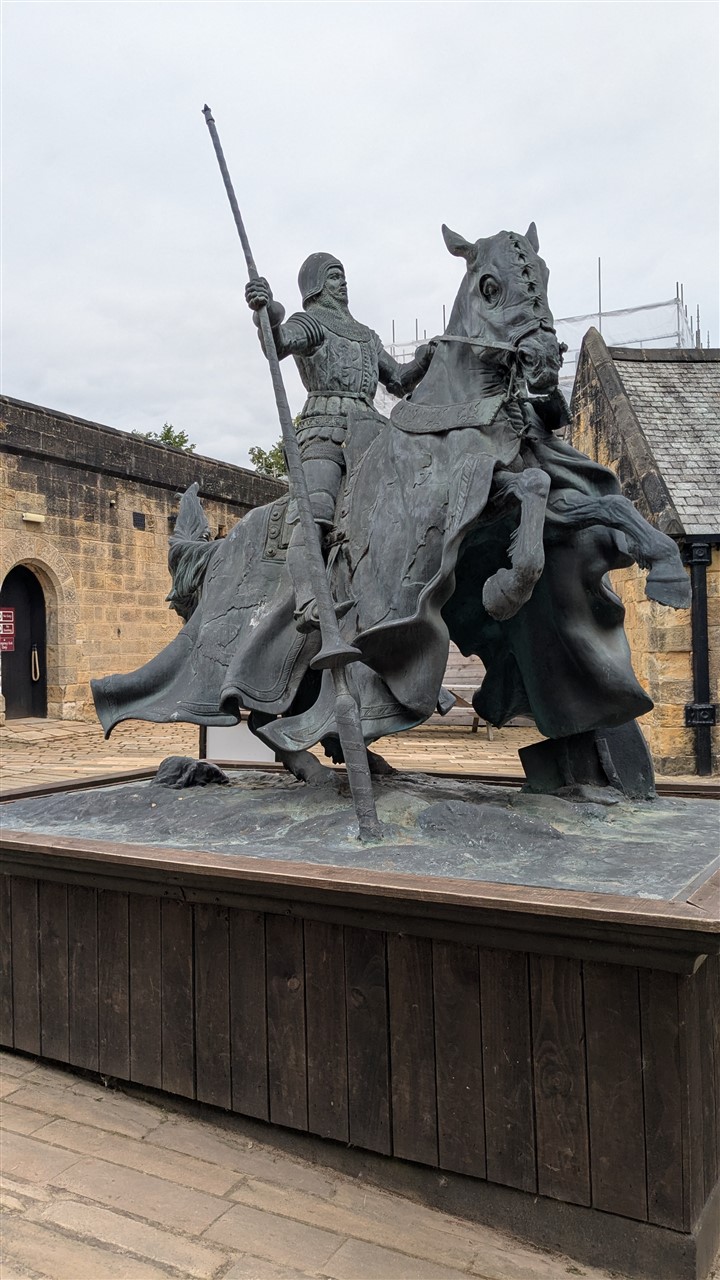
Statue of 'Harry Hotspur' at Alnwick
It reminded me a little of Warwick Castle, which we'd visited many years ago when Lauren and Ryan were young, but without children it seemed a bit gimmicky, so we didn't linger.
Eventually, we found our way into the main part of the castle grounds and wandered around there for a while, taking in the views over the surrounding estate and of the outside of the, undoubtedly, impressive castle (the current home of the Percy family, who count the famous 'Harry Hotspur' amongst their ancestors.
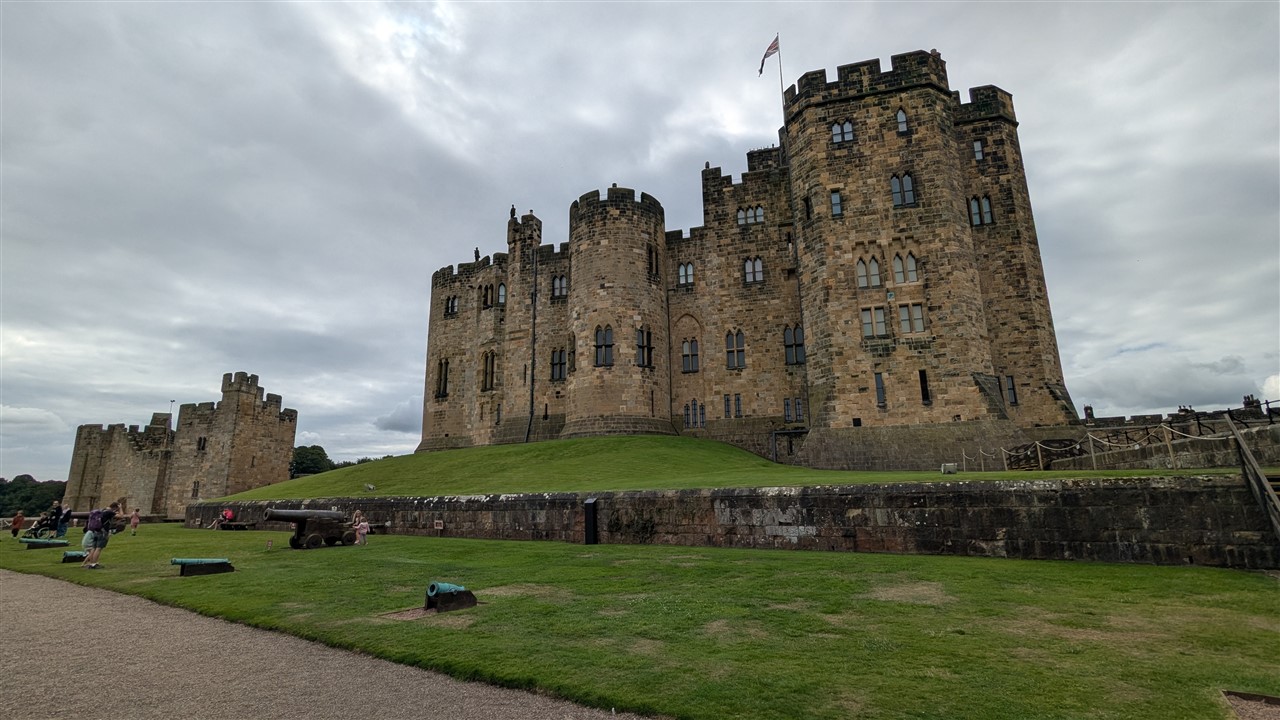
Alnwick is an impressive castle
Photographs were forbidden inside (it's hard to understand why) and there are relatively few rooms open to the public, given the size of the castle.
It's quite apparent, from the decor and items left on tables, that this is a family home some of the time (talking to one member of staff, it seems the family winter there from October to March and visit at various other times), but it really could do with some more signage as, for example, one corridor is full of porcelain and dinner services on display in cabinets, but without a single sign to tell you what they are or when they were made. Similarly, lots of statues are uncredited and unremarked upon.
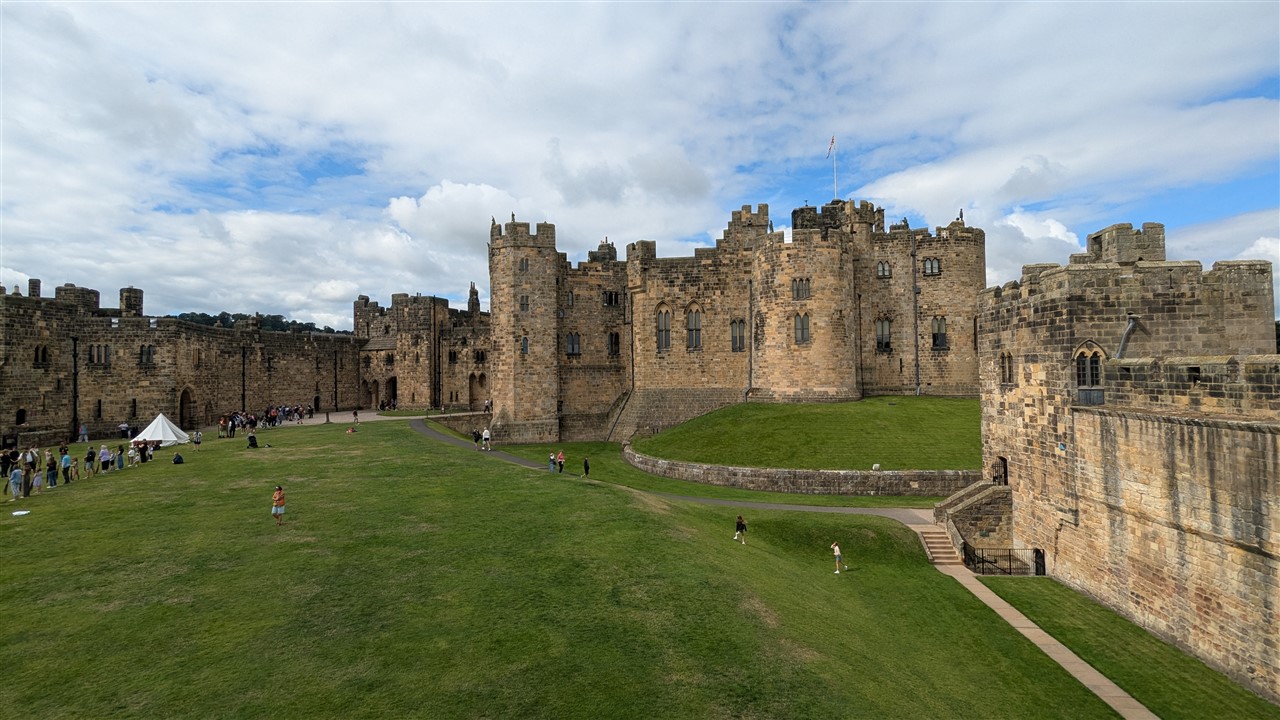
The crowd to the left are pretending to play Quidditch! The castle was used as a location in some Harry Potter films, apparently
In contrast, most rooms had laminated sheets itemising the paintings therein.
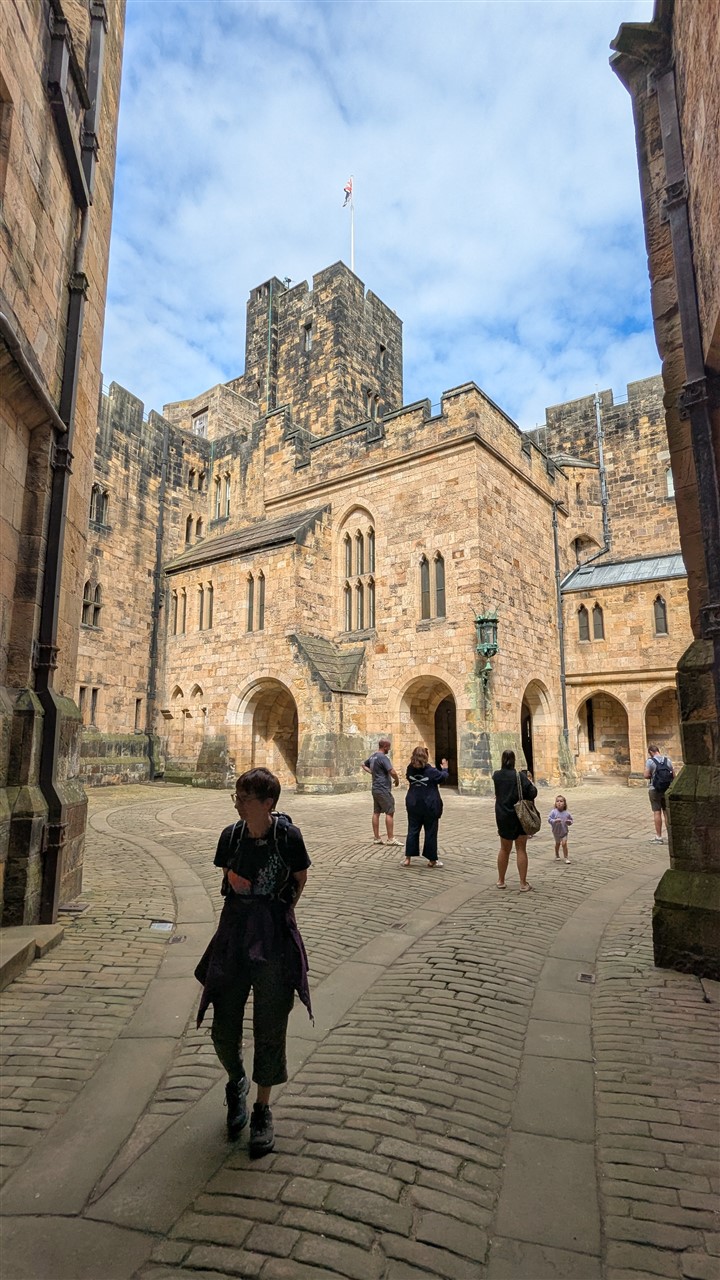
The entrance to the main rooms is through the arches at the back of this shot, up an incredible staircase we weren't allowed to photograph
Three things particulary stick in my mind from the interior of Alnwick, though. Firstly the incredibly wide entrance staircase. Secondly, a table football table sitting incongriously amongst antique furniture and, finally, a stuffed dog on a couch!
I also took a quick tour of the Northumberland Regiment museum which occupies a small tower in one corner of the castle. A typical regimental museum, it's worth a look of you're interested in such things, although it must be chaos when really busy as the single staircase between the 3 floors is wide enough only for one person.
After leaving the castle we decided to have a pub lunch. We walked along the street and came to The Dirty Bottles, a Greene King pub, first.
Their pubs vary a lot in quality and are rarely terrible, but both Mandy and I were impressed by how good our meals were! I had a chicken and ham pie, Mandy a burger, recommended if you want a pub lunch in Alnwick.
While there, we realised we hadn't seen the castle kitchens, so, as the car was parked beyond the castle, we nipped back in to look at them.
They are part of an ongoing restoration project, so currently in a very bare state, but in many ways were more what we'd expect of a castle than the state rooms had been. They were better signed as well!
The rest of our day was planned to be made up of visiting the 3 ruined castles we has originally planned to see, Edlingham, Etal and Norham.
It was a pleasant afternoon and we drove along quiet country roads between the castles.
Edlingham Castle sits next to an 11th century church, which in itself was interesting, but the castle is a cracked tower (secured with tie bars) and some ground level walls and the village that once supported the castle and the church served is long lost to history, so we didn't stay very long.
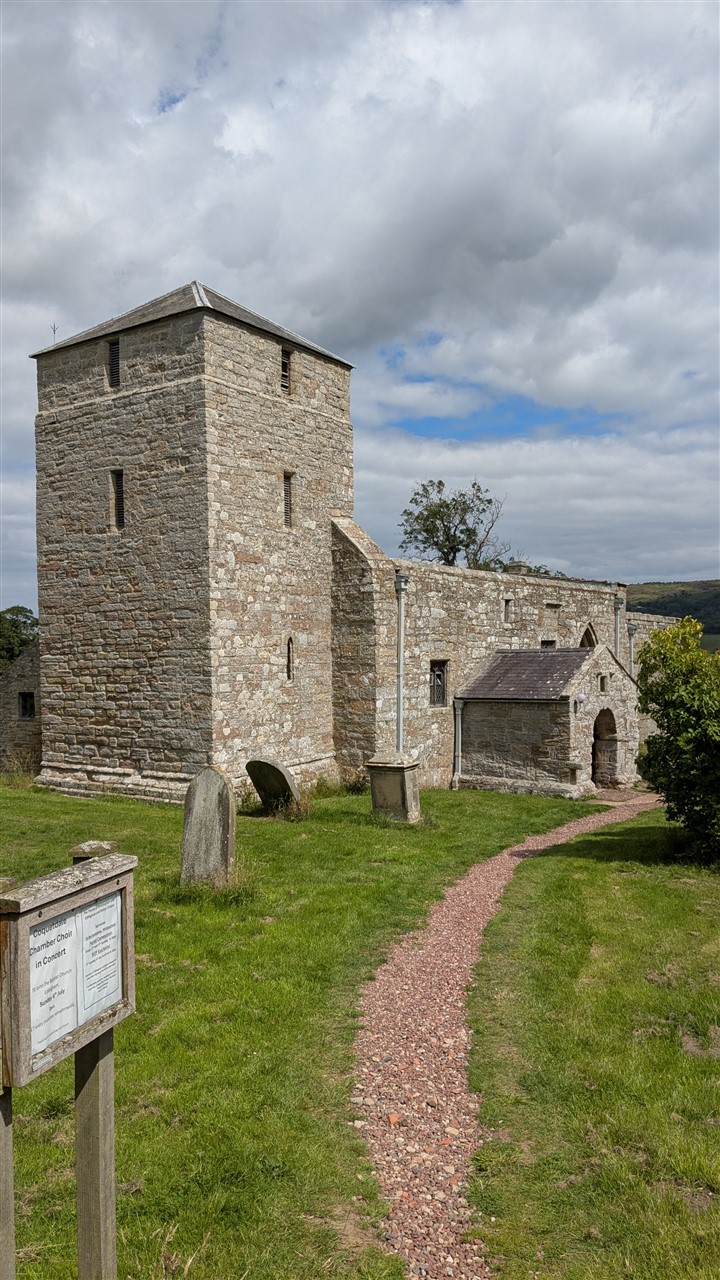
Edlingham Church is worth seeing itself - A very old, basic church
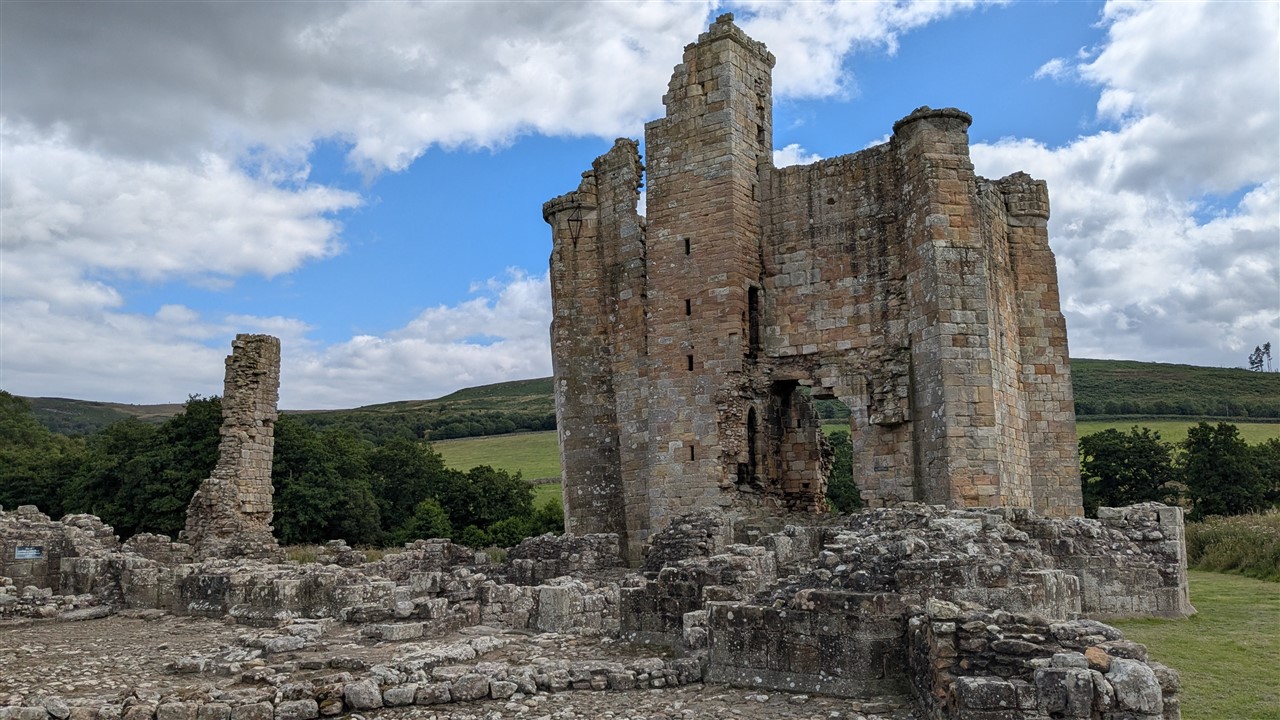
The castle is a broken tower and some ground level walls now.
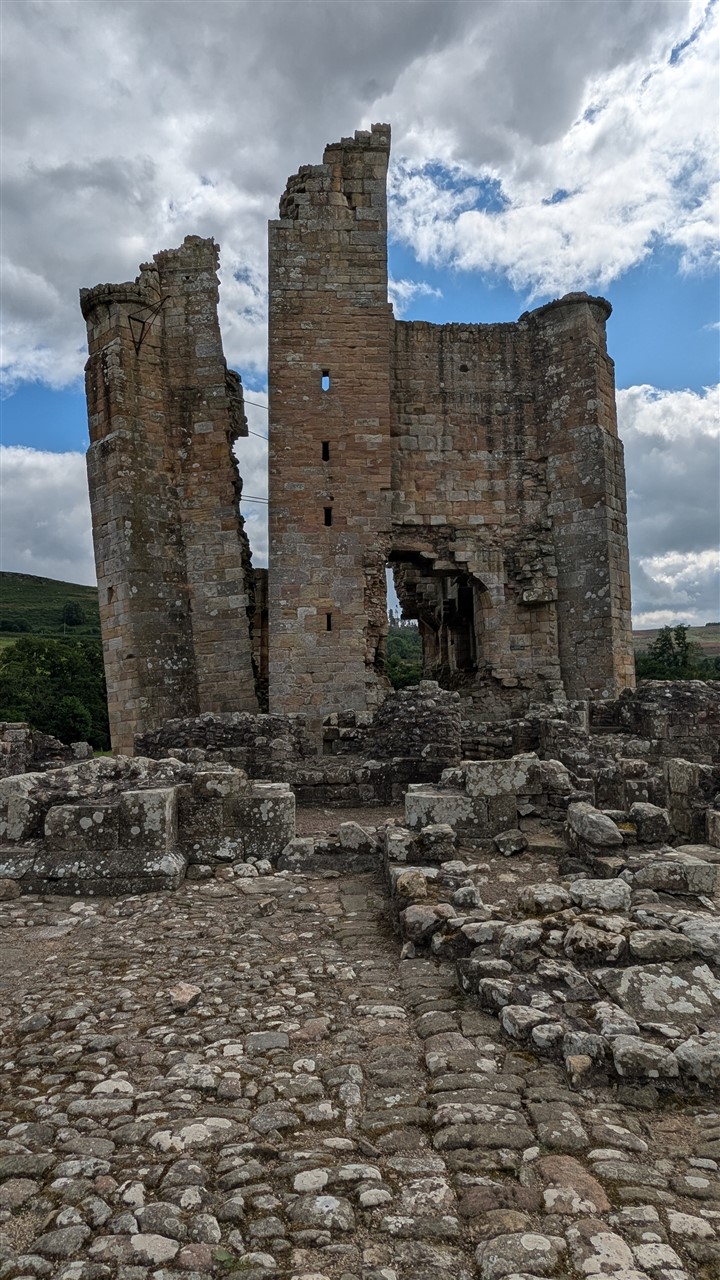
The leaning Tower of Edlingham
Etal was a little more impressive, having much of its wall still present as well as the gatehouse and main keep, albeit in gutted states.
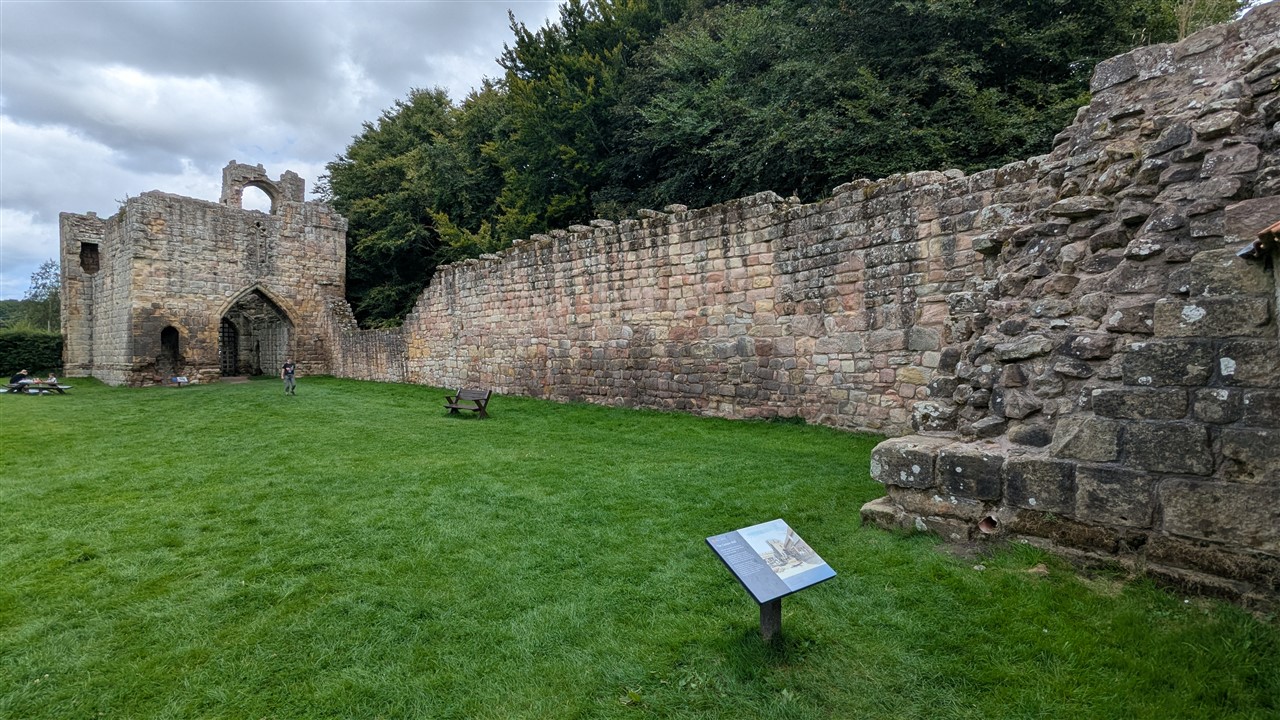
Etal's curtain wall is nearly intact, as is the gatehouse
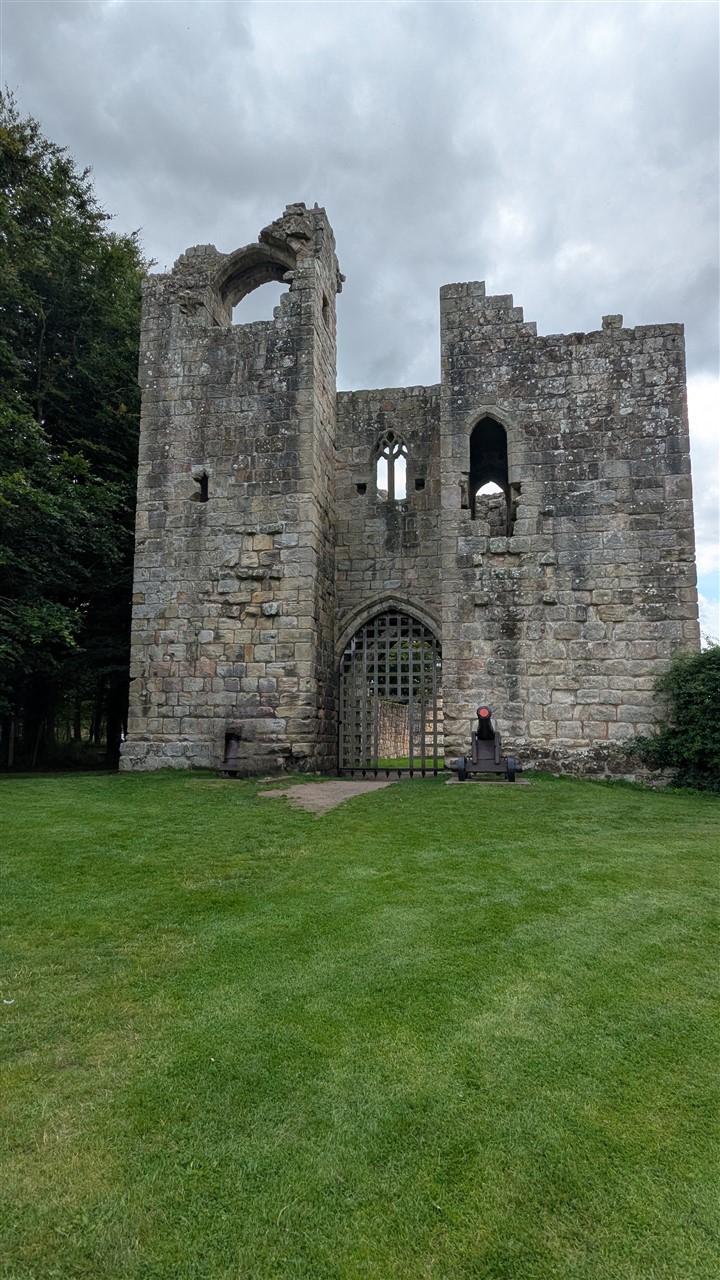
The view of the gatehouse from outside
There was also a Cidery on the site (there's a narrow gauge railway station nearby, too) and the village looks quite picturesque, on another day we may well have lunched in the local pub.
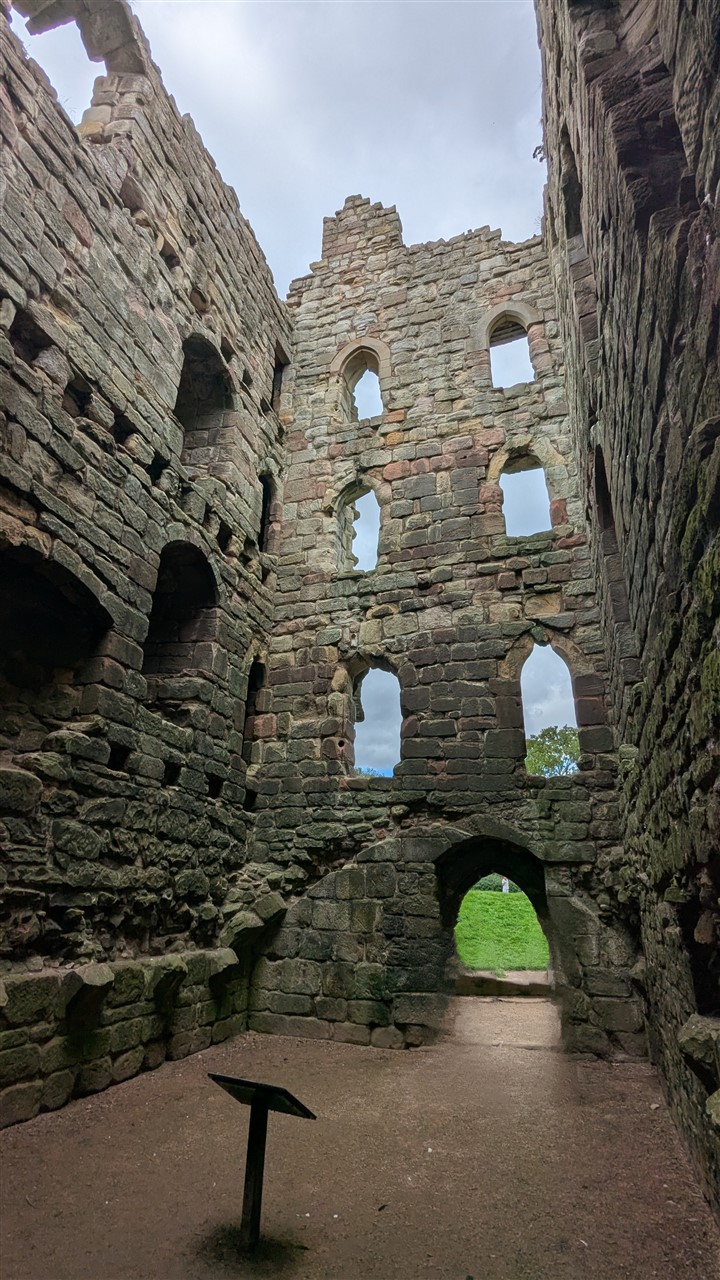
Interior of the Keep.
Our final stop proved a little disappointing as Norham Castle looks quite impressive, but is closed.
We found our way, unbarred, into the grounds and walked around a little, but it was quite clear that access to the ruin itself was not permitted, which was a shame.
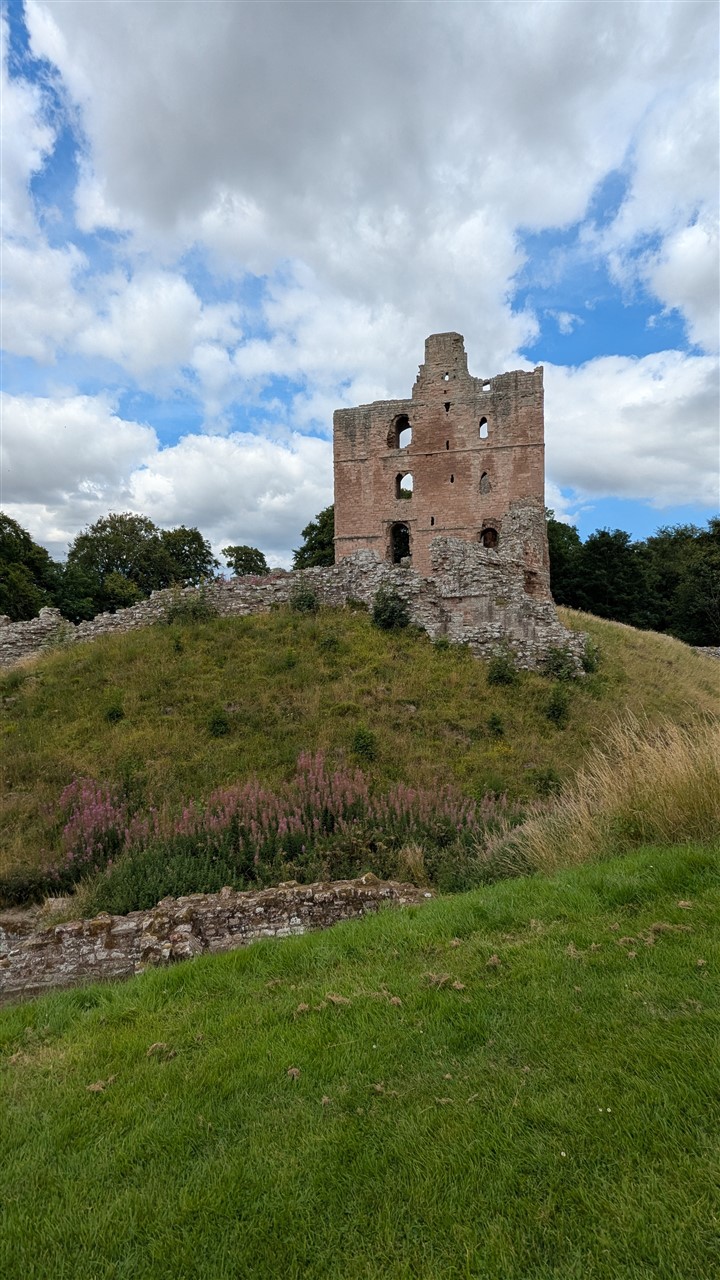
Norham was closed!
From Norham, it was only a few miles back to the big Tesco store on the edge of Berwick-Upon-Tweed (one advantage of staying self-catering in a big town is access to such places), where we filled the car with petrol for the journey home and bought some sandwiches to eat en-route.
After a cup of tea and a biscuit at home, Mandy suggested we follow a 'nature trail' along the river near to us, starting just below the railway station.
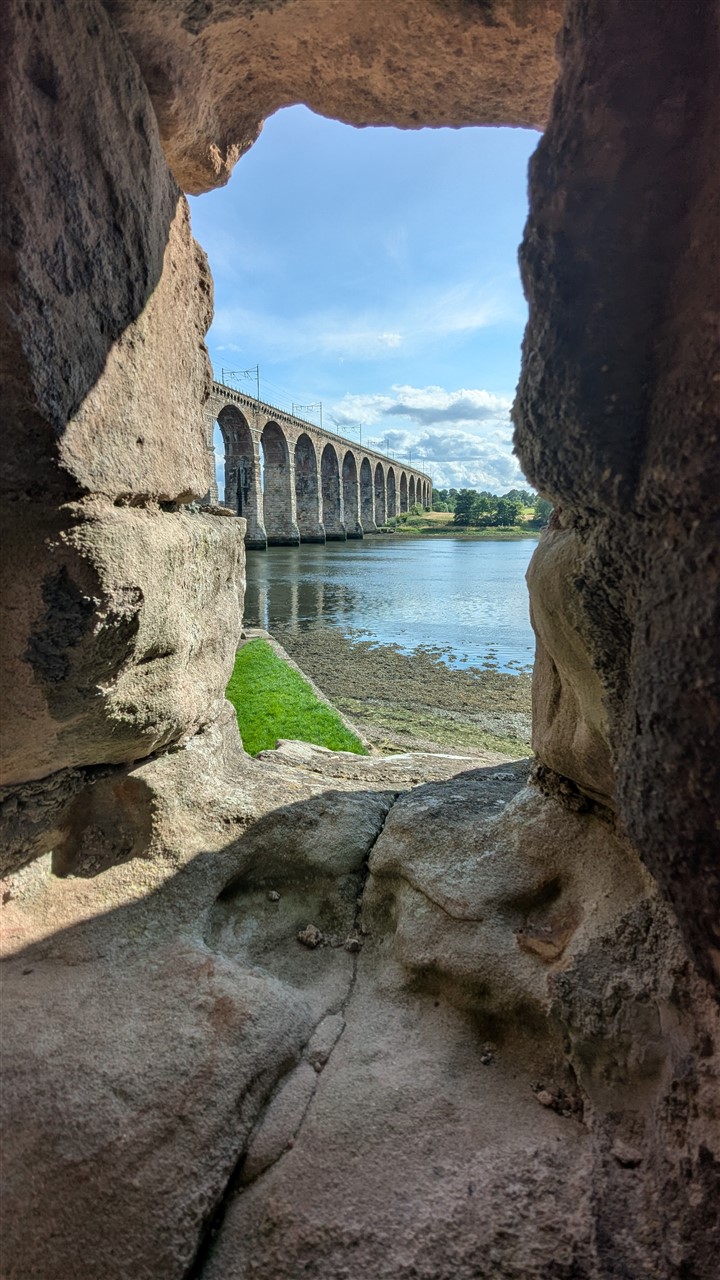
View of the viaduct from the small fortification by the river
While my knee was aching from quite a lot of walking (the result of a break skiing many years ago), it was a lovely early evening and the walk looked mostly flat, so we went.
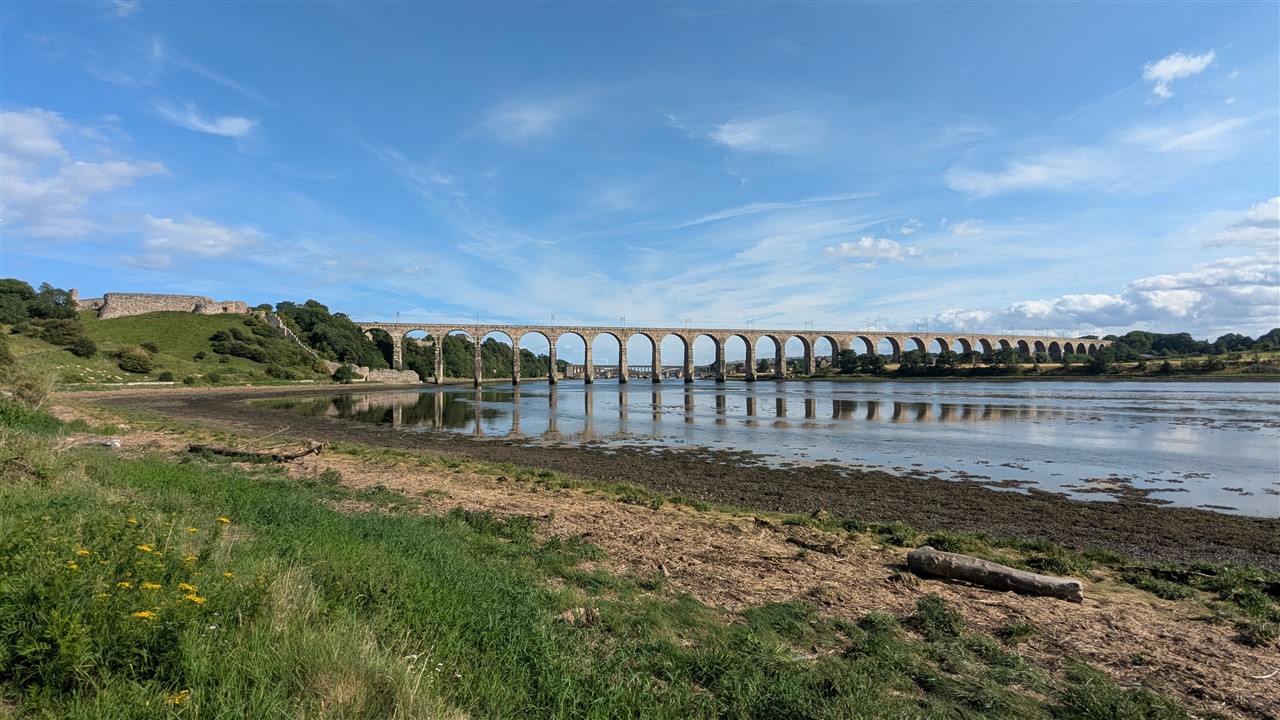
You can just make out all 3 bridges here
It turned out to be lovely stroll, taking in views of the viaduct (finally seeing trains crossing it - If only a steam train had passed!) and even providing us with views of the ruins of Berwick-Upon-Tweed's own castle, now much reduced.
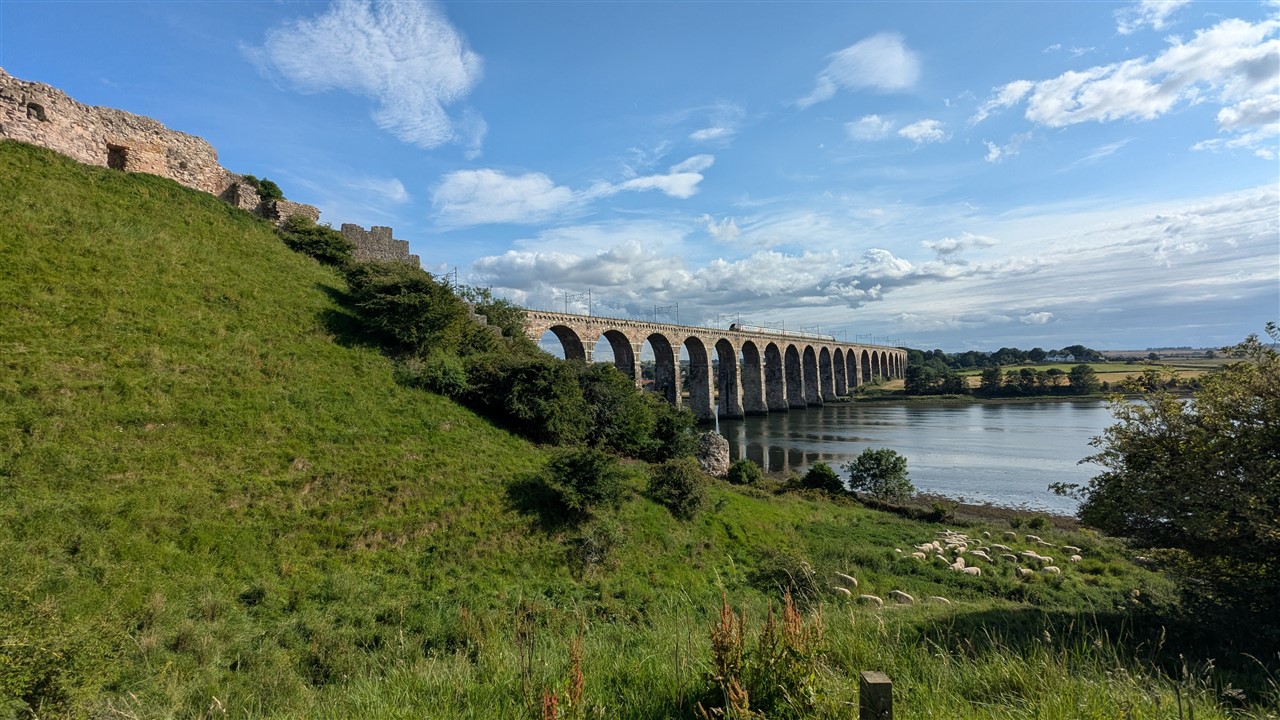
The castle, top left, and viaduct, complete with train
Summary
We had often talked of going to Northumberland and visiting Bamburgh Castle, so it was great to have finally done that, it didn't disappoint, but the area offered a lot more to see, plenty to fill a week.
We were, undoubtedly, lucky with the weather, the only rain we saw was on the Sunday (and I missed that, it seemed, by being underwater) and it was consistently warm, if a little overcast most days, brightening most evenings.
Berwick-Upon-Tweed itself seemed a pleasant town, if not exactly a tourist destination, but it and our accommodation proved a great base for exploring Northumberland and the border area.
Edinburgh is only an hour's drive away (we had a semi-plan to go there one day if we'd had rain, but having visited before, it wasn't high on the priorities) and I would have liked to have visited the Jim Clark Museum in Duns (very nearby) if we'd had more time, but I don't think Mandy would have enjoyed it much, so we never got there.
I think it's doubtful we'd return, there are too many places we'd still like to go, but we had enjoyed our stay and would recommend the area to anyone.
